inbox and environment news: Issue 565
December 4 - 10, 2022: Issue 565
Carp In Careel Creek
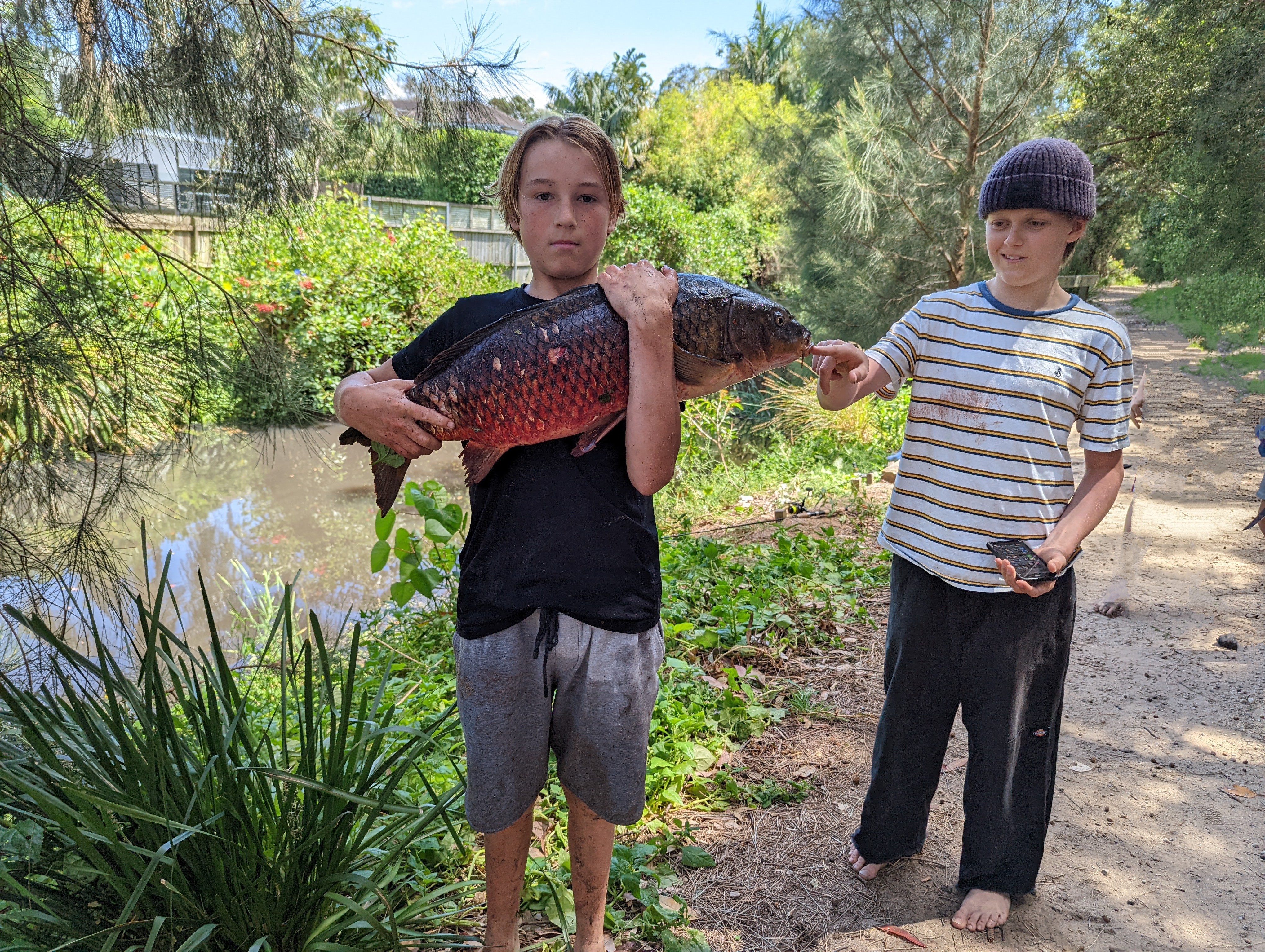
Help Guide Future Decisions For Manly Dam
The Council are calling for expressions of interest from the community to sit on the advisory committee that will guide decisions about how Manly Dam is managed over the next four years.
Officially known as the Manly Warringah War Memorial State Park, we’re seeking to appoint three community members to the Advisory Committee including:
- an environment representative
- a recreational representative
- a community representative.
Manly Dam is a popular spot for enjoying picnics, bushwalking, mountain biking, swimming, and water-skiing. Loved by locals and visitors, this dedicated war memorial and State Park is home to a wide variety of significant ecological communities and flora and fauna.
This is your opportunity to have your say on how this beautiful park is managed over the next four years.
The Manly Warringah War Memorial State Park Advisory Committee includes three community members, and representatives from Council and the NSW Government.
If you’re interested in a position, submit your expression of interest on the council website before 11 December 2022
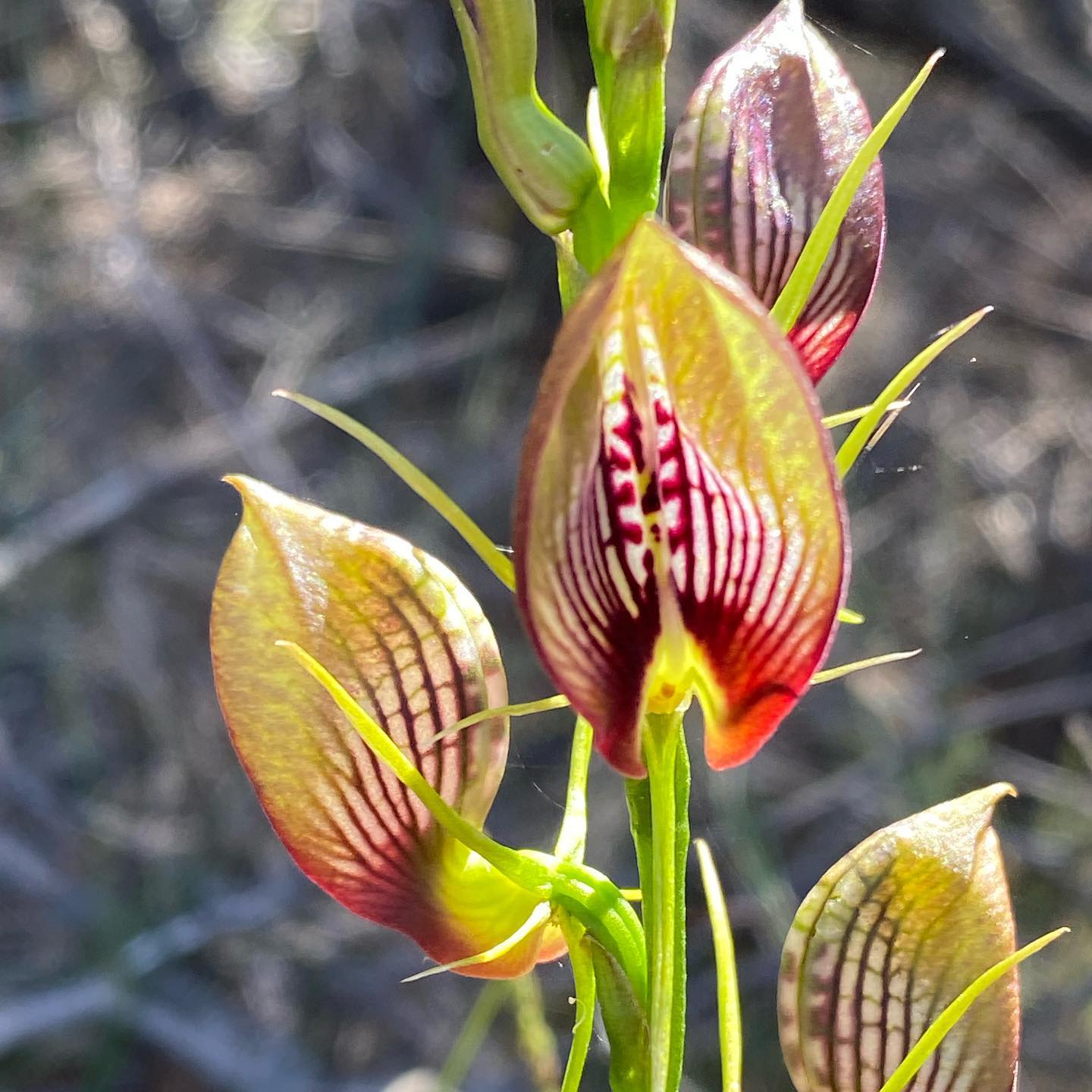
Orchid at Manly Dam. Photo: Selena Griffith
Gilead Stage 2 Development
''no longer required to assess impacts to ‘biodiversity values’ as these have already been addressed by the Minister and ‘conservation areas’ will be required to be managed in perpetuity for conservation''.
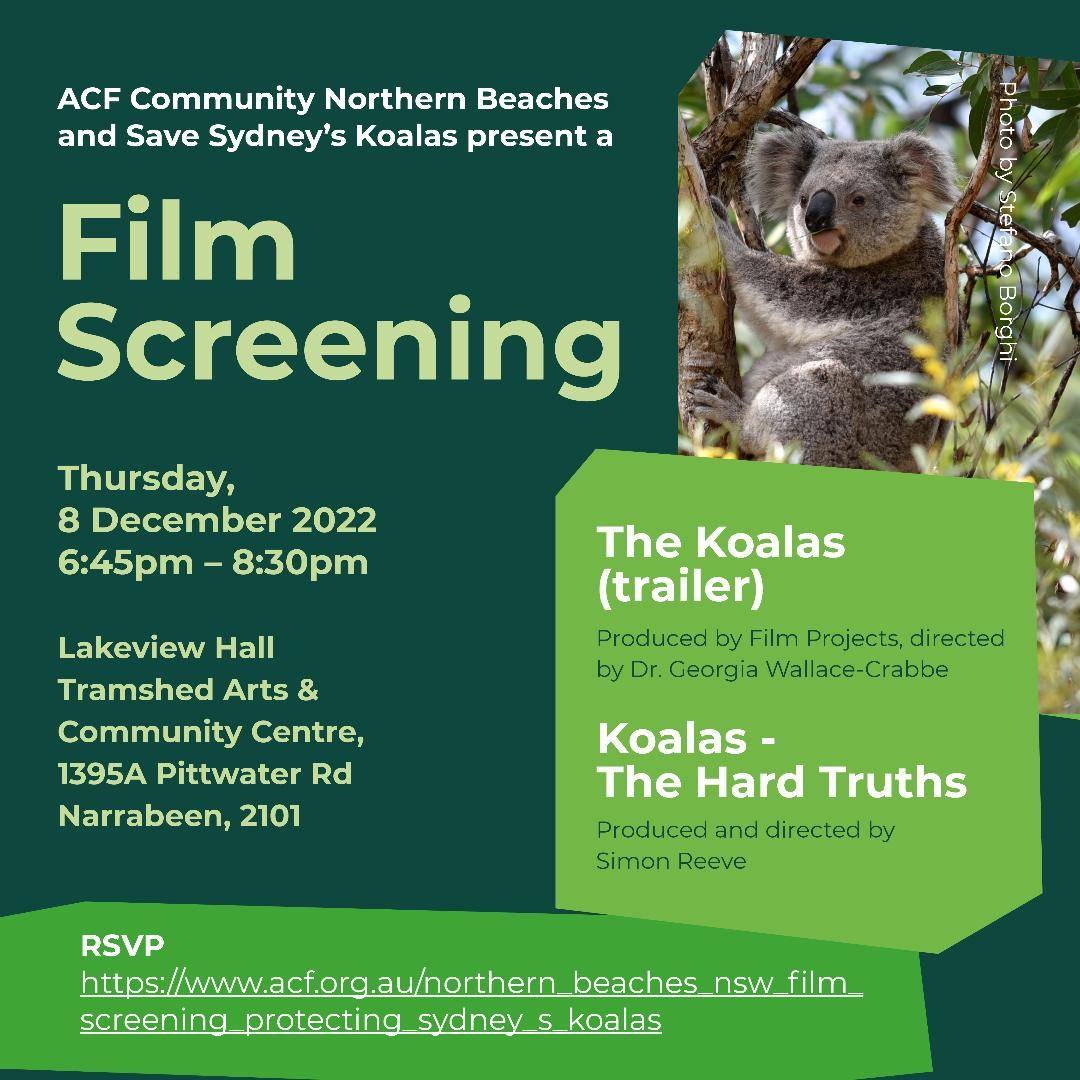
Help Needed To Save Sea Turtle Nests As Third La Nina Summer Looms
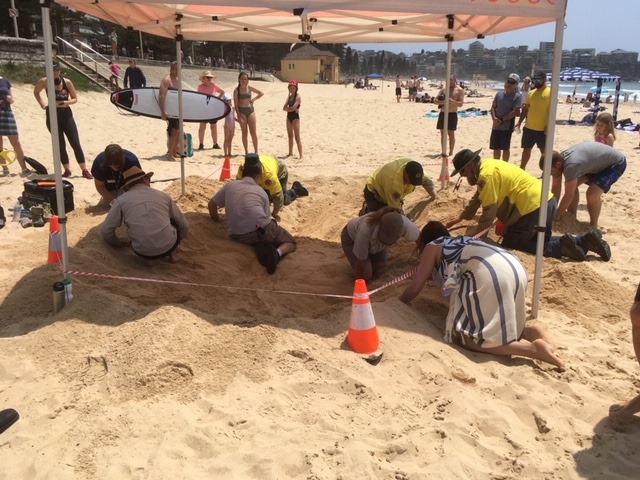

Watch Out - Shorebirds About
.JPG.opt1460x973o0,0s1460x973.jpg?timestamp=1663629195339)
Wanted: Photos Of Flies Feeding On Frogs (For Frog Conservation)

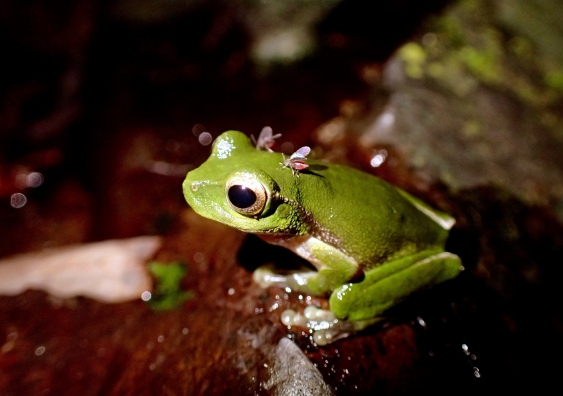
Possums In Your Roof?: Do The Right Thing

Local Wildlife Rescuers And Carers State That Ongoing Heavy Rains Are Tough For Us But Can Be Tougher For Our Wildlife:
- Birds and possums can be washed out of trees, or the tree comes down, nests can disintegrate or hollows fill with water
- Ground dwelling animals can be flooded out of their burrows or hiding places and they need to seek higher ground
- They are at risk crossing roads as people can't see them and sudden braking causes accidents
- The food may disappear - insects, seeds and pollens are washed away, nectar is diluted and animals can be starving
- They are vulnerable in open areas to predators, including our pets
- They can't dry out and may get hypothermia or pneumonia
- Animals may seek shelter in your home or garage.
You can help by:
- Keeping your pets indoors
- Assessing for wounds or parasites
- Putting out towels or shelters like boxes to provide a place to hide
- Drive to conditions and call a rescue group if you see an animal hit (or do a pouch check or get to a vet if you can stop)
- If you are concerned take a photo and talk to a rescue group or wildlife carer
There are 2 rescue groups in the Northern Beaches:
Sydney Wildlife: 9413 4300
WIRES: 1300 094 737
Please be patient as there could be a few enquiries regarding the wildlife.
Generally Sydney Wildlife do not recommend offering food but it may help in some cases. Please ensure you know what they generally eat and any offerings will not make them sick. You can read more on feeding wildlife here
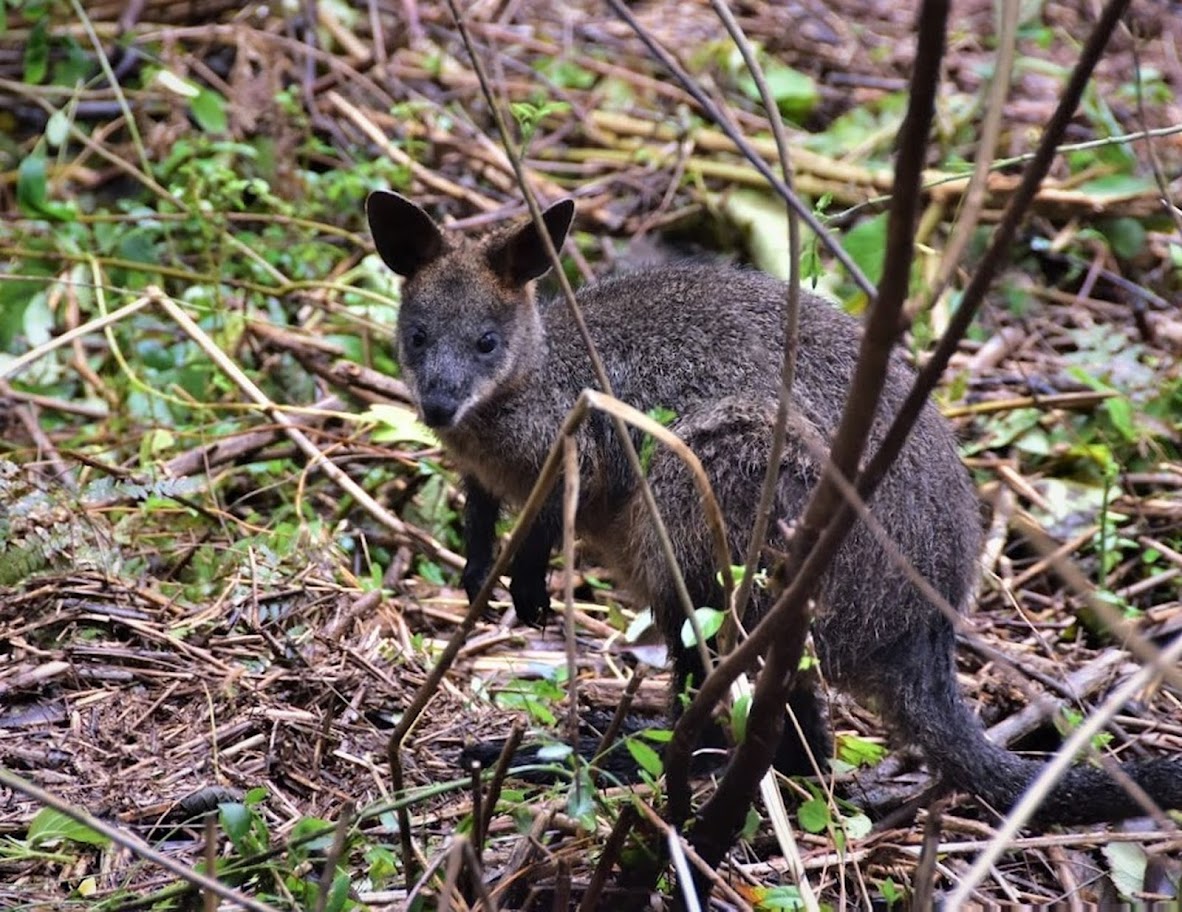
Information courtesy Ed Laginestra, Sydney Wildlife volunteer. Photo: Warriewood Wetlands Wallaby by Kevin Murray, March 2022.
Aviaries + Possum Release Sites Needed

Sydney Wildlife Rescue: Helpers Needed
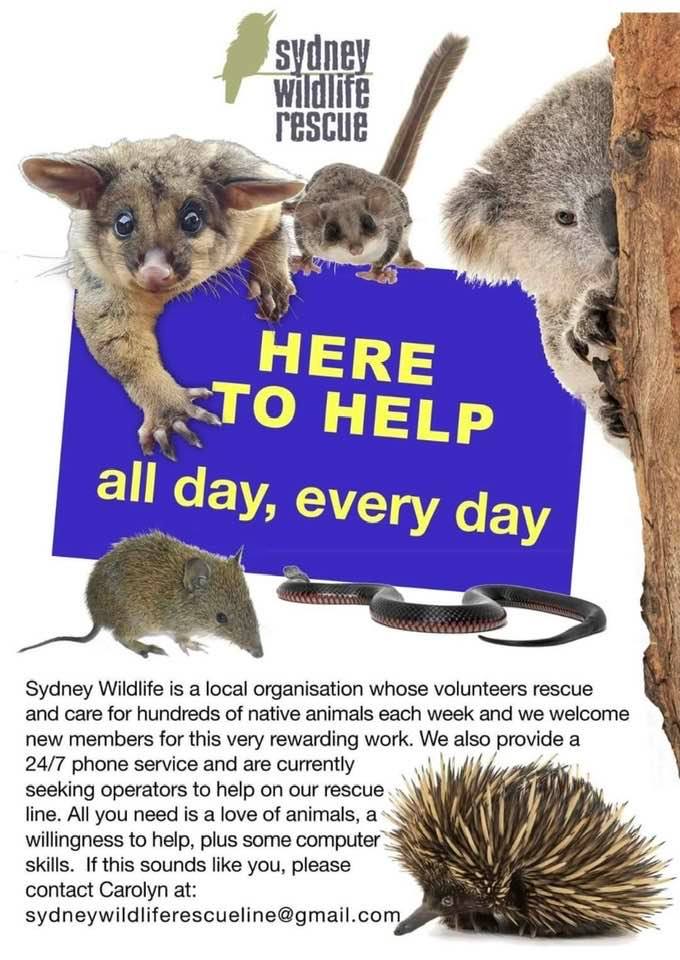
Bushcare In Pittwater
Where we work Which day What time
Avalon
Angophora Reserve 3rd Sunday 8:30 - 11:30am
Avalon Dunes 1st Sunday 8:30 - 11:30am
Avalon Golf Course 2nd Wednesday 3 - 5:30pm
Careel Creek 4th Saturday 8:30 - 11:30am
Toongari Reserve 3rd Saturday 9 - 12noon (8 - 11am in summer)
Bangalley Headland 2nd Sunday 9 to 12noon
Bayview
Winnererremy Bay 4th Sunday 9 to 12noon
Bilgola
North Bilgola Beach 3rd Monday 9 - 12noon
Algona Reserve 1st Saturday 9 - 12noon
Plateau Park 1st Friday 8:30 - 11:30am
Church Point
Browns Bay Reserve 1st Tuesday 9 - 12noon
McCarrs Creek Reserve Contact Bushcare Officer To be confirmed
Clareville
Old Wharf Reserve 3rd Saturday 8 - 11am
Elanora
Kundibah Reserve 4th Sunday 8:30 - 11:30am
Mona Vale
Mona Vale Beach Basin 1st Saturday 8 - 11am
Mona Vale Dunes 2nd Saturday +3rd Thursday 8:30 - 11:30am
Newport
Bungan Beach 4th Sunday 9 - 12noon
Crescent Reserve 3rd Sunday 9 - 12noon
North Newport Beach 4th Saturday 8:30 - 11:30am
Porter Reserve 2nd Saturday 8 - 11am
North Narrabeen
Irrawong Reserve 2nd Saturday 2 - 5pm
Palm Beach
North Palm Beach Dunes 3rd Saturday 9 - 12noon
Scotland Island
Catherine Park 2nd Sunday 10 - 12:30pm
Elizabeth Park 1st Saturday 9 - 12noon
Pathilda Reserve 3rd Saturday 9 - 12noon
Warriewood
Warriewood Wetlands 1st Sunday 8:30 - 11:30am
Whale Beach
Norma Park 1st Friday 9 - 12noon
Western Foreshores
Coopers Point, Elvina Bay 2nd Sunday 10 - 1pm
Rocky Point, Elvina Bay 1st Monday 9 - 12noon
Friends Of Narrabeen Lagoon Catchment Activities

Gardens And Environment Groups And Organisations In Pittwater
Magnetic Material Mops Up Microplastics In Water: RMIT


Mangroves: Environmental Guardians Of Our Coastline
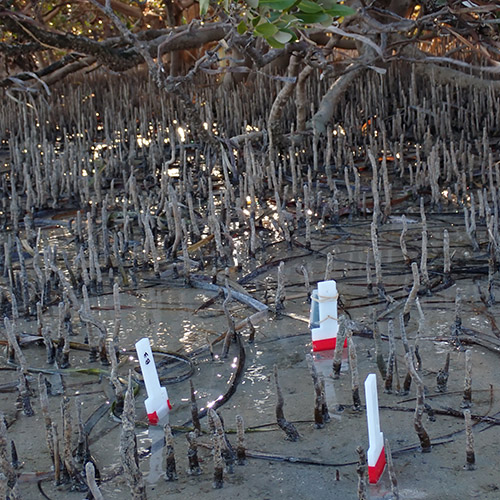
- Globally, mangrove forest, tidal marshes and seagrass meadows store more than 30,000 teragrams (or 30 trillion kilograms) of carbon across 185 million hectares, potentially reducing around three per cent of global carbon emissions.
- In 1992, an oil spill from the Era, at Port Bonython, released 300 tonnes of bunker fuel was released into Spencer Gulf, with a small slick of condensate getting into the mangroves south of Port Pirie. Mangroves do very badly in oil spills, and you can still see the scars of where the oil landed to this day.
Coastal property prices and climate risks are both soaring. We must pull our heads out of the sand
Tayanah O'Donnell, Australian National University and Eleanor Robson, Western Sydney UniversityAustralians’ well-documented affinity with the sun, surf and sand continues to fuel coastal property market growth. This growth defies rising interest rates and growing evidence of the impacts of climate change on people living in vulnerable coastal locations.
People in these areas are finding it harder to insure their properties against these risks. Insurers view the Australian market as sensitive to climate risks, as climate change impacts can trigger large insurance payouts. They are pricing their products accordingly.
Clearly, there is a vast disconnect between the coastal property market and climate change impacts such as increasingly severe storms, tidal surges, coastal erosion and flooding. There is no shortage of reports, studies and analyses confirming the climate risks we are already living with. Yet another alarming State of the Climate report was released last week.
We keep talking about reaching global net-zero emissions. But this “blah blah blah” masks the fact that climate impacts are already with us. Even if we make deeper, faster cuts to emissions, as we must, our world is now warmer. Australians will feel the effects of that warming.
We ultimately cannot afford the price of business as usual, as embodied by so many coastal developments.
Risks Are Worrying Banks And Insurers
In Australia, the disasters and the environmental collapse we are experiencing will get worse. While a range of businesses see this as opening up new market and product frontiers, the fact is climate change is creating a fundamentally uncertain, unstable and difficult world.
Banks have a central role in addressing climate risks. They are exposed to climate risk through residential lending on properties that are vulnerable to climate impacts and now face insurance pressures.
One in 25 Australian homes are projected to be uninsurable by 2030. The Australian government risks bearing the large costs of supporting the underinsured or uninsured – otherwise known as being “the insurer of last resort”.
This costly legacy shows why planning decisions made now must take account of climate change impacts, and not just in the wake of disasters.
The rapidly escalating impacts and risks across sectors demand that we undertake mitigation and adaptation at the same time, urgently and on a large scale. This means reducing emissions to negative levels – not just reaching net zero and transitioning our energy sector, but also actively removing greenhouse gases from the atmosphere.
We must also respond to climate change risks already locked into the system. We have to make substantial changes in how we think about, treat, price and act on these risks.
As The Climate Shifts, So Must Our Coastal Dream
The consequences of a warming climate, including reaching and crossing tipping points in the Earth’s weather systems, are occurring sooner than anticipated. The required behavioural, institutional and structural changes are vast and challenging.
People are often attached to places based on historical knowledge of them. These lived experiences, while important, inform a worldview based on an understanding of our environment before the rapid onset of climate change. This can skew our climate risk responses, but compounding climate impacts are outpacing our ability to adapt as we might have in the past.
Institutional signalling, such as warnings by the Reserve Bank, support greater public awareness of climate impacts and risks.
When buying a property, people need to consider these factors more seriously than, say, having an extra bathroom. Obligatory disclosure of regional climate change impacts could inform buyers’ decision-making. The data and models used would have to be clear on the validity and limitations of their scenarios.
Nature-Based And Equitable Solutions
In recent years there has been an increasing focus on nature-based solutions. This approach uses natural systems and tools for tackling societal issues such as the enormous and complex risks posed by climate change. Indeed, many Indigenous peoples, communities and ways of knowing have long recognised the fundamental role of nature in making good and safe lives possible for people.
Nature-based solutions provide a suite of valuable tools for remedying issues we’re already facing on coasts. For example, in many contexts, building hard seawalls is often a temporary solution, which instils a false sense of security. Planting soft barriers such as mangroves and dense, deep-rooting vegetation can provide a more enduring solution. It also restores fish habitat, purifies water and eases floods.
Acknowledging the well-being of people and nature as interconnected has important implications for decisions about relocating people from high-risk areas. Effective planned retreat strategies must not only get people out of harm’s way, but account for where they will move and how precious ecosystems will be protected as demand for land supply shifts. Nature-based solutions must be built into retreat policies too.
As the Australian Academy of Science’s Strategy for Just Adaptation explains, effective adaptation also embeds equity and justice in the process. Research on historic retreat strategies has shown that a failure to properly consider and respect people’s choices, resources and histories can further entrench inequities. Giving people moving to a new home as much choice as possible helps them work through an emotional and highly political process.
We all need to find the courage to have difficult conversations, to seek information to make prudent choices, and to do all we can to respond to the growing climate risks that confront us. As climate activist Greta Thunburg says:
“Hope is not passive. Hope is not blah blah blah. Hope is telling the truth. Hope is taking action. And hope always comes from the people.”
Acting on this kind of hope can put us on an altogether different and more positive path.![]()
Tayanah O'Donnell, Honorary Associate Professor, Australian National University and Eleanor Robson, PhD Candidate, Institute for Culture and Society, Western Sydney University
This article is republished from The Conversation under a Creative Commons license. Read the original article.
Many forests will become highly flammable for at least 30 extra days per year unless we cut emissions, research finds
Hamish Clarke, The University of Melbourne; Anne Griebel, Western Sydney University; Matthias Boer, Western Sydney University; Rachael Helene Nolan, Western Sydney University, and Víctor Resco de Dios, Universitat de LleidaWithout strong climate action, forests on every continent will be highly flammable for at least 30 extra days per year by the end of the century – and this fire threat is far greater for some forests including the Amazon, according to our new study.
Our research in Nature Communications looked at 20 years of global satellite data to test the link between wildfires and “vapour pressure deficit” – a measure of the atmosphere’s power to suck moisture out of living and dead plants. It can also be thought of as how “thirsty” the air is.
Our results show that forest fire becomes much more likely above a certain threshold of vapour pressure deficit in many regions. This threshold depends on the type of forest.
Alarmingly, climate change is increasing the number of days the planet passes these crucial thresholds. But by urgently bringing global emissions down, we can minimise the number of extra wildfire days.

How A Forest Becomes Flammable
Wildfire is an ancient, highly diverse phenomenon. Four key conditions for a fire are:
fuel: the leaves, branches, twigs and everything else that can catch alight in a forest
fuel moisture: whether fuel is dry enough to burn
ignition: the spark to set things off, such as a lightning strike
weather: conditions such as strong winds and high temperatures, which can aid a fire’s spread.
These four processes act as switches. All must be in the “on” position for a fire to take hold.
The drying out of fuel is particularly crucial for making a forest dangerously flammable. Indeed, many researchers are finding links between vapour pressure deficit (VPD) and fire activity.

VPD describes the difference between how much moisture is in the air and how much moisture the air can hold when it’s saturated. Once air becomes saturated, water will condense to form clouds or dew on leaves.
Importantly, warmer air can hold more water, which means VPD increases. We refer to the air being “thirsty” when the gap between full and empty air becomes bigger, meaning there’s a greater demand (thirst) for the water to come out of living and dead plant material, drying it out.
This is a serious issue as climate change leads to rising global temperatures.
Climate Change And Fire Days
We analysed more than 30 million satellite records and a global climate dataset to find the maximum daily VPD, for each time and place a fire was detected.
We then measured the strength of the relationship between VPD and fire activity for different forest types in each continent. And we showed, for the first time, that in many forests there is a strong link between fire activity and VPD on any given day.
Our results show certain VPD thresholds beyond which forest fire becomes more likely than not.
For example, in boreal forests (predominantly northern European and American coniferous forests), this threshold is 0.7-1.4 kilopascals (a unit of pressure). In subtropical and tropical forests such as the Amazon, the threshold rises dramatically to 1.5-4.0 kilopascals. This means the air must be a lot thirstier to spark fire in the tropical forests of Borneo and Sumatra than in the spruce, pine and larch of Canada.
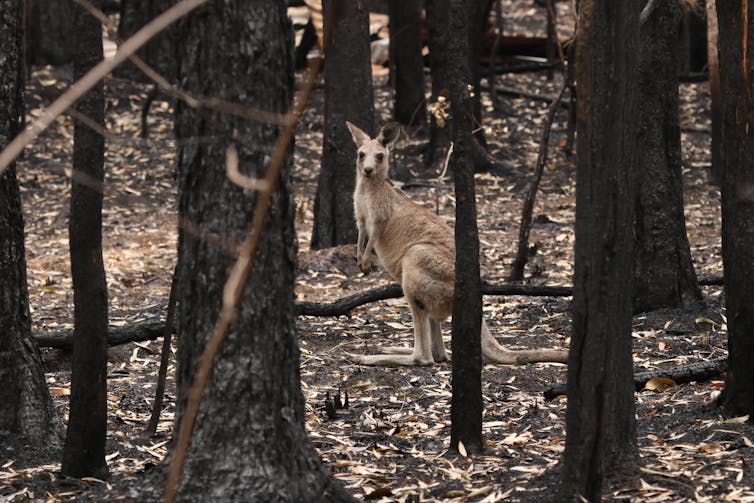
We looked at both low- and high-emissions scenarios and found the risks are much greater if we fail to curb emissions.
If humanity continues to release greenhouse gas emissions unabated, the planet is expected to warm by around 3.7℃ by the end of the century. Under this high-emissions scenario, our study finds there are forests on every continent that will experience at least 30 extra days per year above critical flammability thresholds.
Under a lower-emissions scenario where global warming is limited to around 1.8℃, each continent will still see at least an extra 15 days per year crossing the threshold.
Parts of tropical South America including the Amazon will see the greatest increases in both scenarios by the end of the century: at least 90 additional days in a low-emissions scenario, and at least 150 extra days in a high-emissions scenario.
What Are The Risks?
Increasing forest fires will have serious consequences. This includes potentially destabilising patterns of fire and regrowth and disrupting the carbon storage we rely on forests for. Indeed, research last year showed the role of the Amazon rainforest as a “carbon sink” (which absorbs more CO₂ that it releases) may already be in decline.
We can also expect increasing harms to human health from wildfire smoke. It is estimated that around the world, more than 330,000 people die each year from smoke inhalation. This number could increase notably by the turn of the century, particularly in the most populated areas of South Asia and East Africa.
Our next research project will explore the links between fire, VPD and climate change in more detail in Australia, our home country. We’re also interested in the forests and regions where VPD doesn’t seem to be the main driver of fire, such as in Japan and Scandinavia.
Our discovery of reliable links between atmospheric dryness and forest fire risk in many regions means we can now develop better fire predictions, at both seasonal and near-term scales. This could bring significant benefits to those on the frontlines of fighting, managing and coexisting with wildfire.
The authors gratefully acknowledge the contributions of Shiva Khanal from Western Sydney University to this article.![]()
Hamish Clarke, Senior Research Fellow, The University of Melbourne; Anne Griebel, Postdoctoral Research Fellow, Western Sydney University; Matthias Boer, Professor, Hawkesbury Institute for the Environment, Western Sydney University; Rachael Helene Nolan, Senior research fellow, Western Sydney University, and Víctor Resco de Dios, Profesor de ingeniería forestal y cambio global, Universitat de Lleida
This article is republished from The Conversation under a Creative Commons license. Read the original article.
We all know the Great Barrier Reef is in danger – the UN has just confirmed it. Again
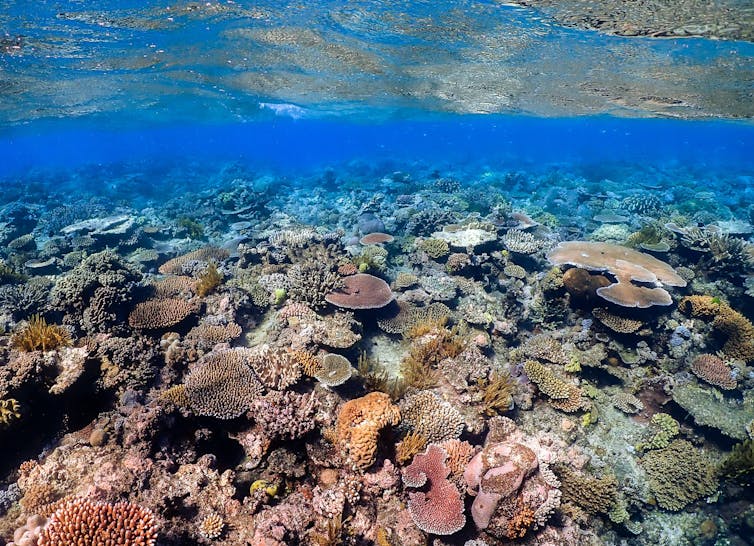
You might be forgiven for thinking it’s Groundhog Day reading headlines about the Great Barrier Reef potentially being listed on the World Heritage “in danger” list. After all, there have been similar calls in 2012, 2013, 2014 and 2017.
Successive federal governments have lobbied hard to keep the largest coral reef in the world off the high-profile list kept by the United Nations Educational, Scientific and Cultural Organization (UNESCO).
Only last year, former environment minister Sussan Ley jetted around the world in a successful effort to stave off the inevitable, pointing to hundreds of millions of dollars spent on issues such as water quality. The new minister, Tanya Plibersek, also wants to avoid having the reef “singled out” in this way.
The question is, what does in-danger mean? Everyone knows the reef is in trouble. An in-danger listing is not a sanction or punishment. Rather, it’s a call to the international community that a World Heritage property is under threat, requiring actions to protect it for future generations. In-danger listing is not permanent, nor does it mean the Reef will be permanently removed from the World Heritage list.
The reef faces a multitude of threats. The most significant threats are coral bleaching worsened by climate change, poor water quality from land-based runoff, and unsustainable fishing and coastal development. We already have regulations to tackle many of them – but we need more effective enforcement to ensure compliance.
What Just Happened?
The Great Barrier Reef has been World Heritage listed since 1981. This means it’s considered an area of outstanding value to humanity. Covering an area the size of Italy, this iconic area includes some 3,000 separate reefs, over 1,000 islands and a variety of other significant habitats.
The latest UN mission has just reported back, finding the reef’s condition is worsening and recommending it be listed as “in danger”. It also offered practical solutions.
Previous governments have fought to ensure the reef is not listed as in-danger despite their own five-yearly reviews demonstrating an obvious decline. In 2009, the reef’s condition was rated poor and declining. In 2014 it was poor and declining and in 2019, very poor and declining.
So the government knows the reef is in danger. We know, and the tourism industry knows. While some tourism operators worry about their business, the opposite appears to be true: more people go, thinking it might be their last chance to see it. And already, operators are adapting by taking tourists to areas still in good condition.
Federal governments just don’t want the reef on the list because of the hit to their international reputation – and to their domestic standing.
If the reef is officially listed as “in danger” next year, it will draw a much greater focus to the reef’s plight. And that may help galvanise effective national and global action.
Take the case of the famous coral reefs of Belize in Central America. When these reefs were listed, the government banned nearby oil exploration and protected mangroves. Belize’s reefs have now been taken off the in-danger list.
So What Has To Be Done?
The mission’s report lays out what needs to be done for the major issues.
Australia already has a long-term plan aimed at ensuring the reef’s sustainability. There are regulations governing, say, sediment and water quality in run off from agriculture and towns. We have some targets too, particularly around water quality.
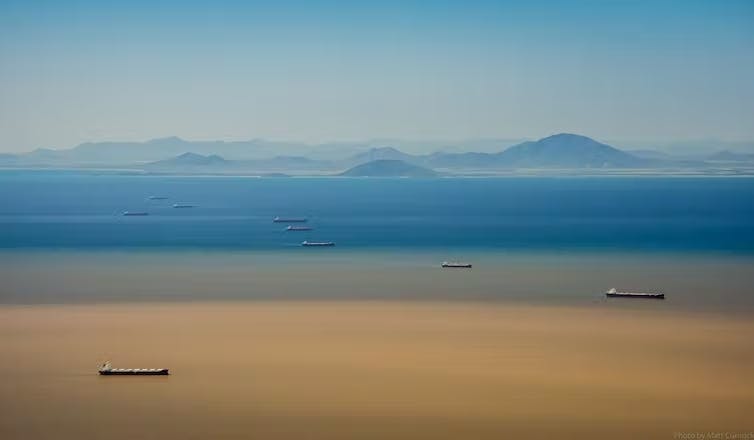
The problem is delivery. There is a need to scale up efforts and improve compliance. Regulations mean very little if there’s ineffective enforcement. For example, while most farmers have taken on board the rules around fertiliser use, erosion and run-off, those flouting the rules get only a slap on the wrist. As the state government notes, enforcement is a “last resort”.
The UN mission has called on Australia to improve in four key areas:
1. Look after land and water
When native vegetation is cleared, it makes erosion more likely. Eroded soils are washed downstream and out to sea, where they can settle on coral and seagrass, smothering them. In Queensland, native vegetation is still being cleared at unsustainable levels.
2. Phase out gillnets
These long nets catch fish by their gills. But they also catch dugongs, dolphins and turtles, which then die. The UN mission made a very strong recommendation: phase out gillnets in the marine park.
3. More effective disposal of dredge spoil
Dredging shipping channels and ports produces a lot of silt and sand. If this is dumped in shallow areas, it can also spread to nearby corals and seagrass beds already under stress from climate change. A previous government policy ended the dumping of capital dredge spoil (dredging previously undisturbed areas). But maintenance dredge spoil is still being dumped at sea or used for reclamation, both causing adverse impacts.
4. Tackle climate change
This month, the northern reefs are sweltering in record water temperatures – raising the chance of further bleaching events. The UN report makes it clear that climate change is the biggest threat. Climate change heats up tropical waters, causing coral bleaching and potentially coral death. Australia, as one of the world’s top exporters of fossil fuels gas and coal, has long tried to go slow on climate action. The new government has moved to legislate a stronger 2030 emissions reduction target, but the UN report calls for even more ambition to keep warming under 1.5℃ as this is widely accepted as the critical threshold for reef survival.
The report doesn’t make reference to the impacts of shipping on nearby coral and seagrass areas, such as sediment churned up by propellers of large ships and tankers.
Death By A Thousand Cuts
If you dive the reef for the first time this year, you might wonder if there really is a problem. After all, there are still fish and coral. When I first dove on the reef more than 35 years ago, it was in much better condition. What you see now may seem okay – but it’s a pale shadow of what it could or should be. It’s death by a thousand cuts.
As reef expert Professor Ove Hoegh-Guldberg has said:
The reef is in dire trouble, but it’s decades away before it’s no longer worth visiting. That’s the truth. But unless we wake up and deal with climate change sincerely and deeply then we really will have a Great Barrier Reef not worth visiting.
We’re never going to restore the reef to its pre-European conditions. But unless we take real action, future generations will wonder how and why we failed them so badly. We don’t need to wait for the World Heritage Committee to make in-danger listing to know the reef is in real trouble. ![]()
Jon C. Day, PSM, Adjunct Senior Research Fellow, ARC Centre of Excellence for Coral Reef Studies, James Cook University
This article is republished from The Conversation under a Creative Commons license. Read the original article.
COP27 was disappointing, but 2022 remains an historic year for international climate policy
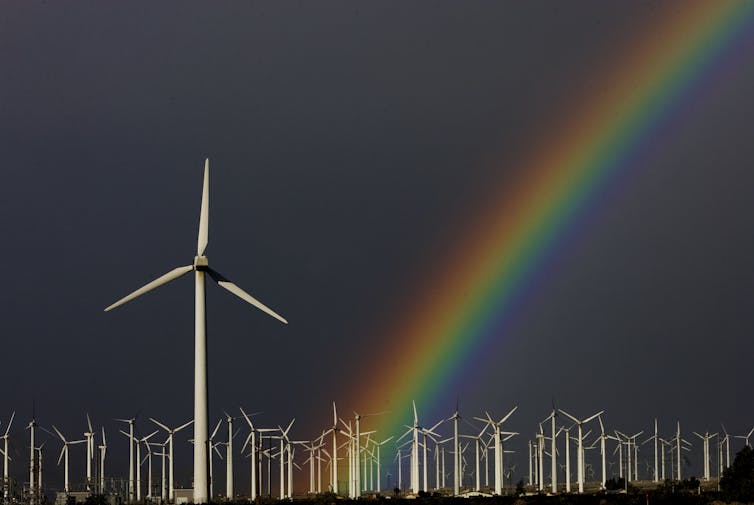
This year’s global climate negotiations at the COP27 in Egypt were disappointing. In particular, the international commitment to limit planetary warming to 1.5℃ remains on “life support”.
But hope is not lost. In fact, 2022 was an historic year for international climate policy. It marked a shift in how the world’s biggest greenhouse gas emitters – China, the United States, the European Union and India – deal with climate change when faced with economic and energy shocks.
In the past, climate action has been pushed to the back-burner when governments devise policy responses to global crises. But this year, amid Russia’s war on Ukraine, spiralling inflation and energy shortages, tackling climate change has been central to recovery plans.
It signals climate action and economic stability are no longer seen as competing priorities – instead, national governments realise they go hand-in-hand. As European Commission President Ursula von der Leyen has noted, this represents a major turning point in global climate policy and a “leap into the future”.

A Global Turning Point
Russia’s illegal war on Ukraine has destabilised the global energy market and caused sharp rises in food and commodity prices, worsening global inflation.
In the past, such shocks would have prompted governments to enact a fairly blinkered policy response.
During the 1970s global oil crisis, for example, governments brought in massive fossil fuel subsidies and eased environmental rules for the petroleum industry, rather than reduce oil dependency.
In the aftermath of the global financial crisis in 2008, government responses were often similarly short-sighted. Low-interest loans to banks and other institutions, for example, perpetuated a business-as-usual economic system of high emissions.
This was coupled with years of austerity which derailed funding and investment for climate action.
Hearteningly, 2022 has seen a very different approach.
The United States, European Union, China and India have all prioritised climate change in their response to global economic crises, as I outline below.
Why? Public support for climate action is ever-growing and climate-related disasters are becoming worse. What’s more, renewable energy costs continue to fall, and energy security and global competitiveness remain big concerns.
The EU And US Step Up
In the immediate aftermath of Russia’s invasion of Ukraine, the EU made a “dash for gas” to replace Russian supply. Germany made deals to purchase gas from African countries, Australia, the US and Middle East, triggering fears climate action would be delayed.
But the EU has since made climate change action a central priority. Its RePowerEU plan, released in May, presents clean energy as the solution to the so-called energy trilemma of costs, security and environmental sustainability.

Among other measures, the plan involves:
- ramped-up targets for renewable energy and energy efficiency
- substantial home and business electrification measures including electric vehicles and heat pumps
- ambitious targets for green hydrogen.
The plan intends to eliminate reliance on Russian gas by 2027 and almost halve overall gas use by 2030.
The US took similar action this year. Its historic Inflation Reduction Act puts clean energy investment at the forefront of plans to address the cost-of-living crisis.
At least US$369 billion will be spent on clean energy initiatives to reduce energy bills. Clean energy will be embedded in measures across the economy through tax incentives, subsidies and grants. The investment prompted one observer to predict “the climate economy is about to explode”.
By aligning climate change with economic policy, the government has shifted the business narrative from risk to opportunity.
This month the Biden administration went further, with a proposal for major government suppliers to disclose greenhouse gas emissions and set science-based emissions reduction targets. Climate change is also being considered in US pension plans and company reporting requirements.
By embedding climate change in existing systems, trillions of dollars will shift into clean energy. This is likely to change the US economy forever and accelerate emissions reduction.

Progress In China And India
So what about the developing economies of China and India?
In China, coal use increased in the short-term over winter this year. However, China’s government has released plans for specific sectors coupling economic and energy security, and low-carbon growth.
In July, the government released an emissions reduction blueprint for urbanisation and rural development. It includes ambitious measures to increase the energy efficiency of buildings, electrify buildings and transport (including huge deployment of electric vehicle charging stations) and mandate rooftop solar on new factories and public buildings.
The government has also worked closely with provincial governments on targets to more than double the installed capacity of wind and solar by 2025.
In India, a National Electricity Plan released by the central government this year has clean energy at its core. It means renewables capacity is set to soar by 250% over the next decade.
India’s government has also introduced policies to favour electrification in buildings and transport – a departure from a previous policy in which gas played a significant role in future energy supply.

Change Is Afoot
Analysis suggests the systemic changes outlined above could mean the EU, China and India exceed their current commitments under the Paris Agreement.
This is good news – but the world still has a long way to go. Climate action must be embedded deeply in the government policies of all nations, as well as in existing economic and energy systems. This is no small task – but it’s necessary to achieve the transformation required to address the climate crisis.
Of course, 2022 was also a big year for climate action in Australia. The Albanese Labor government was elected in May, and has set about implementing a climate action agenda far stronger than that of the previous Coalition government.
Australia still lags behind other comparable nations. But recent developments in the EU and US offer lessons on the way forward.![]()
Katherine Lake, Research Associate at the Centre for Resources, Energy and Environmental Law, The University of Melbourne
This article is republished from The Conversation under a Creative Commons license. Read the original article.
‘This case has made legal history’: young Australians just won a human rights case against an enormous coal mine
Justine Bell-James, The University of QueenslandIn a historic ruling today, a Queensland court has said the massive Clive Palmer-owned Galilee Basin coal project should not go ahead because of its contribution to climate change, its environmental impacts, and because it would erode human rights.
The case was mounted in 2020 by a First Nations-led group of young people aged 13 to 30 called Youth Verdict. It was the first time human rights arguments were used in a climate change case in Australia.
The link between human rights and climate change is being increasingly recognised overseas. In September this year, for example, a United Nations committee decided that by failing to adequately address the climate crisis, Australia’s Coalition government violated the human rights of Torres Strait Islanders.
Youth Verdict’s success today builds on this momentum. It heralds a new era for climate change cases in Australia by youth activists, who have been frustrated with the absence of meaningful federal government policy.
1.58 Billion Tonnes Of Emissions
The Waratah Coal mine operation proposes to extract up to 40 million tonnes of coal from the Galilee Basin each year, over the next 25 years. This would produce 1.58 billion tonnes of carbon emissions, and is four times more coal extraction than Adani’s operation.
While the project has already received approval at the federal government level, it also needs a state government mining lease and environmental authority to go ahead. Today, Queensland land court President Fleur Kingham has recommended to the state government that both entitlements be refused.
In making this recommendation, Kingham reflected on how the global landscape has changed since the Paris Agreement in 2015, and since the last major challenge to a mine in Queensland in 2016: Adani’s Carmichael mine.
She drew a clear link between the mining of this coal, its ultimate burning by a third party overseas, and the project’s material contribution to global emissions. She concluded that the project poses “unacceptable” climate change risks to people and property in Queensland.
The Queensland Human Rights Act requires a decision-maker to weigh up whether there is any justifiable reason for limiting a human right, which could incorporate a consideration of new jobs. Kingham decided the importance of preserving the human rights outweighed the potential A$2.5 billion of economic benefits of the proposed mine.
From a legal perspective, I believe there are four reasons in particular this case is so significant.
1. Rejecting An Entrenched Assumption
A major barrier to climate change litigation in Queensland has been the “market substitution assumption”, also known as the “perfect substitution argument”. This is the assertion that a particular mine’s contribution to climate change is net zero, because if that mine doesn’t supply coal, then another will.
Kingham rejected this argument. She noted that the economic benefits of the proposed project are uncertain with long-term global demand for thermal coal set to decline. She observed that there’s a real prospect the mine might not be viable for its projected life, rebutting the market substitution assumption.
This is an enormous victory for environmental litigants as this was a previously entrenched argument in Australia’s legal system and policy debate.
2. Evidence From First Nations People
It was also the first time the court took on-Country evidence from First Nations people in accordance with their traditional protocols. Kingham and legal counsel travelled to Gimuy (around Cairns) and Traditional Owners showed how climate change has directly harmed their Country.
As Youth Verdict co-director and First Nations lead Murrawah Johnson put it:
We are taking this case against Clive Palmer’s Waratah Coal mine because climate change threatens all of our futures. For First Nations peoples, climate change is taking away our connection to Country and robbing us of our cultures which are grounded in our relationship to our homelands.
Climate change will prevent us from educating our young people in their responsibilities to protect Country and deny them their birth rights to their cultures, law, lands and waters.
This decision reflects the court’s deep engagement with First Nations’ arguments, in considering the impacts of climate change on First Nations people.
3. The Human Rights Implications
In yet another Australian first, the court heard submissions on the human rights implications of the mine.
The Land Court of Queensland has a unique jurisdiction in these matters, because it makes a recommendation, rather than a final judgment. This recommendation must be taken into account by the final decision-makers – in this case, the Queensland resources minister, and the state Department of Environment and Science.
In an earlier proceeding, Kingham found the land court itself is subject to obligations under Queensland’s Human Rights Act. This means she must properly consider whether a decision to approve the mine would limit human rights and if so, whether limits to those human rights can be demonstrably justified.
Kingham found approving the mine would contribute to climate change impacts, which would limit:
- the right to life
- the cultural rights of First Nations peoples
- the rights of children
- the right to property and to privacy and home
- the right to enjoy human rights equally.
Internationally, there are clear links made between climate change and human rights. For example, climate change is worsening heatwaves, risking a greater number of deaths, thereby affecting the right to life.
4. A Victory For A Nature Refuge
Kingham also considered the environmental impacts of the proposed mine on the Bimblebox Nature Refuge – 8,000 hectares semi-arid woodland, home to a recorded 176 bird species, in the Galilee Basin.
She deemed these impacts unacceptable, as “the ecological values of Bimblebox [could be] seriously and possibly irreversibly damaged”.
She also observed that the costs of climate change to people in Queensland have not been fully accounted for, nor have the costs of mining on the Bimblebox Nature Refuge. Further, she found the mine would violate Bimblebox Alliance’s right to family and home.
Making History
This case has made legal history. It is the first time a Queensland court has recommended refusal of a coal mine on climate change grounds, and the first case linking human rights and climate change in Australia. As Kingham concluded:
Approving the application would risk disproportionate burdens for future generations, which does not give effect to the goal of intergenerational equity.
The future of the project remains unclear. But in a year marked by climate-related disasters, the land court’s decision offers a ray of hope that Queensland may start to leave coal in the ground.![]()
Justine Bell-James, Associate Professor, TC Beirne School of Law, The University of Queensland
This article is republished from The Conversation under a Creative Commons license. Read the original article.
Victoria faces a grave climate and energy crisis. The new government’s policies must be far bolder
Ariel Liebman, Monash UniversityThe Andrews Labor government has been returned in Victoria. It must now reckon with two particularly crucial challenges: runaway climate change and wartime-scale energy costs.
Victorians are still reeling from rare major flooding in which the state’s largest dam, Dartmouth, spilled over. Meanwhile, electricity prices in Victoria are rising dramatically.
The Andrews government has signalled a major shakeup of Victoria’s energy sector. Its pre-election commitments – a 95% renewable electricity target by 2035 and net-zero emissions by 2045 – are definite moves in the right direction.
And plans to reinstate the State Electricity Commission, including a constitutional amendment to cement this change permanently, speaks to the government’s intention to regain control of the electricity market and skyrocketing energy prices.
These are significant pledges and daunting tasks to accomplish. But the Victorian government must go further to secure the energy sector and take stronger climate action.
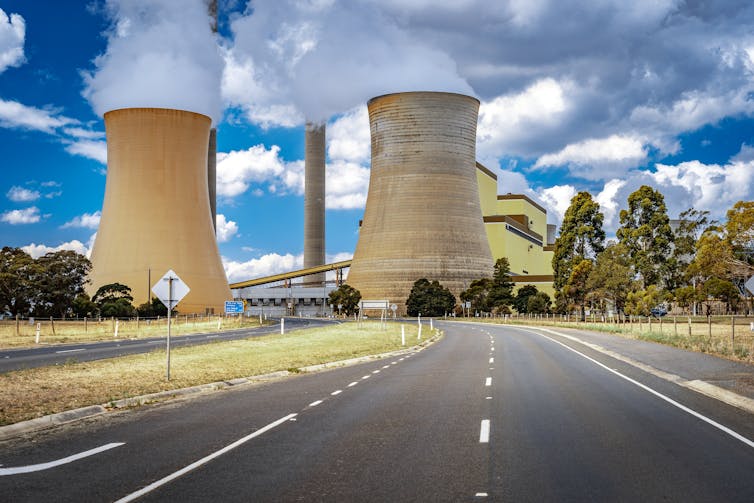
Reducing Energy Costs
Today’s high energy costs are driven primarily by fossil fuel supply constraints. The reduction in gas supply due to sanctions on Russia has exposed the delicate balance of supply and demand, and the fragility of the global fossil-based energy system.
For more than a decade, specialists have known the long-term solution to reduce electricity prices and cost volatility: a large-scale shift to renewable sources of energy.
This would shield us from short-term supply and demand shocks because the cost of renewables-produced wholesale energy is fixed at construction, with no variable costs such as fuel.
Shifting to renewables would also make electricity cheaper than coal and gas in countries with major wind and sun advantages, such as Australia and Indonesia. And it would decouple electricity production from strongly geographically concentrated sources of fossil fuels such as in the middle east.
But realistically, in the next two years or so the Victorian and Australian governments can only manage energy prices by curbing the worst excesses of an unfettered free market operation in natural gas and retail electricity.
We are still working with precisely the same market frameworks as when deregulation started in 1998. Victoria, and the other states, need to accept that this framework has failed to produce benefits to consumers, particularly for households.
For example, in the decade to June 2013, electricity prices for Australian households increased by an average 72% in real terms.
We must go back to the drawing board to determine what the energy market should look like. In the meantime, Australian states and territories must consider reimposing price caps on energy retailers.
An immediate relief measure would be to delink Australia’s natural gas market from global markets for a limited period.
The only sure way to do this is by implementing a domestic gas reservation policy, which entails reserving a portion of Australian gas for domestic use, rather than exporting it. This must be nationally coordinated, as we have a strongly interconnected national gas market.
Western Australia uses its own isolated energy system and put a gas reservation policy in place years ago, which seeks to make the equivalent of 15% of gas exports available for people in WA. This policy has helped mitigate price shocks.
Since winning the election, Victorian Premier Daniel Andrews has continued to urge the federal government to impose such a policy Australia wide. Prime Minister Anthony Albanese should heed these calls.
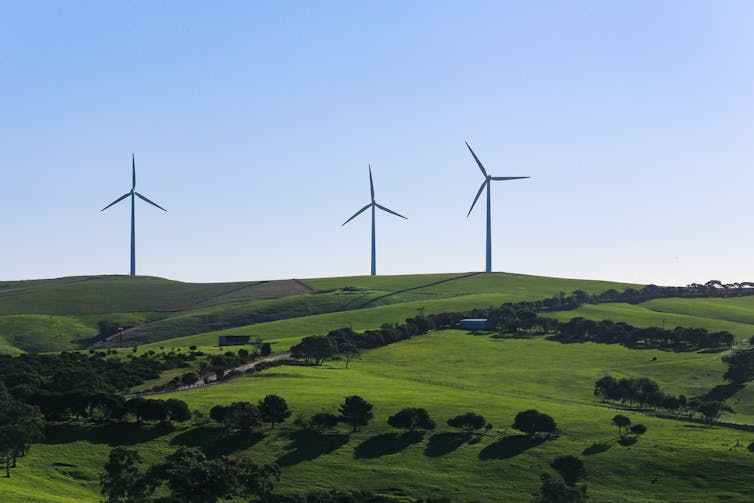
Steps To Reduce Emissions
Our energy futures are intrinsically intertwined with addressing climate change.
The world has only eight years left for global warming to be limited to 1.5℃. This means accelerating the switch to renewable energy without any further delays.
Our first step must be to make all electricity renewable by 2035 in Victoria (and, indeed, in the rest of Australia).
Second, we need a transition to electric vehicles across all transport systems as fast as possible and well before 2040. The Andrews government is investing $100 million to decarbonise the state’s road transport sector, but the transition won’t be complete until 2050.
Third, hard-to-abate sectors – such as certain manufacturing operations, shipping and aviation – need ongoing technological development.
They require significant government support to progress clean fuels, likely based on the renewable hydrogen to ammonia pathway. Victoria has a range of hydrogen and ammonia related industry development policies that show the government recognises this sector’s importance.
Ultimately, the incoming Victorian government’s promises address the first issue well, while making some headway on the second and third.

The Victorian Government Must Be Brave
We can’t rely on the rest of the world for innovation. Governments in Australia must play a more prominent role in infrastructure investment, technology research and development, energy industry development and significant market reform.
Tackling all these challenges isn’t really a job for a single state, particularly given Australia has one major east coast electricity grid and one national energy framework.
The Victorian government cannot achieve any significant changes without working closely with other states and the federal government. In this, state governments must be brave and go against the past three decades of hands-off government approaches to essential energy infrastructure.
This isn’t a time for leaving things to the market to resolve. The Victorian government must take immediate and giant leaps to ensure a stable and climate-friendly energy sector.![]()
Ariel Liebman, Ariel Liebman Director, Monash Energy Institute and Professor of Sustainable Energy Systems, Faculty of Information Technology, Monash University
This article is republished from The Conversation under a Creative Commons license. Read the original article.
Is China ready to lead on protecting nature? At the upcoming UN biodiversity conference, it will preside and set the tone
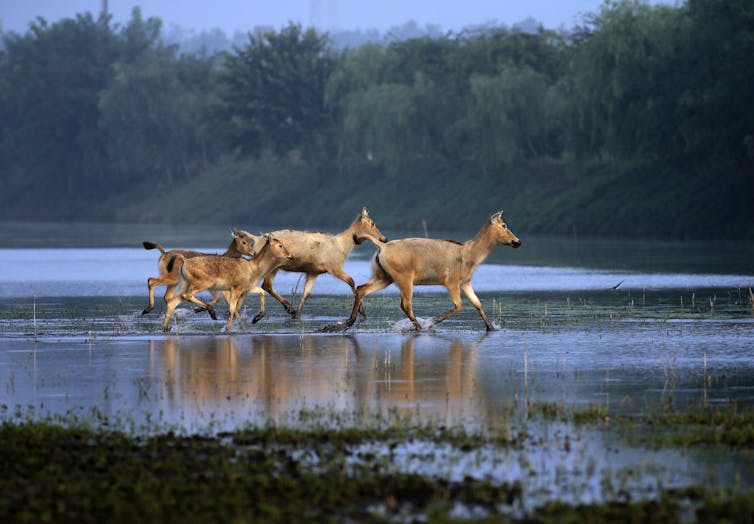
As the world parses what was achieved at the U.N. climate change conference in Egypt, negotiators are convening in Montreal to set goals for curbing Earth’s other crisis: loss of living species.
Starting on Dec. 7, 2022, 196 nations that have ratified the U.N. Convention on Biological Diversity will hold their 15th Conference of the Parties, or COP15. The convention, which was adopted at the 1992 Earth Summit in Rio de Janeiro, is designed to promote sustainable development by protecting biodiversity – the variety of life on Earth, from genes up to entire ecosystems.
Today, experts widely agree that biodiversity is at risk. Because of human activities – especially overhunting, overfishing and altering land – species are disappearing from the planet at 50 to 100 times the historic rate. The United Nations calls this decline a “nature crisis.”
This meeting was originally scheduled to take place in Kunming, China, in 2020 but was rescheduled because of the COVID-19 pandemic, with some negotiations held online. China will lead the deliberations in Montreal and will set the agenda and tone. This is the first time that Beijing has presided over a major intergovernmental meeting on the environment. As a wildlife ecologist, I am eager to see China step into a global leadership role.
Biodiversity In China
If you ask people where on Earth the greatest concentrations of wild species are found, many will assume it’s in rainforests or tropical coral reefs. In fact, China also is rich in nature. It is home to nearly 38,000 higher plant species – essentially, trees, shrubs and ferns; more than 8,100 species of vertebrate animals; over 1,400 bird species; and 20% of the world’s fish species.
Many of China’s wild species are endemic, meaning that they are found nowhere else in the world. China contains parts of four of the world’s global biodiversity hot spots – places that have large numbers of endemic species and also are seriously at risk. Indo-Burma, the Mountains of Southwest China, Eastern Himalaya and the Mountains of Central Asia are home to species such as the giant panda, Asiatic black bear, the endangered Sichuan partridge, Xizang alpine toad, Sichuan lancehead and golden pheasant.
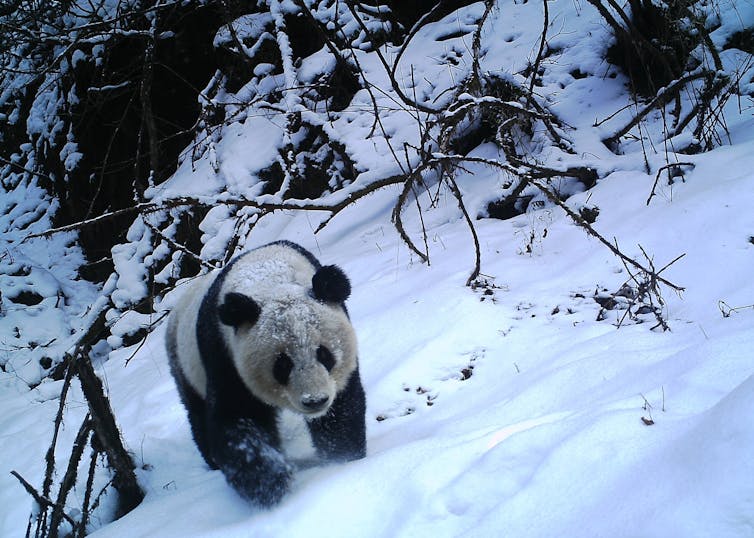
China’s Conservation Record
Western media coverage of environmental issues in China often focuses on the nation’s severe urban air pollution and its role as the world’s largest greenhouse gas emitter. But China has a vision for protecting nature, and it has made progress since the last global biodiversity conference in 2018.
In that year, Chinese leaders coined the term “ecological civilization” and wrote it into the nation’s constitution. This signaled a recognition that development should consider environmental impacts as well as economic goals.
At that point, China had already created over 2,750 protected areas, covering nearly 15% of its total land area. Protected areas are places where there is dedicated funding and management in place to conserve ecosystems, while also allowing for some human activities in designated zones within them.
In 2021 President Xi Jinping announced that China was formally augmenting this system with a network of five national parks covering 88,000 square miles (227,000 square kilometers) – the largest such system in the world.
China also has the fastest-expanding forest area in the world. From 2013 to 2017 alone, China reforested 825 million acres (334 million hectares) of bare or cultivated land – an area four times as large as the entire U.S. national forest system.
At least 10 of China’s notable endangered species are on the path to recovery, including the giant panda, Asian crested ibis and Elliot’s pheasant.
More To Do
Still, China has major areas for improvement. It has underperformed on four of the original Aichi Targets – goals that members of the Convention on Biodiversity adopted for 2011-2020 – including promoting sustainable fisheries, preventing extinctions, controlling invasive alien species and protecting vulnerable ecosystems.
For example, nearly 50% of amphibians in China are threatened. Notable species have been declared extinct, including the Chinese dugong, the Chinese paddlefish and Yangtze sturgeon, and the white-handed gibbon.
The COVID-19 pandemic spotlighted China’s central role in legal and illegal wildlife trade, which threatens many endangered mammals, fish, reptiles and birds. In response, China updated its Wildlife Protection Law, originally enacted in 1989.
On Feb. 24, 2020, the law was expanded to impose a near-total ban on trading wildlife for use as food. Now, however, the ban is being revised in ways that could weaken it, such as easing restrictions on captive breeding.
Around 90% of China’s grasslands are degraded, as are 53% of its coastal wetlands. China has lost 80% of its coral reefs and 73% of its mangroves since 1950. These challenges highlight the need for aggressive action to protect the nation’s remaining biodiversity strongholds.

Goals For COP15
The central goal of the Montreal conference is adopting a post-2020 global biodiversity framework. This road map expands on frameworks put forth in past meetings, including the 2010 Aichi Targets. As the U.N. has reported, nations failed to meet any of the Aichi Targets by 2020, although six goals were partially achieved.
The proposed new framework includes 22 targets to meet by 2030 and four key long-term goals to meet by 2050. They include conserving ecosystems; enhancing the variety of benefits that nature provides to people; ensuring fairness in the sharing of genetic resources, such as digital DNA sequencing data; and solidifying funding commitments.
Many people will be watching to see whether China can successfully lead the negotiations and promote collaboration and consensus. One central challenge is how to pay for the ambitious efforts that the new framework lays out. Environmental advocates are urging wealthy countries to provide up to US$60 billion annually to help lower-income nations pay for conservation projects and curb illegal wildlife trafficking.
China moved in this direction in 2021 when it launched the Kunming Biodiversity Fund and contributed $230 million to it. Pledges from other countries currently total some $5.2 billion per year, mainly from France, the United Kingdom, Japan and the European Union.
China is likely to face questions about its Belt and Road Initiative, a massive infrastructure project that is building railways, pipelines and highways across more than 60 countries. Critics say it is causing deforestation, flooding and other harmful environmental impacts – including in global biodiversity hot spots like Southeast Asia’s Coral Triangle, which contains one of the world’s most important reef systems.
China has pledged to “green” the Belt and Road Initiative going forward, and in 2021, Xi announced a ban on financing new coal power plants overseas, which so far has led to cancellation of 26 plants. This is a start, but China has more to do in addressing Belt and Road’s global impacts.
As home to 18% of Earth’s population and the producer of 18.4% of global GDP, China has a key role to play in protecting nature. I hope to see it provide bold leadership in Montreal and in the years ahead.![]()
Vanessa Hull, Assistant Professor of Wildlife Ecology and Conservation, University of Florida
This article is republished from The Conversation under a Creative Commons license. Read the original article.
Even weak tropical cyclones have grown more intense worldwide – we tracked 30 years of them using currents
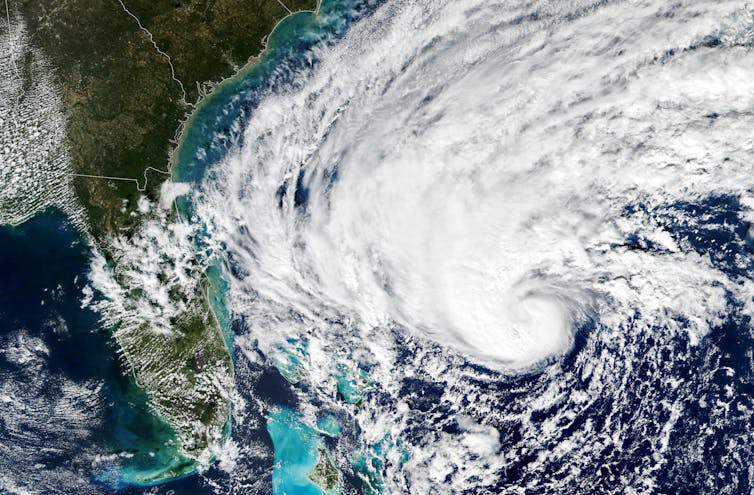
Tropical cyclones have been growing stronger worldwide over the past 30 years, and not just the big ones that you hear about. Our new research finds that weak tropical cyclones have gotten at least 15% more intense in ocean basins where they occur around the world.
That means storms that might have caused minimal damage a few decades ago are growing more dangerous as the planet warms.
Warmer oceans provide more energy for storms to intensify, and theory and climate models point to powerful storms growing stronger, but intensity isn’t easy to document. We found a way to measure intensity by using the ocean currents beneath the storms – with the help of thousands of floating beachball-sized labs called drifters that beam back measurements from around the world.
Why It’s Been Tough To Measure Intensity
Tropical cyclones are large storms with rotating winds and clouds that form over warm ocean water. They are known as tropical storms or hurricanes in the Atlantic and typhoons in the Northwest Pacific.
A tropical cyclone’s intensity is one of the most important factors for determining the damage the storm is likely to cause. However, it’s difficult to accurately estimate intensity from satellite observations alone.
Intensity is often based on maximum sustained surface wind speed at about 33 feet (10 meters) above the surface over a period of one, two or 10 minutes, depending on the meteorological agency doing the measuring. During a hurricane, that region of the storm is nearly impossible to reach.
For some storms, NOAA meteorologists will fly specialized aircraft into the cyclone and drop measuring devices to gather detailed intensity data as the devices fall. But there are many more storms that don’t get measured that way, particularly in more remote basins.

Our study, published in the journal Nature in November 2022, describes a new method to infer tropical cyclone intensity from ocean currents, which are already being measured by an army of drifters.
How Drifters Work
A drifter is a floating ball with sensors and batteries inside and an attached “drogue” that looks like a windsock trailing under the water beneath it to help stabilize it. The drifter moves with the currents and regularly transmits data to a satellite, including water temperature and location. The location data can be used to measure the speed of currents.

Since NOAA launched its Global Drifter Program in 1979, more than 25,000 drifters have been deployed in global oceans. Those devices have provided about 36 million records over time. Of those records, more than 85,000 are associated with weak tropical cyclones – those that are tropical storms or Category 1 hurricanes or typhoons – and about 5,800 that are associated with stronger tropical cyclones.
That isn’t enough data to analyze strong cyclones globally, but we can find trends in the intensity of the weak tropical cyclones.
Here’s how: Winds transfer momentum into the surface ocean water through frictional force, driving water currents. The relationship between wind speed and ocean current, known as Ekman theory, provides a theoretical foundation for our method of deriving wind speeds from the drifter-measured ocean currents.
Our derived wind speeds are consistent with wind speeds directly measured by nearby buoy arrays, justifying the new method to estimate tropical cyclone intensity from drifter measurements.
Evidence Beneath The Storms
In analyzing those records, we found that the ocean currents induced by weak tropical cyclones became stronger globally during the 1991-2020 period. We calculated that the increase in ocean currents corresponds to a 15% to 21% increase in the intensity of weak tropical cyclones, and that intensification occurred in all ocean basins.
In the Northwest Pacific, an area including China, Korea and Japan, a relatively large amount of available drifter data also shows a consistent upward trend in the intensity of strong tropical cyclones.
We also found evidence of increasing intensity in the changes in water temperatures measured by satellites. When a tropical cyclone travels through the ocean, it draws energy from the warm surface water and churns the water layers below, leaving a footprint of colder water in its wake. Stronger tropical cyclones bring more cold water from the subsurface to the surface ocean, leading to a stronger cooling in the ocean surface.
It’s important to remember that even weak tropical cyclones can have devastating impacts. Tropical Storm Megi, called Agaton in the Philippines, triggered landslides and was blamed for 214 deaths in the Philippines in April 2022. Early estimates suggest Hurricane Nicole caused over $500 million in damage in Volusia County alone when it hit Florida as a Category 1 storm in November 2022.
The 2022 Atlantic hurricane season officially ends on Nov. 30, after 14 named storms and eight hurricanes. It isn’t clear how rising global temperatures will effect the number of tropical cyclones that form, but our findings suggest that coastal communities need to be better prepared for increased intensity in those that do form and a concurrent rise in sea level in the future.![]()
Wei Mei, Assistant Professor of Earth, Marine and Environmental Sciences, University of North Carolina at Chapel Hill and Shang-Ping Xie, Roger Revelle Professor of Climate Science, Scripps Institution of Oceanography, University of California, San Diego
This article is republished from The Conversation under a Creative Commons license. Read the original article.
To fight the climate crisis, we need to stop expanding offshore drilling for oil and gas

Environmental disaster struck the shores of Peru on Jan. 15, 2022, when Spanish energy company Repsol spilled 12,000 barrels of crude oil into the Bay of Lima after its tanker ruptured. The spill endangered 180,000 birds and destroyed the livelihoods of 5,000 families.
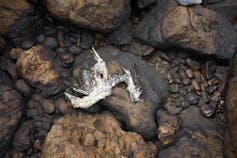
Although this disaster was the largest-ever oil spill in Peru, it is only the most recent of the dozens of large spills that occurred worldwide. In fact, 39 million litres of oil from offshore drilling — enough to fill 16 Olympic-sized swimming pools — pollute our seas every year.
Time and time again, offshore oil and gas activities have jeopardized coastal environments, human health and local economies. At the same time, global reliance on fossil fuels — 30 per cent of which is extracted from beneath the seabed — continues to drive greenhouse gas (GHG) emissions towards the planetary tipping point.
A way out of this mess, according to new analysis conducted by conservation non-profit Oceana, is to halt the expansion of offshore oil and gas extraction, while ramping down future production. This is a critical step towards reducing global emissions.
Offshore Drilling’s Immense Carbon Footprint
Offshore oil and gas emits vast amounts of GHG, starting during the exploration and extraction below the seabed, continuing through intensive processing and refining onshore, and right up until the fuels are finally burned.
Drilling operations are dirty too. Oil extraction vents unusable and wasted gas that must be burned on the spot. This intentional flaring — burning of gas — blasts not only methane and carbon dioxide (CO2), but also toxic air pollutants into the atmosphere.
At the current rate, these lifecycle-emissions from offshore oil and gas are estimated to reach 8.4 billion tons of CO2 equivalent (CO2e, which includes CO2 and other GHG) by 2050.
Ocean Solutions Are Climate Solutions
Ocean-based climate solutions envision a healthy ocean that provides both nature- and technology-based opportunities to limit the worst impacts of climate change.
Simply by existing, the ocean acts as a buffer against the impacts of climate change. It absorbs more than two-thirds of human-produced CO2 and 90 per cent of the excess heat trapped by GHG pollution. Connecting science with concrete policy actions, however, is needed to drastically cut emissions and achieve global climate targets.
Experts previously examined the potential of five ocean-based solutions — ocean-based renewable energy, ocean-based transport, coastal and marine ecosystems, fisheries and marine aquaculture and seabed carbon storage — to mitigate global emissions.
Scaling up offshore renewable energy could significantly cut the need to burn coal for electricity. Meanwhile, co-ordinated efforts are already underway to decarbonize global shipping fleets. Seabed carbon injection remains a contested option to directly capture CO2, as concerns about its risks and scalability persist.
The nature-based solutions hold promise as well. Protecting and restoring coastal ecosystems like mangroves, seagrasses and saltmarshes will amplify their ability to drawdown and lock carbon away. Replacing emissions-intensive food options with climate-smart seafood protein ensures better climate and nutrition outcomes.
Ocean-Based Solutions Can Cut Emissions
For the first time in UN Climate Conference history, earlier this month, leaders at COP27 in Egypt were mandated to prioritize national ocean climate actions under the Paris Agreement.
But after a week of negotiations, COP27 ended with a whimper as delegates failed to agree to a phase down of fossil fuels. In fact, fossil fuel industry delegates in Egypt outnumbered those from the ten countries most affected by climate change. Without collective opposition, fossil fuel interests will continue to deliberately thwart policy plans to reduce emissions.
The Oceana study put a number on GHG emissions that could be averted if countries cancelled their inactive offshore drilling leases and prevented tapping into any new fields. Instead of continuing investments in dirty and dangerous offshore oil and gas, their funds should support renewable energy development to meet our future energy demands.
The International Energy Agency modelled future oil and gas production under exactly those conditions. The net-zero emissions by 2050 scenario predicts that ambitious investments in renewable energy will go hand-in-hand with the gradually declining offshore fossil fuel production. By 2050, the annual emissions averted — 6.3 billion tons of CO2e — would be equivalent to taking 1.4 billion cars off the road.

Combined with the other ocean climate solutions, stopping new offshore drilling would close nearly 40 per cent of the emissions gap needed to meet the Paris Agreement.
But without immediate policy interventions, more untouched oil and gas reserves from the sea will be extracted, burned and generate planet-warming CO2.
When Ocean Conservation Meets Climate Priorities
So is it actually feasible to halt expansion of all new offshore drilling?
Currently, only 10 countries dominate 65 per cent of the offshore oil and gas market. By 2025, around 355 new offshore oil and gas projects across 48 countries are slated to start operating. At COP27, some coastal African nations expressed intentions to tap into fossil fuels to improve energy access.
But locking in more offshore drilling leases will not ensure energy security or necessarily lower fuel prices. Oil companies continue to rake in record profits. New drilling will, however, trap coastal communities in an unsustainable industry that threatens to pollute waters, harm their health and heat our planet.
Several countries are already taking the lead in plugging this pipeline for good. Since 2017, countries like Costa Rica, Belize, Denmark, Ireland and New Zealand have stopped granting licenses for offshore oil and gas exploration.
Others pledged to ban extraction altogether, while the European Union, India and multiple island nations called for a phase down of all fossil fuel production in this year’s UN climate agreement. A new global emissions data tool released at COP27 can further help governments hold the biggest fossil fuel polluters accountable.
We are also seeing benefits of regional transitions to clean energy. In the U.S., for instance, the offshore wind industry could support 80,000 new jobs by 2030. And new markets in the Global South, like Vietnam and India, are also shifting away from offshore oil and gas.
The outcomes of COP27 fell short of the ambition needed to limit emissions on track with our climate goals. More than ever, we need our nations’ leaders to prioritize the well-being of their citizens over the wallets of the fossil fuel industry. A future with less offshore drilling is the only future compatible with clean energy access, a healthy ocean and liveable climate for all.![]()
Daniel Skerritt, Affiliated Researcher, Fisheries Economics Research Unit, University of British Columbia and Claire Huang, Master of Environmental Management, Duke University
This article is republished from The Conversation under a Creative Commons license. Read the original article.
Beware of ‘Shark Week’: Scientists watched 202 episodes and found them filled with junk science, misinformation and white male ‘experts’ named Mike
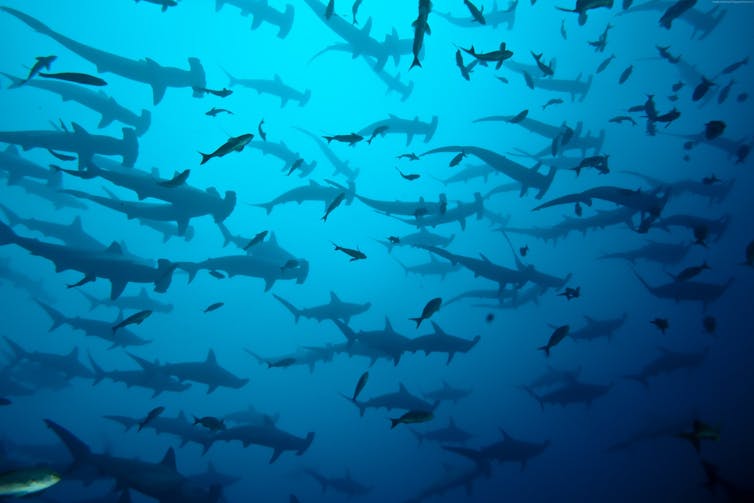
The Discovery Channel’s annual Shark Week is the longest-running cable television series in history, filling screens with sharky content every summer since 1988. It causes one of the largest temporary increases in U.S. viewers’ attention to any science or conservation topic.
It’s also the largest stage in marine biology, giving scientists who appear on it access to an audience of millions. Being featured by high-profile media outlets can help researchers attract attention and funding that can help super-charge their careers.
Unfortunately, Shark Week is also a missed opportunity. As scientists and conservationists have long argued, it is a major source of misinformation and nonsense about sharks, the scientists who study them, and how people can help protect endangered species from extinction.
I am a marine biologist who recently worked with five colleagues to scientifically analyze the content of Shark Week episodes. We tracked down copies of 202 episodes, watched them all and coded their content based on more than 15 variables, including locations, which experts were interviewed, which shark species were mentioned, what scientific research tools were used, whether the episodes mentioned shark conservation and how sharks were portrayed.
Even as longtime Shark Week critics, we were staggered by our findings. The episodes that we reviewed were full of incorrect information and provided a wildly misleading picture of the field of shark research. Some episodes glorified wildlife harassment, and many missed countless chances to teach a massive audience about shark conservation.
Spotlight Real Solutions
First, some facts. Sharks and their relatives, such as rays and skates, are among the most threatened vertebrate animals on Earth. About one-third of all known species are at risk of extinction, thanks mainly to overfishing.
Many policy solutions, such as setting fishing quotas, creating protected species lists and delineating no-fishing zones, are enacted nationally or internationally. But there also are countless situations in which increased public attention can help move the conservation needle. For instance, consumers can avoid buying seafood produced using unsustainable fishing methods that may accidentally catch sharks.
Conversely, focusing on the wrong problems does not lead to useful solutions. As one example, enacting a ban on shark fin sales in the U.S. would have little effect on global shark deaths, since the U.S. is only involved in about 1% of the global fin trade, and could undermine sustainable U.S. shark fisheries.
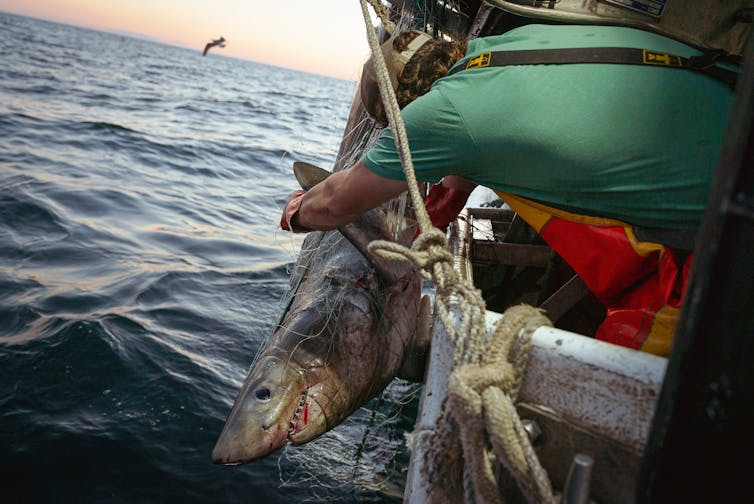
The Discovery Channel claims that by attracting massive audiences, Shark Week helps educate the public about shark conservation. But most of the shows we reviewed didn’t mention conservation at all, beyond vague statements that sharks need help, without describing the threats they face or how to address them.
Out of 202 episodes that we examined, just six contained any actionable tips. Half of those simply advised against eating shark fin soup, a traditional Asian delicacy. Demand for shark fin soup can contribute to the gruesome practice of “finning” – cutting fins off live sharks and throwing the mutilated fish overboard to die. But finning is not the biggest threat to sharks, and most U.S.-based Shark Week viewers don’t eat shark fin soup.
Spotlighting Divers, Not Research
When we analyzed episodes by the type of scientific research they featured, the most frequent answer was “no scientific research at all,” followed by what we charitably called “other.” This category included nonsense like building a submarine that looks like a shark, or a “high tech” custom shark cage to observe some aspect of shark behavior. These episodes focused on alleged risk to the scuba divers shown on camera, especially when the devices inevitably failed, but failed to address any research questions.
Such framing is not representative of actual shark research, which uses methods ranging from tracking tagged sharks via satellite to genetic and paleontological studies conducted entirely in labs. Such work may not be as exciting on camera as divers surrounded by schooling sharks, but it generates much more useful data.
Who’s On Camera
We also were troubled by the “experts” interviewed on many Shark Week shows. The most-featured source, underwater photographer Andy Casagrande, is an award-winning cameraman, and episodes when he stays behind the camera can be great. But given the chance to speak, he regularly claims the mantle of science while making dubious assertions – for example, that shark diving while taking LSD is a great way to learn about these animals – or presents well-known shark behaviors as new discoveries that he made, while misrepresenting what those behaviors mean.
Nor does Shark Week accurately represent experts in this field. One issue is ethnicity: Three of the five most-featured locations on Shark Week are Mexico, South Africa and the Bahamas, but we could count on one hand the number of non-white scientists who we saw featured in shows about their own countries. It was far more common for Discovery to fly a white male halfway around the world than to feature a local scientist.
Moreover, while more than half of U.S. shark scientists are female, you wouldn’t know this from watching Shark Week. Among people who we saw featured in more than one episode, there were more white male non-scientists named Mike than women of any profession or name.
In contrast, the Discovery Channel’s chief competitor, National Geographic, is partnering with the professional organization Minorities in Shark Sciences to feature diverse experts on its shows.
More Substance And Better Representation
How could Shark Week improve? Our paper makes several recommendations, and we recently participated in a workshop, highlighting diverse voices in our field from all over the world, that focused on improving representation of scientists in shark-focused media
First, we believe that not every documentary needs to be a dry, boring science lecture, but that the information shared on marine biology’s biggest stage should be factually correct and useful. Gimmicky concepts like Discovery’s “Naked and Afraid of Sharks 2” – an endurance contest with entrants wearing masks, fins and snorkels, but no clothes – show that people will watch anything with sharks in it. So why not try to make something good?
We also suggest that more scientists seek out media training so they can take advantage of opportunities like Shark Week without being taken advantage of. Similarly, it would be great to have a “Yelp”-like service that scientists could use to rate their experiences with media companies. Producers who want to feature appropriately diverse scientists can turn to databases like 500 Women Scientists and Diversify EEB.
For a decade, concerned scientists and conservationists have reached out to the Discovery Channel about our concerns with Shark Week. As our article recounts, Discovery has pledged in the past to present programming during Shark Week that puts more emphasis on science and less on entertainment – and some episodes have shown improvement.
But our findings show that many Shark Week depictions of sharks are still problematic, pseudoscientific, nonsensical or unhelpful. We hope that our analysis will motivate the network to use its massive audience to help sharks and elevate the scientists who study them.
Editor’s note: The Conversation US contacted Warner Brothers Discovery by phone and email for comment on the study described in this article. The network did not immediately respond or offer comment.![]()
David Shiffman, Post-Doctoral and Research Scholar in Marine Biology, Arizona State University
This article is republished from The Conversation under a Creative Commons license. Read the original article.
Pittwater Reserves: Histories + Notes + Pictorial Walks
A History Of The Campaign For Preservation Of The Warriewood Escarpment by David Palmer OAM and Angus Gordon OAM
America Bay Track Walk - photos by Joe Mills
An Aquatic June: North Narrabeen - Turimetta - Collaroy photos by Joe Mills
Angophora Reserve Angophora Reserve Flowers Grand Old Tree Of Angophora Reserve Falls Back To The Earth - History page
Annie Wyatt Reserve - A Pictorial
Avalon's Village Green: Avalon Park Becomes Dunbar Park - Some History + Toongari Reserve and Catalpa Reserve
Bairne Walking Track Ku-Ring-Gai Chase NP by Kevin Murray
Bangalley Headland Bangalley Mid Winter
Banksias of Pittwater
Barrenjoey Boathouse In Governor Phillip Park Part Of Our Community For 75 Years: Photos From The Collection Of Russell Walton, Son Of Victor Walton
Barrenjoey Headland: Spring flowers
Barrenjoey Headland after fire
Bayview Baths
Bayview Wetlands
Beeby Park
Bilgola Beach
Botham Beach by Barbara Davies
Bungan Beach Bush Care
Careel Bay Saltmarsh plants
Careel Bay Birds
Careel Bay Clean Up day
Careel Bay Playing Fields History and Current
Careel Creek
Careel Creek - If you rebuild it they will come
Centre trail in Ku-ring-gai Chase National Park
Chiltern Track- Ingleside by Marita Macrae
Clareville Beach
Clareville/Long Beach Reserve + some History
Coastal Stability Series: Cabbage Tree Bay To Barrenjoey To Observation Point by John Illingsworth, Pittwater Pathways, and Dr. Peter Mitchell OAM
Cowan Track by Kevin Murray
Curl Curl To Freshwater Walk: October 2021 by Kevin Murray and Joe Mills
Currawong and Palm Beach Views - Winter 2018
Currawong-Mackerel-The Basin A Stroll In Early November 2021 - photos by Selena Griffith
Currawong State Park Currawong Beach + Currawong Creek
Deep Creek To Warriewood Walk photos by Joe Mills
Drone Gives A New View On Coastal Stability; Bungan: Bungan Headland To Newport Beach + Bilgola: North Newport Beach To Avalon + Bangalley: Avalon Headland To Palm Beach
Duck Holes: McCarrs Creek by Joe Mills
Dunbar Park - Some History + Toongari Reserve and Catalpa Reserve
Dundundra Falls Reserve: August 2020 photos by Selena Griffith - Listed in 1935
Elsie Track, Scotland Island
Elvina Track in Late Winter 2019 by Penny Gleen
Elvina Bay Walking Track: Spring 2020 photos by Joe Mills
Elvina Bay-Lovett Bay Loop Spring 2020 by Kevin Murray and Joe Mills
Fern Creek - Ingleside Escarpment To Warriewood Walk + Some History photos by Joe Mills
Iluka Park, Woorak Park, Pittwater Park, Sand Point Reserve, Snapperman Beach Reserve - Palm Beach: Some History
Ingleside
Ingleside Wildflowers August 2013
Irrawong - Ingleside Escarpment Trail Walk Spring 2020 photos by Joe Mills
Irrawong - Mullet Creek Restoration
Katandra Bushland Sanctuary - Ingleside
Lucinda Park, Palm Beach: Some History + 2022 Pictures
McCarrs Creek
McCarr's Creek to Church Point to Bayview Waterfront Path
McKay Reserve
Mona Vale Beach - A Stroll Along, Spring 2021 by Kevin Murray
Mona Vale Headland, Basin and Beach Restoration
Mount Murray Anderson Walking Track by Kevin Murray and Joe Mills
Mullet Creek
Narrabeen Creek
Narrabeen Lagoon Catchment: Past Notes Present Photos by Margaret Woods
Narrabeen Lagoon State Park
Narrabeen Lagoon State Park Expansion
Narrabeen Rockshelf Aquatic Reserve
Nerang Track, Terrey Hills by Bea Pierce
Newport Bushlink - the Crown of the Hill Linked Reserves
Newport Community Garden - Woolcott Reserve
Newport to Bilgola Bushlink 'From The Crown To The Sea' Paths: Founded In 1956 - A Tip and Quarry Becomes Green Space For People and Wildlife
Pittwater spring: waterbirds return to Wetlands
Pittwater's Lone Rangers - 120 Years of Ku-Ring-Gai Chase and the Men of Flowers Inspired by Eccleston Du Faur
Pittwater's Parallel Estuary - The Cowan 'Creek
Resolute Track at West Head by Kevin Murray
Resolute Track Stroll by Joe Mills
Riddle Reserve, Bayview
Salvation Loop Trail, Ku-Ring-Gai Chase National Park- Spring 2020 - by Selena Griffith
Seagull Pair At Turimetta Beach: Spring Is In The Air!
Stapleton Reserve
Stapleton Park Reserve In Spring 2020: An Urban Ark Of Plants Found Nowhere Else
Stony Range Regional Botanical Garden: Some History On How A Reserve Became An Australian Plant Park
The Chiltern Track
The Resolute Beach Loop Track At West Head In Ku-Ring-Gai Chase National Park by Kevin Murray
Topham Track Ku-Ring-Gai Chase NP, August 2022 by Joe Mills and Kevin Murray
Towlers Bay Walking Track by Joe Mills
Trafalgar Square, Newport: A 'Commons' Park Dedicated By Private Landholders - The Green Heart Of This Community
Tranquil Turimetta Beach, April 2022 by Joe Mills
Turimetta Beach Reserve by Joe Mills, Bea Pierce and Lesley
Turimetta Beach Reserve: Old & New Images (by Kevin Murray) + Some History
Turimetta Headland
Warriewood Wetlands and Irrawong Reserve
Whale Beach Ocean Reserve: 'The Strand' - Some History On Another Great Protected Pittwater Reserve
Wilshire Park Palm Beach: Some History + Photos From May 2022
Winji Jimmi - Water Maze

New Shorebirds WingThing For Youngsters Available To Download
A Shorebirds WingThing educational brochure for kids (A5) helps children learn about shorebirds, their life and journey. The 2021 revised brochure version was published in February 2021 and is available now. You can download a file copy here.
If you would like a free print copy of this brochure, please send a self-addressed envelope with A$1.10 postage (or larger if you would like it unfolded) affixed to: BirdLife Australia, Shorebird WingThing Request, 2-05Shorebird WingThing/60 Leicester St, Carlton VIC 3053.

 Shorebird Identification Booklet
Shorebird Identification Booklet
The Migratory Shorebird Program has just released the third edition of its hugely popular Shorebird Identification Booklet. The team has thoroughly revised and updated this pocket-sized companion for all shorebird counters and interested birders, with lots of useful information on our most common shorebirds, key identification features, sighting distribution maps and short articles on some of BirdLife’s shorebird activities.
The booklet can be downloaded here in PDF file format: http://www.birdlife.org.au/documents/Shorebird_ID_Booklet_V3.pdf
Paper copies can be ordered as well, see http://www.birdlife.org.au/projects/shorebirds-2020/counter-resources for details.
Download BirdLife Australia's children’s education kit to help them learn more about our wading birdlife
Shorebirds are a group of wading birds that can be found feeding on swamps, tidal mudflats, estuaries, beaches and open country. For many people, shorebirds are just those brown birds feeding a long way out on the mud but they are actually a remarkably diverse collection of birds including stilts, sandpipers, snipe, curlews, godwits, plovers and oystercatchers. Each species is superbly adapted to suit its preferred habitat. The Red-necked Stint is as small as a sparrow, with relatively short legs and bill that it pecks food from the surface of the mud with, whereas the Eastern Curlew is over two feet long with a exceptionally long legs and a massively curved beak that it thrusts deep down into the mud to pull out crabs, worms and other creatures hidden below the surface.
Some shorebirds are fairly drab in plumage, especially when they are visiting Australia in their non-breeding season, but when they migrate to their Arctic nesting grounds, they develop a vibrant flush of bright colours to attract a mate. We have 37 types of shorebirds that annually migrate to Australia on some of the most lengthy and arduous journeys in the animal kingdom, but there are also 18 shorebirds that call Australia home all year round.
What all our shorebirds have in common—be they large or small, seasoned traveller or homebody, brightly coloured or in muted tones—is that each species needs adequate safe areas where they can successfully feed and breed.
The National Shorebird Monitoring Program is managed and supported by BirdLife Australia.
This project is supported by Glenelg Hopkins Catchment Management Authority and Hunter Local Land Services through funding from the Australian Government’s National Landcare Program. Funding from Helen Macpherson Smith Trust and Port Phillip Bay Fund is acknowledged.
The National Shorebird Monitoring Program is made possible with the help of over 1,600 volunteers working in coastal and inland habitats all over Australia.
The National Shorebird Monitoring program (started as the Shorebirds 2020 project initiated to re-invigorate monitoring around Australia) is raising awareness of how incredible shorebirds are, and actively engaging the community to participate in gathering information needed to conserve shorebirds.
In the short term, the destruction of tidal ecosystems will need to be stopped, and our program is designed to strengthen the case for protecting these important habitats.
In the long term, there will be a need to mitigate against the likely effects of climate change on a species that travels across the entire range of latitudes where impacts are likely.
The identification and protection of critical areas for shorebirds will need to continue in order to guard against the potential threats associated with habitats in close proximity to nearly half the human population.
Here in Australia, the place where these birds grow up and spend most of their lives, continued monitoring is necessary to inform the best management practice to maintain shorebird populations.
BirdLife Australia believe that we can help secure a brighter future for these remarkable birds by educating stakeholders, gathering information on how and why shorebird populations are changing, and working to grow the community of people who care about shorebirds.
To find out more visit: http://www.birdlife.org.au/projects/shorebirds-2020/shorebirds-2020-program
Aussie Bread Tags Collection Points

AvPals Training Term 4 2022 At Newport

Pittwater-Narrabeen Parkinson’s Support Group
Higher Vitamin K Intake Linked To Lower Bone Fracture Risk Late In Life
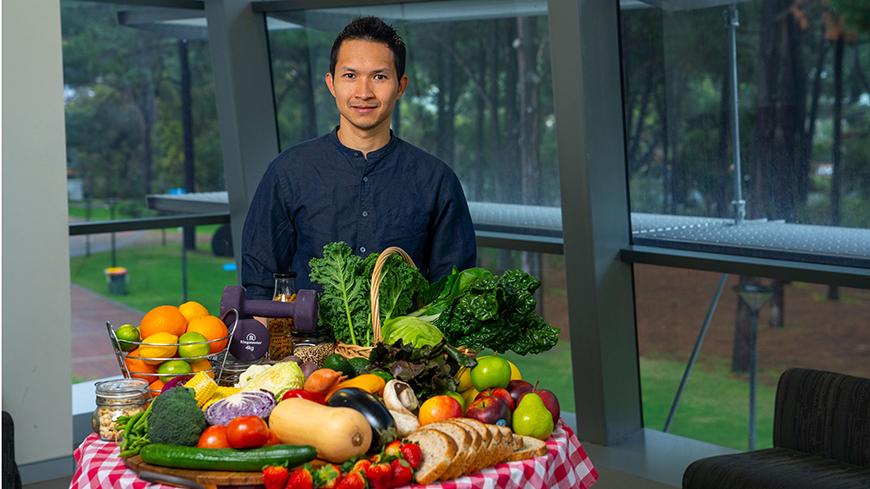
Put The Kettle On! How Black Tea (And Other Favourites) May Help Your Health Later In Life

ECU Part Of International Taskforce Clarifying Prevention, Diagnosis And Treatment Of Sarcopenia
U3A Activities
- A day trip to Mount Wilson on 5 October (details on page 9);
- Our annual picnic on 20 October, this year at Clontarf Reserve (details on page 10); and
- Tunnels and Gunners Tour, with a guide from the Sydney Harbour Trust, on 3 November (details on page 10.
More Ways For Seniors To Get Involved In 2023 NSW Seniors Festival
- Friends of Ivanhoe Park Botanical Garden Inc., Manly - Walks and Talks in Ivanhoe Park Manly
- RSL LifeCare Ltd., Pittwater - War Vets Art Exhibition & Workshops
Premier's Gala Concerts
Bilgola Probus Club Commences


Pensioner's Concessions: Council Rates
- Half of the total of your ordinary rates and domestic waste management service charge, up to a maximum of $250.
- Half of your water rates or charges, up to a maximum of $87.50.
- Half of your sewerage rates or charges, up to a maximum of $87.50.
Keep On Dancing Is What The Science Says!
- Flexibility
- Agility
- Mobility
- Strength
- Stability

Have Your Say: National Dementia Action Plan
- a coordinated approach to risk reduction
- early diagnosis
- better support for carers
- provide a national vision – for greater inclusion of people living with dementia, their carers and families
- guide action by governments – so health, acute and aged care systems work more seamlessly and broader policies and programs consider dementia
- drive mainstream services and systems – to improve outcomes for people living with dementia, their carers and families
- develop an accountability framework – so we can measure progress
- engage, inform and involve the whole community – to achieve a society that’s more understanding and more inclusive of people living with dementia.
- people living with dementia
- their carers, families and friends
- people who work in primary care, health, acute or aged care
- researchers and academics.
An Aboriginal And Torres Strait Islander Voice To Parliament
Preventing Age-Related Vision Loss
- the latest AMD treatment guidelines from the Royal Australian and New Zealand College of Ophthalmologists (RANZCO)
- the new AMD biomarkers and how to detect them using retinal imaging
- clinical trials for patients with AMD.
Cheaper Medicines For High Cholesterol And Chronic Heart Failure
Updated Guiding Principles To Improve Medication Management
Paxlovid is Australia’s first-line COVID antiviral but Lagevrio also prevents severe disease in over-70s

Australia is experiencing the fourth wave of COVID for 2022, with the number of people hospitalised with COVID trending to levels seen in winter and ongoing high levels of deaths. New COVID waves are expected to occur every three to four months for some time.
Earlier in the pandemic, COVID treatments mostly focused on those hospitalised with serious infection. Now, oral antiviral medicines nirmatrelvir/ritonavir (Paxlovid) and molnupiravir (Lagevrio) are largely prescribed by GPs for people who test positive for COVID and are at greater risk of severe illness.
In our roles in Victoria’s Department of Health, we analysed the impact of antivirals on the risk of death and hospitalisation among Victorians aged 70 and over during the winter 2022 COVID wave.
Our analysis, which is yet to be published or independently verified by other scientists, found both Paxlovid and Lagevrio reduced the risk of hospitalisation and death. And the results were better for Paxlovid.
Several previous studies have shown Paxlovid is highly effective at preventing severe illness and death from COVID. It’s currently Australia’s first-line COVID antiviral treatment for early treatment in the community.
However, a recent trial has raised questions about the effectivness of the other antiviral available in Australia, Lagevrio. While there’s evidence it’s effective at treating COVID, it’s no longer recommended in the United Kingdom because it’s not considered cost-effective.
While Australia’s clinical guidelines are yet to change, our analysis suggests both Paxlovid and Lagevrio have a role to play in Australia’s treatment arsenal. Some people who are unable to have Paxlovid will benefit from Lagevrio.

How Well Do These Antivirals Work?
Initial clinical trials of Paxlovid and Lagevrio in unvaccinated adults show they significantly reduce the risk of hospitalisation or death from COVID.
Those who took Lagevrio were 30% less likely to be hospitalised or die with COVID.
In a separate trial, those that took Paxlovid were 89% less likely to be hospitalised or die.
Recently, a pre-print analysis (which is still undergoing external scientific review) reported on a large clinical trial in the United Kingdom. It found Lagevrio didn’t reduce hospitalisation or the risk of death for vaccinated adults (0.8%) compared to standard care.
It found treatment did reduce recovery time by four days. It also reduced contact with GP services, the time tests remained positive, and the amount of virus detected.
However it’s important to note the population studied in the UK trial were relatively young: 86% were aged 50–70. They were therefore at lower risk of severe COVID than the over-70s age group who represent most of those prescribed Lagevrio in Australia.
So the study may not have adequately demonstrated the potential benefit for older adults who are at higher risk of severe illness from COVID.
On the other hand, real-world (or observational) studies from Hong Kong, Israel and Poland have reported Lagevrio reduces the chance of high-risk patients dying from COVID.

Our Analysis
We used our routine data and linkage techniques to examine the risk of hospitalisation in more than 27,000 Victorians aged over 70 years diagnosed with COVID and the risk of death in more than 32,000 people who did and didn’t undergo treatment.
This analysis involved collaboration between the Victorian and Australian government health departments, and linked Pharmaceutical Benefits Scheme (PBS) prescriptions, COVID vaccination, diagnoses, hospitalisation, and death data.
After controlling for various factors influencing the risk of hospitalisation and death (vaccination history, sex, socioeconomic status, hospitalisation history, and aged care residency), we found significant benefits for both drugs.
We found:
COVID medicines substantially reduced risk of hospitalisation (32% for Paxlovid, 26% for Lagevrio) and risk of death (72% for Paxlovid, 54% for Lagevrio)
early treatment with a COVID antiviral provided the greatest benefit – treatment with either drug within one day of diagnosis reduced the risk of hospitalisation by 37%, and death by 63%
the benefits for reducing the risk of hospitalisation were not seen if people were treated two or more days after diagnosis
the benefits for reducing the risk of death were not seen if treated four or more days after diagnosis.
Some important limitations of this analysis are that it’s observational, so we can’t control for a number of factors associated with hospitalisation and death from COVID.
Another limitation is the choice of antiviral medicine by the prescribing GP may be influenced by factors which are also associated with the risk of severe outcomes. This could bias the estimates of the treatment’s effect.
A strength of this analysis is the large size, and the fact it reports on the entire population of Victorians aged 70 years and above diagnosed with COVID during the winter wave.
So What Does It Mean?
In our analysis, the effect of Paxlovid was greater than that of Lagevrio. This is in keeping with the current available evidence and its recommendation as a first-line therapy.
However, Paxlovid is not safe for people with some underlying conditions, such as severe kidney or liver disease. It also has a number of drug interactions with commonly used medications.
So when Paxlovid is unsuitable or not available, Lagevrio is a suitable option.
Because Lagevrio has fewer interactions and can be used in a wider range of patients, it has been pre-placed in residential aged care, for rapid access.
Australians with lower socioeconomic status are more likely to be hospitalised with or die from COVID. So developing strategies to increase antiviral access for people who face the greatest burden of COVID will help reduce these inequities.
Antivirals are an important additional tool as part of an multi-layered response to COVID. This aims to reduce community transmission and the risk of illness in priority populations, and to protect our health system in the months to come and waves ahead of us.
Acknowledgements: The analysis mentioned above includes contributions from Daniel West, Indra Parta, Jose Canevari, Nick Haslett, Dennis Wollersheim, Marcellin Martinie and Rebecca Dawson from the Victorian Department of Health’s Modelling and Analytical Epidemiology team.![]()
Benjamin Cowie, Director, WHO Collaborating Centre for Viral Hepatitis, The Peter Doherty Institute for Infection and Immunity; Brett Sutton, Adjunct Clinical Professor, Monash University; Christina Van Heer, PhD candidate at The School of Medicine, Dentistry and Health Sciences, The University of Melbourne, and Suman Majumdar, Deputy Program Director, Health Security and Pandemic Preparedness, Burnet Institute
This article is republished from The Conversation under a Creative Commons license. Read the original article.
The (unjustly forgotten) genius of pianist Clara Haskil

Many of the women who pursued careers in music during the turbulent 20th century led extraordinarily complex and exciting lives. As well as confronting the stereotypes that women artists have long faced, they often lived and worked in the midst of war. Despite their accomplishments, their names are not always known by the general public. Romanian pianist Clara Haskil is one of them.
An expert musician, Haskil was one of the most outstanding solo performers of the 20th century.
Who Was Clara Haskil?
Haskil was born in Bucharest in 1895 into a Sephardic Jewish family. She received her first piano lessons from her mother, Berthe Haskil. From an early age, Haskil demonstrated excellent skills, including a capacity to reproduce musical works heard only once. Haskil’s family, aware of her musical talent, decided that she should move to Vienna with one of her uncles when she was seven, and later to Paris, where she received lessons in piano and violin.
Her time in the French capital marked the beginning of her successes. In 1910 she won first prize for piano in a competition organised by the Conservatoire de Paris, which was considered the best in the world at the time. She soon began to give concerts in France, Austria, Italy and Switzerland.
When she was fifteen, she met the Italian pianist and conductor Ferruccio Busoni in Zurich. Upon hearing her at one of her performances, he invited her to continue her studies under his tutelage in Berlin. Haskil declined – a decision she apparently regretted for the rest of her life.
Overcoming Adversity
The outbreak of World War I in 1914 coincided with the loss of Haskil’s mother, the arrest of her uncle and numerous health problems due to the deforming scoliosis she had been diagnosed with. After the end of the war, and a long period of immobilisation in a plaster corset following surgery, she became increasingly active as a concert pianist.

Although she continued to live in France, Switzerland became an important place for Haskil. There she found a climate favourable to her health, a friendly atmosphere and the beginning of admiration from the European public. In Vienna, the press hailed her as “a new star” after her concerts in 1923.
The United States also fell at her feet. She achieved enormous success after her first tour in 1924, triumphing in New York and getting excellent reviews in the leading newspapers: “Clara Haskil, fresh from Paris, gave a remarkable demonstration of flying fingers in her first New York recital at Aeolian Hall” (New York Herald).
Although critics were always enthusiastic about her performances, her letters exude a strong self-demanding and constant non-conformism. This was an artist in search of perfection that she never quite found to a satisfactory degree. All this was probably responsible for the stage fright she suffered throughout her life, which she managed to live with.
Haskil was, in the words of Jeremy Siepmann, “musician for musicians” and “pianist for pianists”. However, the outbreak of World War II, which coincided with new health problems, again interrupted her career, as well as instilling in her the fear of being captured for being Jewish.
From a financial point of view, it was also a difficult time due to the absence of concerts in Paris, where she lived, and the fact that, during those years, it was not possible for foreigners to play on the radio. However, thanks to her friends and admirers, she managed to obtain the necessary papers to be admitted to Switzerland in 1942.
Clara Haskil’s Friends And Colleagues
Friendships were fundamental in the pianist’s life. Some of them helped her financially and socially. Winnaretta Singer, the Princess of Polignac, who was a patron of great musicians, placed one of the pianos in her Parisian mansion at Haskil’s disposal and even introduced her to an elite cultural circle by regularly inviting her to his salon.
She enjoyed collaborations with leading musicians such as Pau Casals, Eugène Ysaÿe and Herbert von Karajan, with whom she shared a successful tour of Vienna and Salzburg. On a personal level, she enjoyed a deep friendship with the Romanian pianist Dinu Lipatti.
However, Charlie Chaplin was perhaps the most famous of her friends. It was common for the Chaplin family to visit the pianist at her house in Vevey, and they celebrated Christmas on several occasions in the Manoir de Ban, owned by the actor. He was the one who most publicly professed his admiration for her, as can be seen in these words from a radio interview in 1962:
During my life I have known three geniuses. One was Clara Haskil. The others were Professor Einstein and Sir Winston Churchill.

Role Model
Haskil was not an assiduous live performer, however. She was not big on social interactions, and, more importantly, she didn’t have an agent. Fortunately, we can enjoy her legacy through her recordings.
In 1947 she made his first commercial recording for Decca, performing Beethoven’s Concerto for Piano and Orchestra No. 4 with the London Philharmonic Orchestra conducted by Carlo Zecchi.
Haskil’s performances are characterised by precision and agility. One can observe a light touch and a great naturalness with no abuse of the pedal. Her favourite composer was Mozart. Her performances of his piano compositions is a reference for pianists worldwide.
She became not only an outstanding soloist, but also an outstanding performer of chamber music. This can be seen in the recordings of the Sonatas for violin and piano by Mozart and Beethoven together with the Belgian violinist Arthur Grumiaux. Their recordings demonstrate harmony and closeness to the composer’s text. The personal and professional relationship with Grumiaux lasted until the end of his life.
Clara Haskil’s recordings of the works of Robert Schumann have also become benchmarks. Both in the German composer’s microforms –such as Children’s Scenes Op. 15 and Forest Scenes Op. 82– and in the Piano Concerto in A minor, one can see Haskil’s technical mastery and her appreciation of a certain sense of freedom.
Although she was acclaimed by audiences and critics during her lifetime, the greatest recognition of her career is that her legacy has passed to posterity through the magic of recordings that mean her musical vision will live on forever.![]()
Virginia Sánchez Rodríguez, Profesora Contratada Doctora de la UCLM. Miembro del Centro de Investigación y Documentación Musical (CIDoM)-Unidad Asocida al CSIC. Especialista en música del cine español y mujeres músicas de los siglos XIX y XX., Universidad de Castilla-La Mancha
This article is republished from The Conversation under a Creative Commons license. Read the original article.
305 Squadron, Australian Air Force Cadets

The Australian Air Force Cadets, formed in 1941 (then as the Air Training Corp) is an inclusive, aerospace-focused youth development organisation supported and administered by the Royal Australian Air Force, as part of the broader Australia Defence Force Cadets program.
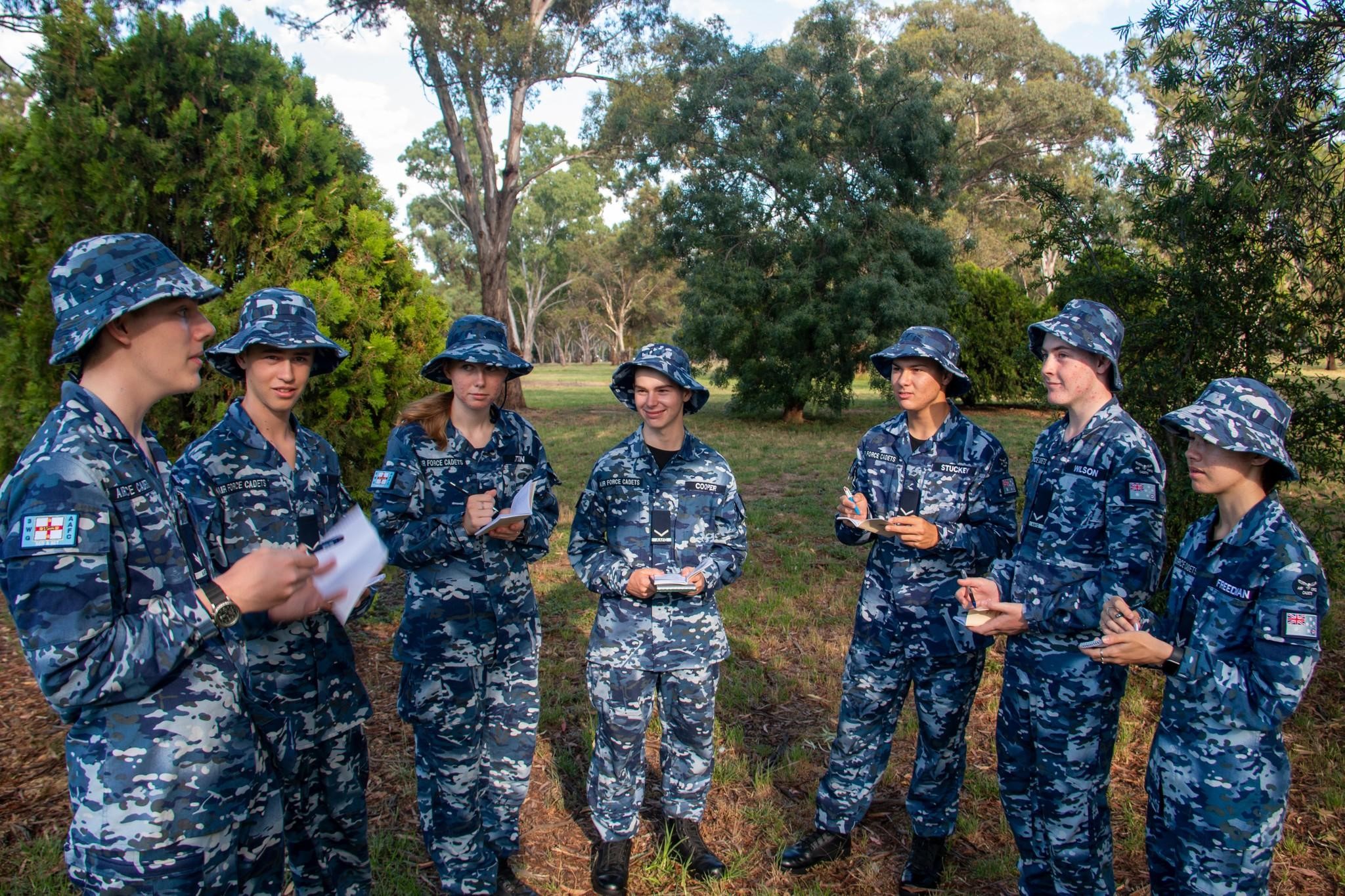
Although it has evolved in the many years since its formation 1941, and continues to evolve with a renewed focus on S.T.E.M. education, the Australian Air Force’s objectives are currently:
- To give cadets a foundation of Royal Australian Air Force (RAAF) knowledge and discipline
- To develop qualities of leadership, self-reliance and initiative
- To develop character and good citizenship in the widest sense
- To develop an interest in the RAAF and aviation generally
- To instil a knowledge of aviation history, and
- To encourage cadets to continue an active interest in aviation into their adult life.
More information about the Australian Air Force Cadets can be found at: www.airforcecadets.gov.au/who-we-are
No. 305 (City of Northern Beaches) Squadron, Australian Air Force Cadets meets every Thursday evening in Dee Why. There, our cadets learn multiple subjects, including aviation theory, fieldcraft and drill and ceremonial (which includes marching).
305 Squadron accepts recruits between the ages of 13 and 17 and teaches them valuable life skills, allowing cadets to develop qualities including leadership, self-reliance, discipline, confidence, self-respect, good communication, teamwork, and citizenship. We provide experiences and opportunities which you won’t find anywhere else. Our cadets experience a small taste of what the air force is like and will make friends for life.
In addition to our weekly training, we offer many extracurricular activities on the weekends including:
- Visits to a Air Force Bases, and their aircraft hangars;
- Camping and field training;
- Pilot experience weekends where our cadets learn to fly planes as young as 14 years old;
- Safe firearm shooting; and
- Community and ceremonial events.

305 Squadron has a long history on the Northern Beaches, celebrating its 71st anniversary in 2022. After moving locations several times during its history, it settled at The Pittwater House School and enjoyed a close association with the school between 2001 and 2016. Since then, 305 Squadron has moved to the Dee Why Multi-User Depot, which it shares with the Army.
The cadets of 305 Squadron can be seen formed up at ceremonial events across the Northern Beaches, including ANZAC Day Services at Dee Why RSL, Avalon RSL, Manly Corso, and the Harbord Diggers Club.
Over 305 Squadron’s rich history it has developed the motto “quinta fuerit primma” which translates to “the fifth shall certainly be first”. This motto capture both the history of 305 Squadron (as the 5th squadron in NSW) and the aspiration of its members --- to be first among equals.
305 Squadron welcomes engagement with the local community. To get in touch, please send an email to our commanding officer Gregg Barr-Jones at co.305@airforcecadets.gov.au
In late January 2023, 305 Squadron will be running an information night for prospective recruits. To register your interest and receive updates on the date of the information night, please register an expression of interest in joining 305 Squadron at: airforcecadets.gov.au/how-to-join

Staying Safe At Schoolies
- Leave a copy of your bank card details at home in case you lose it and have to cancel it, take your bank contact details with you so that you can report lost or stolen cards
- Make sure you’ll have enough money to cover all the essentials while you’re away, including an emergency stash
- Know where you’re staying and how you will be getting there and home again
- Have a safe place you can store any important documents or valuables while you’re away - a lockable side pocket within a bag works best
- Remember your phone charger and make sure you have plenty of credit/data, so that you can stay in touch with home or call for help if you need to - also remember to stop when packing to come home, look around you and make sure you pack that charger
- When you’ve booked your accommodation make sure your parents or carers have a copy of the details – they will want to know where you are and that you are safe
- Your ID and Drivers Licence
- Your phone charger
- A decent hat, sunscreen and mozzie repellent
- Some comfy shoes - closed in, as well as sandals/thongs - there be ants and spiders out there!
- Basic First Aid kit – band aids, safety pins and paracetamol
- Any medications you might need - leave the scripts at home so you don't lose them
- Transportable food; muesli bars, instant noodles, cup-a-soups, a mix of dried fruits and nuts
- Soap bag - deodorant, a cake of soap, shampoo, toothpaste and toothbrush, a comb, a shaver
- Reusable water bottle - carrying around the non-reusable plastic pose version is NOT fashionable any longer
- PLEASE make sure someone always knows where you are going and when to expect you back – ideally go out with a minimum of one other person or stick together as a group
- Have a way of staying in touch with your parents and contacting them in an emergency - maybe decide before heading off that you will send them a text in the morning and check in via phone call at a certain time each afternoon/evening. Remember it’s FREE to use public pay phones across Australia now. You could also give your parents contact details to a couple of your friends going away with you (and their parents too if you know them).
- When you’re out and about, stay with your friends and have a plan to meet up at a certain time and place if you lose each other in the crowd
- Be careful about who you tell where you are staying – arrange to meet new friends in a public place rather than at your accommodation
- Plan how you will get back to your accommodation and make sure you have enough money left at the end of the night to follow your plan
- If you’re walking around late at night please stick to well-lit areas
- Don’t leave your drinks unattended or accept drinks from strangers
- Don't take drugs - the only way to stay safe around drugs at Schoolies is to not take them. There is no safe level of illicit drug use – taking drugs is always risky as no one can ever be sure of what they are really taking, but more importantly, you can never know how your body will react - effects can vary between people or can give different results for the same person on different occasions
- Don't post 'stuff' to social media that you may regret having put out there the following day; keep some 'this is mine' stuff just for yourself; set profiles to ‘private’ or ‘friends only’ and only accept friend requests from people you know and trust or/and set an agreement with friends that consent must be given by all parties before uploading and/or tagging a photo and videos
- it is illegal to drink alcohol at Schoolies under the age of 18
- it’s an offence to supply alcohol to someone under the age of 18 – you could face fines of up to $10,444
- it is illegal to drink in public and to be drunk in a public place – no matter what their age - these are the laws for all of Queensland - not just during Schoolies
- under 18’s can’t carry alcohol in public (even if you’re holding it for a mate whilst he does up his shoe lace)
- it’s okay to say no – if you think you have had too much or don’t want to drink at all, just say no
- avoid mixing alcohol and medication (or any type of drug) - the side effects could be very serious
- take it in turns to have one sober friend every night
- give your body a break - just because it’s Schoolies doesn’t mean you have to drink every night (the human body is not designed to party for seven straight nights)
- when out and about, if you (or a friend) have had too much to drink, they can always ask a Safer Schoolies volunteer for assistance
- balconies can become very dangerous after drinking alcohol – stay well away from them if under the influence.
Byron Bay Schoolies 2022
 More than 6,000 school leavers are expected to celebrate the end of their formal education in Byron Bay over the Schoolies Week period which starts on 26 November 2022.
More than 6,000 school leavers are expected to celebrate the end of their formal education in Byron Bay over the Schoolies Week period which starts on 26 November 2022.Schoolies Road Safety Tips
Safer Drivers Courses At Narrabeen - Dee Why
To secure a spot at the Narrabeen or Dee Why Awesome SDC visit our website: www.awesomesdc.com.au
Awesome Driving School is a provider of the TfNSW Safer Drivers Course. Our 5 hour course = 20 hours in your logbook!
Narrabeen Safer Drivers Course
Sun, 4 Dec 2022 at 10:00AM - 4 Places Remaining
Sun, 11 Dec 2022 at 10:00AM - 8 Places Remaining
Wed, 21 Dec 2022 at 10:00AM - Places Available
Sun, 8 Jan 2023 at 10:00AM - Places Available
Thu, 19 Jan 2023 at 10:00AM - Places Available
Sun, 29 Jan 2023 at 10:00AM - Places Available
Dee Why Safer Drivers Course
Sat, 17 Dec 2022 at 10:00AM - 6 Places Remaining
Thu, 22 Dec 2022 at 10:00AM - Places Available
Thu, 5 Jan 2023 at 10:00AM - Places Available
Wed, 11 Jan 2023 at 10:00AM - 10 Places Remaining
Tue, 17 Jan 2023 at 10:00AM - Places Available
Sat, 21 Jan 2023 at 10:00AM - Places Available
Wed, 25 Jan 2023 at 10:00AM - Places Available


The Rions Christmas Special 2 at Dee Why RSL
Announcing the 2nd edition of our Christmas Special show! It's happening on December 17th at Dee Why RSL (18+) and tickets are on sale now! Our last one sold out so make sure you get in quick. It's gonna be next level with special guests Molly Millington, The Good Love, Liquid Time and Chloe Dadd.
Tickets: https://tickets.oztix.com.au/outlet/event/08bfea31-2dff-4ccb-8240-b8ab3f8b5cbe

School Leavers Support
- Download or explore the SLIK here to help guide Your Career.
- School Leavers Information Kit (PDF 5.2MB).
- School Leavers Information Kit (DOCX 0.9MB).
- The SLIK has also been translated into additional languages.
- Download our information booklets if you are rural, regional and remote, Aboriginal or Torres Strait Islander, or living with disability.
- Support for Regional, Rural and Remote School Leavers (PDF 2MB).
- Support for Regional, Rural and Remote School Leavers (DOCX 0.9MB).
- Support for Aboriginal and/or Torres Strait Islander School Leavers (PDF 2MB).
- Support for Aboriginal and/or Torres Strait Islander School Leavers (DOCX 1.1MB).
- Support for School Leavers with Disability (PDF 2MB).
- Support for School Leavers with Disability (DOCX 0.9MB).
- Download the Parents and Guardian’s Guide for School Leavers, which summarises the resources and information available to help you explore all the education, training, and work options available to your young person.
School Leavers Information Service
- navigate the School Leavers Information Kit (SLIK),
- access and use the Your Career website and tools; and
- find relevant support services if needed.
Creating Our Future - SpecFest 2022 FlashMob
How is this amazing Flash Mob performing Creating Our Future at SpecFest 2022. Over 200 students learned choreography online then travelled from all over NSW to perform outside Qudos Bank Arena on Friday 25 November 2022. Congratulations to everyone involved!
Be The Boss: I Want To Be A Podiatrist
To become a Podiatrist you need to complete a degree such as a Bachelor of Podiatric Medicine or Bachelor of Podiatry. The coursework includes theoretical and practical lessons, as well as clinical experience.
Complete an accredited podiatry degree. Entry requirements for these courses usually require that you have completed high school, studied a number of science subjects and achieved an appropriate ATAR. Alternatively, you may complete an approved undergraduate degree and a Master of Podiatric Practice.
Many Podiatrists choose to specialise based on their experience and interests. Common areas of specialisation include sports medicine, biomechanics, arthritis and gerontology.
Tasks and duties
Diagnosing diseases and deformities of the foot using medical histories, x-rays, laboratory tests and physical examinations.
Treating deformities, prescribing and making orthotic inserts for patients when they’re required.
Performing minor surgical procedures, like ingrown toenail surgery, using a local anaesthetic.
Podiatrists work in hospitals, in private practices, nursing homes and community medical clinics.
A Doctor of Podiatric Medicine (DPM), or a podiatrist, is a healthcare professional who diagnoses and treats conditions affecting the structures of the foot, ankle, and leg. The podiatric medical school curriculum includes lower extremity anatomy, general human anatomy, physiology, general medicine, physical assessment, biochemistry, neurobiology, pathophysiology, genetics and embryology, microbiology, histology, pharmacology, women's health, physical rehabilitation, sports medicine, research, ethics and jurisprudence, biomechanics, general principles of orthopaedic surgery, and foot and ankle surgery.
Podiatry is a high-paying specialization and was listed by Forbes in 2007 as the 15th-best-paid profession in the United States. The median annual salary of a podiatrist in the US was $124,830 in 2016 according to the US Bureau of Labor and Statistics.
Podiatry is practiced as a specialty in many countries, while in many English-speaking countries, the older title of chiropodist may be used by some clinicians.
In Australia, graduates of recognised academic programs can register through the Podiatry Board of Australia as a "podiatrist", and those with additional recognised training may also receive endorsement to prescribe or administer restricted medications and/or seek specialist registration as a "podiatric surgeon".
History of
The professional care of feet existed in ancient Egypt, as shown by bas-relief carvings at the entrance to Ankmahor's tomb dating from about 2400 BC, where work on hands and feet is depicted.
Corns and calluses were described by Hippocrates, who recognized the need to physically reduce hard skin, followed by removal of the cause. He invented skin scrapers for this purpose, and these were the original scalpels.
Until the turn of the 20th century, chiropodists—now sometimes known as podiatrists—were separate from organized medicine. They were independently licensed physicians. Lewis Durlacher, who was appointed as surgeon-chiropodist to the British royal household in 1823, was one of the first people to call for a protected profession.
There are records of the King of France employing a personal podiatrist, as did Napoleon. In the United States, President Abraham Lincoln suffered greatly with his feet and chose a chiropodist named Isachar Zacharie who not only cared for the president's feet but was also sent by President Lincoln on confidential missions to confer with leaders of the Confederacy during the U.S. Civil War.
The first society of chiropodists was established in New York in 1895—and still operates there today as NYSPMA. The first chiropodist school opened in 1911. One year later, the British established a society at the London Foot Hospital and a school was added in 1919. In Australia, professional associations appeared from 1924 onwards. The first American journal appeared in 1907, followed in 1912 by a UK journal. In 1939, the Australians introduced a training center as well as a professional journal.
Sports podiatry covers the following two areas: foot and lower limb chronic overuse injuries and mechanical performance enhancement to minimise injury and maximise efficiency. Podopaediatrics is a specialty of podiatric medicine that focuses on the treatment of medical lower limb issues in children.
Australian podiatrists
In Australia there currently exist two levels of professional accreditation and professional privilege: General Podiatrist and Podiatric Surgeon. There is current lobbying for other specialties to be recognised in Australia, such as podopediatrics, diabetes, high risk, musculoskeletal and sports podiatry. Australian podiatrists are able to practise abroad, with their qualifications recognised in some Commonwealth countries.
Australian podiatrists must register with the Podiatry Board of Australia. The Podiatry Board of Australia is responsible for regulation and recognition of podiatrists and podiatric surgeons, and assessing foreign trained registrants in conjunction with the Australian & New Zealand Podiatry Accreditation Council (ANZPAC).
The Podiatry Board of Australia recognizes 3 pathways to attain specialist registration as a podiatric surgeon:
- Fellowship of the Australasian College of Podiatric Surgeons
- Doctor of Podiatric Surgery, University of Western Australia
- Eligibility for Fellowship of the Australasian College of Podiatric Surgeons
Entry into undergraduate Podiatric Medicine degrees can be done after the completion of a Year 12 Certificate with an Australian Tertiary Admissions Rank (ATAR). The cut-off scores from the Universities Admissions Centre (UAC) generally range from 70.00 to 95.00, dependent on the popularity and intake of each podiatric medical school. Prospective students can also be of mature age (21 and over) and they apply directly to the university instead of going through UAC. The UWA DPM program has admission requirements of: completion of a UWA bachelor's degree or equivalent, a minimum GPA of 5.0 from the most recent three years (FTE) of valid study, suitable GAMSAT score, and English language competency. There is no interview requirement for the DPM at UWA (applications are handled via the university).
All podiatrists may refer patients for Medicare rebatable plain x-rays of the foot, leg, knee, and femur, as well as ultrasound examination of soft tissue conditions of the foot. Podiatrists may refer patients for other radiologic investigations such as CT, MRI, or bone scans, however Medicare rebates do not currently exist for these examinations. Similarly, podiatrists may refer patients when needed to specialist medical practitioners, or for pathology testing, however similar exclusions in the Medicare Benefits Schedule prevent rebates being available to patients for these referrals.
Australian podiatric medical schools
Australian podiatrists complete an undergraduate degree ranging from 3 to 4 years of education. The first 2 years of this program are generally focused on various biomedical science subjects, including functional anatomy, microbiology, biochemistry, physiology, pathophysiology, pharmacology, evidence-based medicine, sociology, and patient psychology, similar to the medical curriculum.[citation needed] The following one year will then be spent focusing on podiatry specific areas such as podiatric anatomy & biomechanics, human gait, podiatric orthopaedics or the non-surgical management of foot abnormalities, podopaediatrics, sports medicine, rheumatology, diabetes, vascular medicine, mental health, wound care, neuroscience & neurology, pharmacology, general medicine, general pathology, local and general anaesthesia, minor and major podiatric surgical procedural techniques such as partial and total nail avulsions, matricectomy, cryotherapy, wound debridement, enucleation, suturing, other cutaneous and electro-surgical procedures and theoretical understanding of procedures performed by orthopaedic and podiatric surgeons.
Australian podiatric surgeons are specialist podiatrists with further training in advanced medicine, advanced pharmacology, and training in foot surgery. Podiatrists wishing to pursue specialisation in podiatric surgery must meet the requirements for Fellowship with the Australasian College of Podiatric Surgeons. They first complete a 4-year degree, which includes 2 years of didactic study and 2 years of clinical experience. Following this, a master's degree must be completed with a focus on biomechanics, medicine, surgery, general surgery, advanced pharmacology, advanced medical imaging, and clinical pathology. They then qualify for the status of Registrar with the Australasian College of Podiatric Surgeons. Following surgical training with a podiatric surgeon (3–5 years), rotations within other medical and surgeons' disciplines, overseas clinical rotations, and passing oral and written exams, Registrars may qualify for Fellowship status. Fellows are then given Commonwealth accreditation under the Health Insurance Act to be recognised as providers of professional attention for the purposes of health insurance rebates.
There are currently nine universities in Australia (plus one in New Zealand) offering varying degrees of podiatric medicine, from a Bachelor of Podiatry/Podiatric Medicine (BPod), a Masters of Podiatric Medicine (MPod), and a Doctor of Podiatric Medicine (DPM) (DPM is a master-level degree). All podiatry schools are accredited by the Australian and New Zealand Podiatry Accreditation Council (ANZPAC). ANZPAC is an independent body comprising members consisting of the Podiatry Registration Boards in Australia and New Zealand. The Board of Management comprises registered podiatrists (nominated by the Registration Boards), nominees from the professional associations (Australasian Podiatry Council and Podiatry New Zealand), nominees from the educational institutions offering podiatry programs and community representation. ANZPAC has been assigned the accreditation functions for the Podiatry Board of Australia under the National Registration and Accreditation Scheme for Health Professions. There are also two more podiatry schools currently being developed at the Australian Catholic University and the University of Ballarat. The local universities offering podiatry are; University of Western Australia, Charles Sturt University, La Trobe University, University of Western Sydney, University of South Australia, University of Newcastle (NSW), Queensland University of Technology, Central Queensland University, Southern Cross University, and Auckland University of Technology (New Zealand).

Study of a pair of feet crossed, 1847, by Margaret Louisa Herschel, daughter of John Herschel, from the Royal Museums Greenwich
Summer Skills Fee Free Courses
Summer Skills is a fee-free* short course program to support school leavers, aged between 15 – 24 years, obtain job-ready skills over the summer months.
Whether you plan to attend TAFE NSW, university, have a gap year or are still undecided, we have a course that can give you the skills for a brighter future.
Priority industry areas have been identified under Skilling for Recovery and include short courses in Early Childhood Care, Aged Care, Disability, Hospitality, Construction, Agriculture, Business and Administration, IT and Digital, Retail, Transport and Logistics, Manufacturing/Engineering and Sport and Recreation.
Find out more at: https://www.tafensw.edu.au/summer-skills
Also Available:
- Be The Boss: I Want To Be A Meteorologist
- Be The Boss: I Want To Be A Video Game Designer
- Be the Boss: I Want To Be A Baker
- Be The Boss: I Want To Be An Information Technology Administrator
- Be The Boss: I Want To Be An Architect
- Be The Boss: I Want to Be a Marine Electrician
- Be The Boss: I want To Be A Cabinet Maker
- Be The Boss: I Want To Be An Automotive Mechanic
- Be The Boss: I Want To Be A Biotechnologist
- Be The Boss: I Want To Be A Pilot
- Be The Boss: I Want To Be A Music Producer
- Be The Boss: I Want To Be A Gardener
- Be The Boss: I Want To Be A Builder
- Be The Boss: I Want To Be A Confectioner
- Be The Boss: I Want To Be A Ship's Captain
Word Of The Week: Holiday
noun
1. an extended period of leisure and recreation, especially one spent away from home or in travelling.
verb
1. spend a holiday in a specified place.
The concept of holidays often originated in connection with religious observances or associated with traditions. The intention of a holiday was typically to allow individuals to tend to religious duties associated with important dates on the calendar. In most modern societies, however, holidays serve as much of a recreational functions as any other weekend days or activities.
From; The word “holiday” first surfaced in the 1500s replacing the earlier word “haliday” which was recorded before 1200 in the Old English book Ancrene Riwle. Earlier, about 950, the word was “haligdaeg” and appeared in the Old English Lindisfarne Gospels1500s, from Old English haligdæg "holy day, consecrated day, religious anniversary; Sabbath," from halig "holy" + dæg "day"; in 14c. meaning both "religious festival" and "day of exemption from labor and recreation," but pronunciation and sense diverged 16c. Old English halig "holy, consecrated, sacred; godly; ecclesiastical," from Proto-Germanic *hailaga- (source also of Old Norse heilagr, Danish hellig, Old Frisian helich "holy," Old Saxon helag, Middle Dutch helich, Old High German heilag, German heilig, Gothic hailags "holy"). Adopted at conversion for Latin sanctus.
As an adjective mid-15c. Happy holidays is from mid-19c., in British English, with reference to summer vacation from school.

"Merry Christmas" appears on the world's first commercially produced Christmas card, designed by John Callcott Horsley for Henry Cole in 1843
Where Mauna Loa’s lava comes from – and why Hawaii’s volcanoes are different from most

Hawaii’s Mauna Loa, the world’s largest active volcano, began sending up fountains of glowing rock and spilling lava from fissures as its first eruption in nearly four decades began on Nov. 27, 2022.
Where does all that lava come from?
We asked Gabi Laske, a geophysicist at the University of California-San Diego who led one of the first projects to map the deep plumbing that feeds the Hawaiian Islands’ volcanoes.
Where Is The Magma Surfacing At Mauna Loa Coming From?
The magma that comes out of Mauna Loa comes from a series of magma chambers found between about 1 and 25 miles (2 and 40 km) below the surface. These magma chambers are only temporary storage places with magma and gases, and are not where the magma originally came from.
The origin is much deeper in Earth’s mantle, perhaps more than 620 miles (1,000 km) deep. Some scientists even postulate that the magma comes from a depth of 1,800 miles (2,900 km), where the mantle meets Earth’s core.
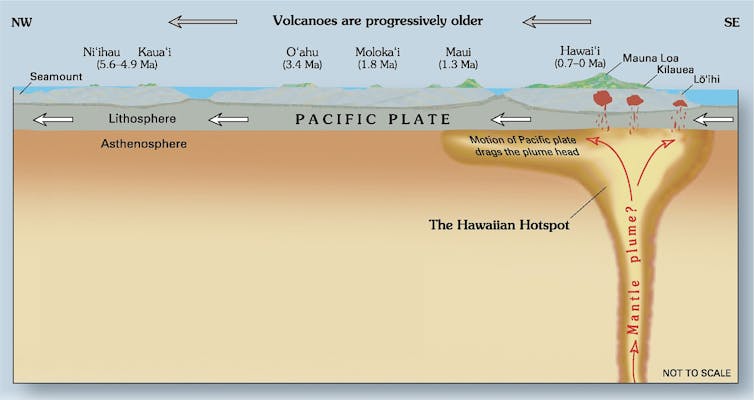
Earth’s crust is made up of tectonic plates that are slowly moving, at about the same speed as a fingernail grows. Volcanoes typically occur where these plates either move away from each other or where one pushes beneath another. But volcanoes can also be in the middle of plates, as Hawaii’s volcanoes are in the Pacific Plate.
The crust and mantle that comprise the Pacific Plate cracks at different places as it moves northwestward. Beneath Hawaii, magma can move upward through the cracks to feed different volcanoes on the surface. The same thing happens at Haleakala, on Maui, which last erupted about 250 years ago.
How Does Molten Rock Travel From Deep In Earth’s Mantle, And What Exactly Is A Mantle Plume?
Scientists hypothesize that the mantle is not made of uniform rock. Instead, differences in the type of mantle rock make it melt at different temperatures. Mantle rock is solid at some places, while it starts to melt at other places.
The partially molten rock becomes buoyant and ascends toward the surface. The ascending mantle rock is what makes a mantle plume. Because the overlying pressure lessens as the rock ascends, it melts more and more, and eventually collects in the magma chamber. If a large enough opening exists at the surface, and enough volcanic gases have collected in the magma chamber, the magma is forced to the surface in a volcanic eruption.
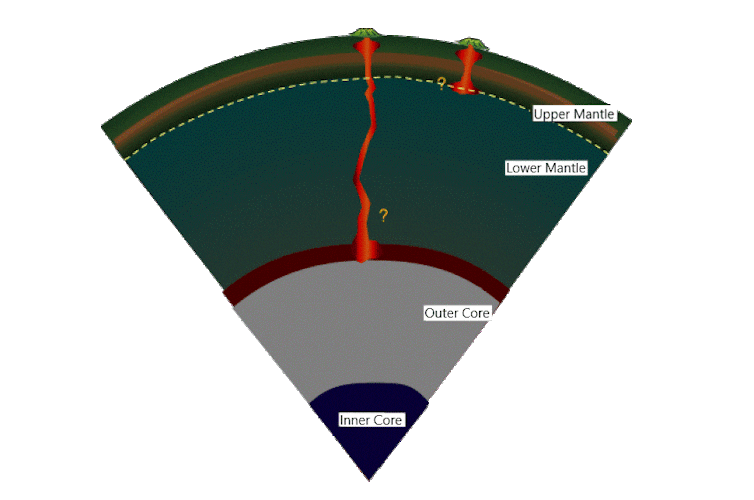
Seismic imaging by research teams I’m involved with has shown that Hawaii’s mantle plume comes from deep inside the mantle.
But the plume is not a straight pipe as some concept figures suggest. Instead, it has twists and turns, originally coming from the southeast, but then turning toward the west of Hawaii as the plume reaches into the shallower mantle. Cracks in the Pacific Plate then channel the magma upward toward the magma chamber beneath the island of Hawaii.
Why Does Hawaii Typically See Less Dramatic Eruptions Than Other Locations?
Hawaii is in the middle of an oceanic plate. In fact, it is the most isolated volcanic hot spot on Earth, far away from any plate boundary.
Oceanic magma is very different from continental magma. It has a different chemical composition and flows much more easily. So, the magma is less prone to clog volcanic vents on its ascent, which would ultimately lead to more explosive volcanism.
How Do Scientists Know What Is Happening Under The Surface?
Volcanic activity is monitored with many different instruments.
The perhaps simplest to understand is GPS. The way scientists use GPS is different from that of everyday life. It can detect minuscule movements of a few centimeters. On volcanoes, any upward movement on the surface detected by GPS indicates that something is pushing from underneath.
Even more sensitive are tiltmeters, which are in essence the same as bubble levels that people use to hang pictures on a wall. Any change in the tilt on a volcano slope indicates that the volcano is “breathing,” again because of magma moving below.
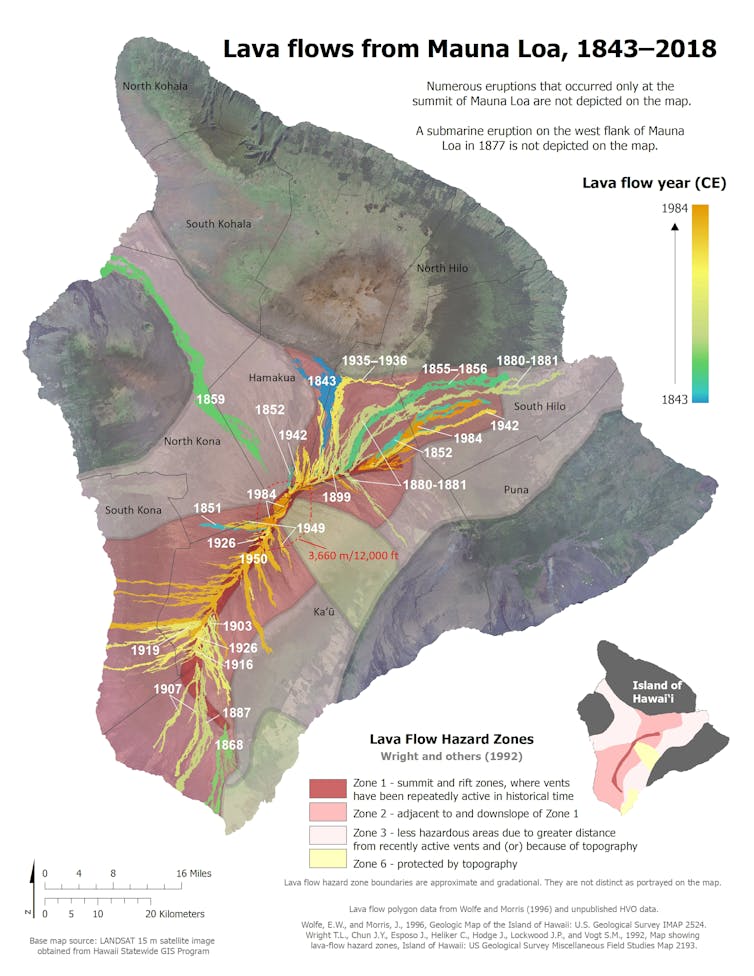
A very important tool is watching for seismic activity.
Volcanoes like Hawaii’s are monitored with a large network of seismographs. Any movement of magma below will cause tremors that are picked up by the seismometers. A few weeks before the eruption of Mauna Loa, scientists noticed that the tremors came from ever shallower depths, indicating that magma was rising and an eruption might be imminent. This allowed scientists to warn the public.
Other ways that volcanic activity is monitored includes chemical analysis of gases coming out through fumaroles – holes or cracks through which volcanic gases escape. If the composition changes or activity increases, that’s a pretty clear indication that the volcano is changing.![]()
Gabi Laske, Professor of Geophysics, University of California, San Diego
This article is republished from The Conversation under a Creative Commons license. Read the original article.
Spotify Wrapped, Apple Music Replay and Instafest: what do end of year music wrap-ups say about our listening habits?

Now that we’ve hit December, many people looking on their social media feeds will be seeing end-of-year listening roundups like Instafest, Spotify Wrapped and Apple Music Replay. These roundups analyse your music listening for the year to generate a fancy, shareable social media post, and they sometimes have some fascinating insights about our listening.
We increasingly live in a social media world where now is prioritised – with the constant torrent of new posts and tweets and reels and Tiktoks, trying to find something from even a couple of weeks ago can be a challenge - especially because our memories are not so accurate.
This means part of the fascination with these listening roundups is that they’re a stocktake of the year. But also, they have insights into the way that we listen to music that might surprise some people.
We Don’t Get Tired Of Our Favourite Songs
In the last decade or so, the singles charts in Australia have moved from being based on sales, to being based largely on plays on streaming services like Spotify, Apple Music and Tidal.
The charts have become increasingly static as a result of being based on plays – for example, Heat Waves by Glass Animals is currently at #13 in its 103rd week in the ARIA charts. Because the charts are based on plays, this fairly clearly shows that a lot of people continue to keep Heat Waves on their streaming playlists years later – they’re seemingly not bored of the song yet.
Part of what explains the continued endurance of such songs in people’s playlists is what social psychologist Robert Zajonc dubbed the Mere Exposure Effect. In a research program started in the 1960s, Zajonc has found consistently that our preference for stimuli is influenced by our familiarity with those stimuli – in other words, we are inclined to like what’s familiar. Chances are that, if we know a song fairly well, we like it. And if we like it, we don’t remove it from our playlists.
Of course, this isn’t the whole story. We obviously often get sick of songs, and we’re not purely robots programmed to like things based on familiarity. Mind you, if I look at my listening stats for the year, my top artist – the one I listened to the most – turns out to be the Beatles.
This is a band in some of my earliest musical memories. Surely, decades after I first heard it, I should be very tired indeed of their song I’m So Tired – but it appears that I am not. Which means some people looking at their roundups might be surprised just how long some songs and artists actually have lasted in their playlists.
We Love To Remember Our Favourite Music From The Year
We human beings often don’t remember very much, when it comes down to it. In an 1885 book, German psychologist Hermann Ebbinghaus describes experiments he conducted on his memory, trying to remember a list of nonsense syllables (ZUG or KUS, etc.): he discovered the “forgetting curve”. An hour after learning the syllables, he could remember around 40%. Nine hours later, he could remember about 30%. Six days afterwards, his memory for the nonsense words was at about 20%, which is where it stayed afterwards.
And Ebbinghaus was deliberately trying to remember those nonsense syllables. Most of the time when you listen to music, you’re probably not even paying attention to it, let alone trying to remember it. Personally, my memory of what music I was listening to six days ago is definitely less than 20%! This might be one reason that we genuinely don’t realise that we’ve spent so much of the year listening to that Lizzo song.
In contrast, streaming service algorithms record every second you spend listening to music (not least because counting it up is a neat fact for all the social media posts we’re seeing right now).
We Love Different Music For Different Situations
Research suggests that when the average person listens to music, they’re mostly wanting background music to accompany various tasks – driving, doing the dishes, exercising, studying, hanging out with friends, etc. However, when we think about the music we listen to, I suspect we often think about music we actively listen to - so sometimes the music that we passively listen to in our earbuds when nobody else can hear can be surprising.
Music is also inherently a social activity – it says something about how we relate to the broader society around us if we choose to listen to metal or to indie rock or K-pop; genres of music are usually related to subcultures and movements within society.
The tension between the two – that the music that is good at accompanying drudgery might not always be the music that expresses who we are – can lead to some interesting insights into other people when we look at their end-of-year roundups.
We Love Hooks
And of course, sometimes a song transcends social setting, where we can’t resist a hook even if we do find it to be a guilty pleasure. Hooks are those musical moments that stand out and are easily remembered – they’re most likely the bits that get stuck in our head, that we anticipate when we listen to the music, and they’re integral to pop music.
These days, producers like Max Martin carefully structure pop songs like Shake It Off by Taylor Swift to maximise the sheer amount of attention-grabbing musical moments, and we’re often powerless to resist getting them stuck in our heads after a few listens. Of course, if you’re a guy with long hair wearing an Iron Maiden t-shirt, why would anyone suspect that you’re listening to Taylor Swift’s Anti-Hero in your earbuds?
One way to look at it is that “It’s me, hi, I’m the problem, it’s me” – one line in Anti-Hero by Taylor Swift, the current #1 single in Australia – is clearly a memorable hook for a lot of listeners. That hook meant people noticed the song, and they added it to a playlist or two. Where it stayed, becoming familiar, becoming a part of life.
Finally, because of our typically porous human memories, we often don’t realise how often things end up in our ears. And so, when that Iron Maiden t-shirt guy posts his Spotify Wrapped on social media, he’s as surprised as anyone else that Anti-Hero is up amongst his top songs, next to Run To The Hills.
This is perhaps what is interesting about such roundups - they give an insight into the everyday listening habits of our friends, about what they listen to when we’re not looking.![]()
Timothy Byron, Lecturer in Psychology, University of Wollongong
This article is republished from The Conversation under a Creative Commons license. Read the original article.
BlueWalker 3, an enormous and bright communications satellite, is genuinely alarming astronomers
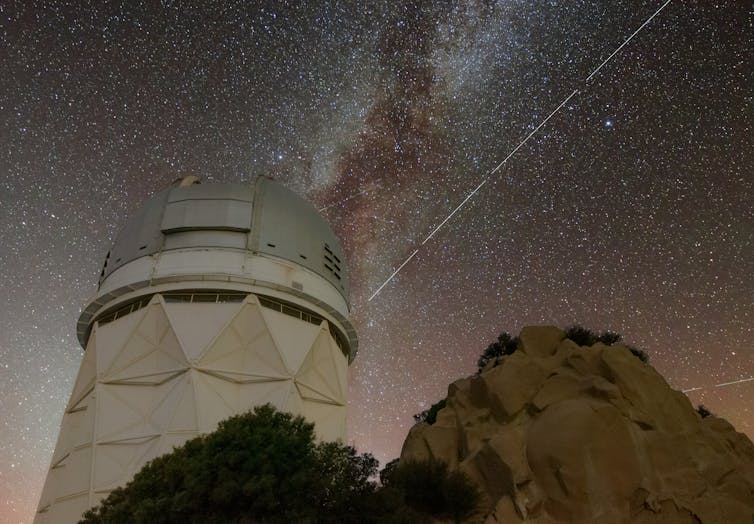
The night sky is a shared wilderness. On a dark night, away from the city lights, you can see the stars in the same way as your ancestors did centuries ago. You can see the Milky Way and the constellations associated with stories of mythical hunters, sisters and journeys.
But like any wilderness, the night sky can be polluted. Since Sputnik 1 in 1957, thousands of satellites and pieces of space junk have been launched into orbit.
For now, satellites crossing the night sky are largely a curiosity. But with the advent of satellite constellations – containing hundreds or thousands of satellites – this could change.
The recent launch of BlueWalker 3, a prototype for a satellite constellation, raises the prospect of bright satellites contaminating our night skies. At 64 square metres, it’s the largest commercial communications satellite in low Earth orbit – and very bright.
Pollution Of The Night Sky
While spotting satellites in the night sky has been a curiosity, the accelerating number of satellites in orbit means pollution of the night sky could become a serious problem.
On a clear night, particularly near twilight, you can see satellites travelling across the night sky. These satellites are in low Earth orbit, just a few hundred kilometres above Earth and travelling almost 8 kilometres every second.
Apps and websites allow you to identify or predict the arrival of particular satellites overhead. And it is genuinely fun to see the International Space Station travelling by, realising that on that speck of light there’s a crew of astronauts.
But in the past few years, the pace of satellite launches has accelerated. SpaceX has made satellite launches cheaper, and it has been launching thousands of Starlink satellites that provide internet services.
Roughly 50 Starlink satellites are launched into orbit by each Falcon 9 rocket, and initially produce a bright train of satellites. These initially produced UFO reports, but are now sufficiently common to not be particularly newsworthy.
Once the Starlink satellites disperse and move to their operational orbits, they are near the limit of what can be seen with the unaided eye.
However, such satellites are bright enough to produce trails in images taken with telescopes. These trails overwrite the stars and galaxies underneath them, which can only be remedied by taking additional images. Short transient phenomena, such as a brief flash from a gamma ray burst, could potentially be lost.

BlueWalker 3
While Starlink is the largest satellite constellation in service, with thousands of satellites in orbit, others are planned.
Amazon’s Blue Origin plans to launch more than 3,200 Project Kuiper satellites, and AST SpaceMobile plans to launch 100 BlueBird satellites (and perhaps more).
The recently launched BlueBird prototype, BlueWalker 3, has produced genuine alarm among astronomers.
While BlueWalker 3 was initially quite faint, it unfolded a 64 square metre communications array – roughly the size of a squash court. This vast surface is very good at reflecting sunlight, and BlueWalker 3 is now as bright as some of the brightest stars in the night sky.
It’s possible the operational BlueBird satellites could be even bigger and brighter.

Large numbers of satellites this bright could be bad – very bad. If there were thousands of satellites this bright, sometimes you would be unable to look at the night sky without seeing bright satellites.
We would lose that sense of wilderness, with an almost constant reminder of technology in our sky.
There could be a big impact on professional astronomy. Brighter satellites do more damage to astronomical images than faint satellites.
Furthermore, many of these satellites broadcast at radio frequencies that could interfere with radio astronomy, transmitting radio waves above remote sites where radio observatories observe the heavens.
A Precipice?
What happens next is uncertain. The International Astronomical Union has communicated its alarm about satellite constellations, and BlueWalker 3 in particular.
However, the approval of satellite constellations by the US Federal Communications Commission has had relatively little consideration of environmental impacts.
This has recently been flagged as a major problem by the US Government Accountability Office, but whether this leads to concrete change is unclear.
We may be on the edge of a precipice. Will the night sky be cluttered with bright artificial satellites for the sake of internet or 5G? Or will we pull back and preserve the night sky as a globally shared wilderness? ![]()
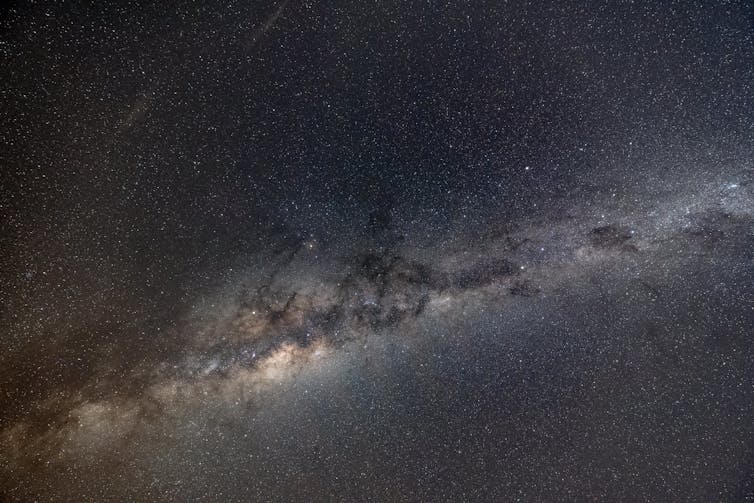
Michael J. I. Brown, Associate Professor in Astronomy, Monash University
This article is republished from The Conversation under a Creative Commons license. Read the original article.
How can you tell if something is true? Here are 3 questions to ask yourself about what you see, hear and read


Curious Kids is a series for children of all ages. If you have a question you’d like an expert to answer, send it to curiouskidsus@theconversation.com.
How can I tell if what I am hearing is true? – Adam, age 10, Maui, Hawaii
Have you ever heard a story so exciting you wanted to share it right away? Something like a shark swimming up a flooded highway?
An image that seems to show just that was shared by many people after Hurricane Ian struck Florida in 2022. It was also widely shared after Hurricane Harvey hit Houston, Texas, in 2017. It’s a fake – a flooded highway image combined with one of a great white shark. The fact-checking website Snopes found it circulating as far back as 2011 after Hurricane Irene slammed Puerto Rico.
Truth can be tricky to determine. Every message you read, see or hear comes from somewhere and was created by someone and for someone.
I teach media literacy, which is a way to think about information you get in the messages you receive via media. You might think media means the news, but it also includes TikTok posts, television, books, advertisements and more.
When deciding whether to trust a piece of information, it’s good to start with three main questions – who said it, what evidence did they give and how much do you want to believe it? The last one might seem a little strange, but you’ll see why it’s important by the end.
Who Said It?
Let’s say you’re really excited about a game that’s coming out later this year. You want to be the first to learn about the new creatures, characters and game modes. So when a YouTube video pops up saying, “GAME COMING TWO WEEKS EARLY,” you can’t wait to watch. But when you click, it’s just a guy making predictions. Do you trust him?
A source is where information comes from. You get information from sources every day – from teachers, parents and friends to people you’ve never met on news sites, fan channels and social media. You probably have sources you trust and ones you don’t. But why?
Would you trust your history teacher to tell you something about history? Probably, because they have a college degree that says they know their stuff. But what if your history teacher told you a fact about science your science teacher said was untrue? You’d probably be better off going with the science teacher for your science facts. Just because a source is trustworthy in one subject doesn’t mean they’re trustworthy in every subject.
Let’s go back to the YouTuber. If you’ve watched him for a while and he’s reliably correct, that’s a good start. At the same time, make sure you don’t confuse his having an opinion with actually having knowledge. Just because you like a source doesn’t make it trustworthy.
This is true for websites, too. When a site grabs your attention, take a second to check the source at the top. Some fake sites use names that sound trustworthy – like “Boston Tribune” instead of “Boston Globe” or “www.cbs.com.co” instead of “www.cbs.com.” You can click the “About” page to see where they’re really coming from, use lists of known fake sites and other fact-checking resources to avoid getting played.

What’s The Evidence?
Evidence is what you show when someone says “prove it!” It’s the details that support what a source is saying.
Primary sources – people or groups who are directly involved with the information – are best. If you want to learn about the release of a new game, the company’s official accounts or channels would be primary sources.
Secondary sources are one step removed – for example, news stories based on primary sources. They aren’t as strong as primary sources but are still useful. For example, most news on gaming site IGN is based on information from game company sources, so it’s a good secondary source.
Can a blogger or YouTuber be a secondary source? If their claims start by referencing primary sources like “Electronic Arts says,” that’s good. But if they start with “I think” or “There’s a lot of buzz,” be careful.
Do You Want To Believe It?
Emotions can get in the way of knowing what’s true. Messages that make you feel strong emotions – especially ones that are funny or make you angry – are the most important ones to check, but they’re also the hardest to ignore.
Advertisers know this. Many ads try to be funny or make the things they’re selling look cool because they want you to focus on how you feel rather than what you think. And being older doesn’t mean you’re automatically better at spotting false information: 41% of 18-to-34-year-olds and 44% of adults 65 and older admitted to having fallen for a fake news story in a 2018 study. Other research showed adults over 65 were seven times as likely to share articles from fake sites as younger people were.
So if you’ve been eagerly waiting for that new game, and somebody posts a video that says it’s coming out early, your wanting it to be true can make you ignore your common sense – leaving you open to being fooled.
The best question you can ask yourself when you’re thinking about a message is, “Do I want to believe this?” If the answer is yes, it’s a good sign you should slow down and check the source and evidence more closely.
Hello, curious kids! Do you have a question you’d like an expert to answer? Ask an adult to send your question to CuriousKidsUS@theconversation.com. Please tell us your name, age and the city where you live.
And since curiosity has no age limit – adults, let us know what you’re wondering, too. We won’t be able to answer every question, but we will do our best.![]()
Bob Britten, Teaching Associate Professor of Media, West Virginia University
This article is republished from The Conversation under a Creative Commons license. Read the original article.
Why does lightning zigzag? At last, we have an answer to the mystery

Everyone has seen lightning and marvelled at its power. But despite its frequency – about 8.6 million lightning strikes occur worldwide every day – why lightning proceeds in a series of steps from the thundercloud to the earth below has remained a mystery.
There are a few textbooks on lightning, but none have explained how these “zigzags” (called steps) form, and how lightning can travel over kilometres. My new research provides an explanation.
The intense electrical fields in thunderclouds excite electrons to have enough energy to create what are known as “singlet delta oxygen molecules”. These molecules and electrons build up to create a short, highly conducting step, which lights up intensely for a millionth of a second.
At the end of the step, there is a pause as the build-up happens again, followed by another bright, flashing leap. The process is repeated again and again.
An increase in extreme weather events means lightning protection is increasingly important. Knowing how a lightning strike is initiated means we can work out how to better protect buildings, aeroplanes and people. Also, while the use of environmentally friendly composite materials in aircraft is improving fuel efficiency, these materials increase the risk of lightning damage, so we need to look at additional protection.
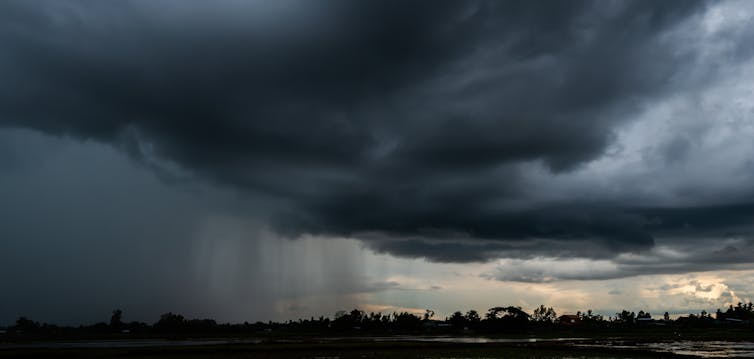
What Leads Up To A Lightning Strike?
Lightning strikes happen when thunderclouds with an electric potential of millions of volts are connected to the earth. A current of thousands of amps flows between the ground and the sky, with a temperature of tens of thousands of degrees.
Photographs of lightning reveal a host of details not observed by the naked eye. Usually there are four or five faint “leaders” coming from the cloud. These are branched and zigzag on an irregular path towards the earth.
The first of these leaders to reach the earth initiates the lightning strike. The other leaders are then extinguished.
Fifty years ago, high-speed photography revealed still more complexity. The leaders progress downwards from the cloud in “steps” about 50 metres long. Each step becomes bright for a millionth of a second, but then there is almost complete darkness. After a further 50 millionths of a second another step forms, at the end of the preceding step, but the previous steps remain dark.
Why are there such steps? What is happening in the dark periods between steps? How can the steps be electrically connected to the cloud with no visible connection?
The answers to these questions lie in understanding what happens when an energetic electron hits an oxygen molecule. If the electron has enough energy, it excites the molecule into the singlet delta state. This is a “metastable” state, which means it is not perfectly stable – but it usually doesn’t fall into a lower energy state for 45 minutes or so.
Oxygen in this singlet delta state detaches electrons (required for electricity to flow) from negative oxygen ions. These ions are then replaced almost immediately by electrons (which carry a negative charge) again attaching to oxygen molecules. When more than 1% of the oxygen in the air is in the metastable state, the air can conduct electricity.
So the lightning steps occur as enough of the metastable states are created to detach a significant number of electrons. During the dark part of a step, the density of metastable states and electrons is increasing. After 50 millionths of a second, the step can conduct electricity – and the electrical potential at the tip of the step increases to approximately that of the cloud, and produces a further step.
The excited molecules created in previous steps form a column all the way to the cloud. The whole column is then electrically conducting, with no requirement of an electric field and little emission of light.
Protecting People And Property
The understanding of lightning formation is important for the design of protection for buildings, aircraft and also people. While it is rare for lightning to hit people, buildings are hit many times – especially tall and isolated ones.
When lightning hits a tree, sap inside the tree boils and the resulting steam creates pressure, splitting open the trunk. Similarly, when lightning hits the corner of a building, water from rain that has seeped into the concrete boils. The pressure blasts off the whole corner of the building, creating the risk of deadly collapses.

A lightning rod invented by Benjamin Franklin in 1752 is basically a thick fencing wire attached to the top of a building and connected to the ground. It is designed to attract lightning and earth the electric charge. By directing the flow through the wire, it saves the building from being damaged.
These Franklin rods are required for tall buildings and churches today, but the uncertain factor is how many are needed on each structure.
Furthermore, hundreds of structures are not protected, including shelter sheds in parks. These structures are often made from highly conductive galvanized iron, which itself attracts lightning, and supported by wooden posts.
The new version of Standards Australia for lightning protection recommends such shelters be earthed.![]()
John Lowke, Adjunct Research Professor of Physics, University of South Australia
This article is republished from The Conversation under a Creative Commons license. Read the original article.
A Christmas Carol: with new movie Spirited, the Dickens classic continues to haunt us

There’s something about A Christmas Carol that screams: remake me! Some count as many as 100 versions of the Charles Dickens story spanning film, TV and even video games.
This year is no exception. There’s Netflix’s Scrooge: A Christmas Carol, countless stage productions including National Theatre Live’s A Christmas Carol: A Ghost Story and, perhaps most interestingly, Apple TV +’s Spirited.
But why is the story so popular? Notions that often-adapted works are somehow “universal” or “timeless” are dubious in an age of globalisation. Christmas is not universal, nor is the idea that the rich ought to share their wealth with the poor.
A Tale Ripe For Retelling
Film makers love Dickens’s Christmas story because of its brevity, strong protagonist, clear storyline, pithy dialogue, suspenseful incidents, emotional scenarios and happy communal ending.
Dickens energised A Christmas Carol by holding opposites in tension. The story features supernatural time travel, which is contrasted with its historical realism. Scrooge’s material wealth contrasts with Tiny Tim’s poverty. And the domestic setting of Scrooge’s home is at odds with the terror he feels at the arrival of the ghosts.
Spirited departs from all this. With a longer-than-average runtime (just over two hours), its two protagonists preclude a clear storyline, their many subplots compressed to momentary glimpses to make space for expansive musical numbers.

Director Sean Anders said that working on Spirited was “like directing two movies at once”. But Spirited is more than two genres with two protagonists. It is a multifaceted postmodern mashup, unfolding like a Christmas variety show.
Its diverse cast rushes between genres – from musical comedy to workplace drama – like a greatest hits revue of A Christmas Carol productions past.
The Ghost Of Adaptations Past
Characters are wryly aware of Spirited’s knowing haunting of itself by other adaptations of A Christmas Carol past: “Yes, like the Dickens book, and the Bill Murray movie, and every other adaptation nobody asked for.”
The production is more materially haunted by the talent of Christmas box office past, featuring (among others) Elf actor Will Ferrell and The Greatest Showman songwriters Benj Pasek and Justin Paul.

While this may point to the “timeless” and “universal” economic aspirations of the entertainment industry, adaptations like Spirited are very much of their own time, just as Dickens’s A Christmas Carol is very much of his.
Written in the “hungry forties” of the 1800s, a time of deep economic depression and harsh government policies towards the destitute, the story portrays middle-class fears of lower-class riots as a motivation to share wealth with the poor.
Today in austerity Britain, Dickens’s story is newly resonant, but US production Spirited, is unconcerned with economics. Its homeless are cared for in a shelter, and its orphan character Wren (Marlow Barkley) already has two adoptive fathers.
A Thoroughly Modern Remake
Released as US midterm votes were being counted, Spirited focuses on another social issue – social media. Social media, claims Spirited, turns people into trolls. It divides them and makes them abuse each other. It has the power to destroy lives.
In these ways, social media functions in Spirited much as money does in Dickens’s original. It divides rich and poor and is aided and abetted by savage, divisive politicians who use economic divides to foster their own wealth and power.
As Scrooge’s villainy lies in his misuse of money, Spirited’s corporate PR executive Clint Briggs’s (Ryan Reynolds) wrongdoing lies in his use of social media to pit users against each other in ways that benefit celebrities, politicians, and businesses.
While Scrooge’s real sin is against capitalism (his refusal to spend money), Briggs’s lies in circulating the bad currency of false and damaging information. Dickens was criticised for advocating voluntary, individual spending by the rich on the poor rather than changes to the economic, political and social systems that create and maintain inequality. Spirited’s solution, too, is for people to choose not to use social media abusively, rather than to change any laws or systems governing it.

Dickens’s ghosts seek to redress their poor economy by haunting those whose reform will have a wider impact. As the arch-influencer of social media influencers, for the ghosts of Spirited, Briggs is the biggest catch of the season.
Whether Spirited will be a hit, returning to haunt us for future Christmases, or relegated to the dustbin of A Christmas Carol films past remains to be seen. But we can be certain of future filmic hauntings by this book, endeavouring to wrestle with the present-day fears and nostalgic yearnings of audiences yet to come.![]()
Kamilla Elliott, Professor of Literature and Media, Lancaster University
This article is republished from The Conversation under a Creative Commons license. Read the original article.
Gifts of Christmas past: buy Second-hand to give your loved ones the gift of nostalgia and imagination

Christmas is a period for celebrating our relationships with family and friends – a time filled with nostalgia and sentimentality. Of course for many people it’s also a time of conspicuous consumption, even if this year in the face of a cost-of-living crisis, spending is expected to fall. But in times of uncertainty and anxiety for the future, feelings of nostalgia often come to the fore as people look back fondly on happier times.
Perhaps then, this Christmas is the time to move away from the tradition of splurging on new, box-fresh presents and give your loved ones the gift of the past.
Research shows that people like to receive sentimental gifts that remind them of cherished times and relationships. People appreciate gifts which remind them of treasured memories and help them to relive meaningful moments. Secondhand shops and markets are filled with objects that have value not because of their price, but because of their connection to people, places and times past.
We interviewed a number of vintage enthusiasts to explore the relationship people have with purchasing old objects. We’ve found that an item’s history, whether real or imagined, is what makes it a meaningful purchase. This is one reason vintage items would make great Christmas gifts.
Old objects have a history, a previous “life” before we come to own them secondhand. This might inspire consumers to think about the lives of previous owners, or imagine the journey the objects have been on. Part of people’s fascination with secondhand items is the associations and stories they develop around them through imagining their past. As one vintage enthusiast told us:
I think that filters down into why we buy secondhand stuff because you envisage all these fancy things, you imagine this certain world, and can attach it to them.
This fantasy can be a source of fun. When buying old things, we might get some details from person selling them, but we rarely get the whole story. This allows us to fantasise about the objects’ history to fill the gap – usually by mixing facts with imagination, creating a romanticised image of the past.
Consumers also develop their own narratives around an item, including the story of how they came to buy it, which they can share with others. A vintage trader we interviewed shared the imagined history of one of his treasured items, an Indo-Persian war shield he kept at home.
It’s had a life. At some point it’s been held by somebody with […] a sword […] possibly in a battle. It’s seen some action […] it may have only ever been ornamental, I don’t know, but, in my imagination, it’s had that life. Then you’ve got to wonder how it’s got from Indo-Persia to the charity shop in Oldham? […]. What’s been its journey?
Storytelling is a part of Christmas too. Just look at the television adverts, which compete for consumer attention by creating emotional or sentimental connections with viewers. Talking about the history of the presents you give and receive could be a great dinner table topic.
Sustainable Giving
Buying second-hand is also a way to consume more sustainably. Not only does it give items a second life, it might inspire you to take better care of the things you have.
Curatorial consumption, a concept from the field of consumer research, reflects a responsibility to preserve old items which hold some sort of significance that might be missing in contemporary times, such as craftsmanship. This is often done by acquiring, using or displaying the items, and then selling or giving them to others who can get the same pleasure from them. Many of these items are well-made and durable in contrast to today’s throwaway culture, so can be passed on to others again and again.

Sometimes, the recognition that an item has been cherished by a previous owner, might encourage some consumers to “continue loving it in the same way”, as one participant told us.
They’ve belonged to other people and they’ve been important to other people, and I think that’s really important to acknowledge. Most of the time, they’ve been very well made because things in the past […] weren’t made to be thrown away […] and there’s craftsmanship […] It’s been well made, it’s been well maintained until you got it, that means it’s been loved until the point at which you got it and I think you’ve got a responsibility to continue loving it in the same way.
Our research suggests that this circular way of consumption allows people to not only consume more responsibly, but also to connect with others with similar interests, helping build a sense of community and contribution.
As Black Friday and pre-holiday sales get underway, think instead about gift shopping at a local vintage shop or secondhand website. You may even start a new tradition by buying something old.![]()
Omar Khaled Abdelrahman, Lecturer, University of Huddersfield and Claire McCamley, Senior Lecturer in marketing, University of Huddersfield
This article is republished from The Conversation under a Creative Commons license. Read the original article.
Chlorophyll water can’t clear your skin or detox your liver. But this TikTok trend got one thing right

If you follow health trends online, you might have heard about “chlorophyll water”. Claims range from clearing your skin, stopping body odour, increasing energy and oxygen, to detoxing your liver and preventing cancer.
Chlorophyll water is sold as a liquid concentrate or already mixed with water. Numerous TikTok videos claim its health benefits.
Then there are celebrity endorsements for chlorophyll water, including from Kourtney Kardashian on her lifestyle channel.
So, what is chlorophyll water? And is it really a healthy choice?
Remind Me Again, What’s Chlorophyll?
What you might remember about chlorophyll from high-school science might sound pretty healthy.
Chlorophyll is the pigment that gives plants (and some algae and bacteria) their green colour. It is vital for photosynthesis, the process that uses sunlight to produce oxygen and chemical energy stored in the sugar glucose.

At the heart of most chlorophyll is magnesium – an essential nutrient for humans – needed for healthy nerves and muscles, regulating blood sugar and blood pressure, and building bones, proteins and DNA.
The chemical structure of chlorophyll looks a bit like protoheme. That’s the red part of our haemoglobin, the part of red blood cells that carries oxygen in our blood.
So, What Is Chlorophyll Water Then?
Water plus pigments that keep plants healthy, and that contain nutrients humans need, sounds great. Unfortunately, it’s not so simple.
First, chlorophyll doesn’t dissolve in water. So, what you get in these products isn’t “natural from plants”. It’s the molecule chlorophyllin. Chlorophyllin is made from chlorophyll by a process called saponification.
Essentially, this involves reacting it with sodium hydroxide and making a smaller molecule that is water-friendly. Then, to help it stay bright green, another reaction replaces the magnesium with copper, which is much more stable.
A more accurate name for these products would be “sodium copper chlorophyllin water”. But that’s not quite so marketable.

But Is It Healthy?
Just because it’s been converted from its natural form, doesn’t make it automatically unhealthy. So how do the health claims stack up?
There is lots of evidence about diets high in chlorophyll being healthy. But, since evidence is mostly diets high in green plant foods, this can’t be directly translated into water containing a processed derivative of one little part of green plants.
There is some evidence that comes from the extracted, processed form (chlorophyllin). But that’s mostly from animal or lab studies. These involve very high concentrations that would need you to drink dramatic levels of chlorophyll water to match the doses, or to inject it deep into your cells. To be clear, please don’t do either.
There are also some (mostly very small) studies about its impacts on skin and its use as a deodorant, but most of these are about applying chlorophylls and chlorophyllins directly to the skin. You don’t need to be a scientist to know that’s not the same as drinking it in water.
How about boosting your energy and oxygen? It might make sense on simple logic because this is what it does in plants, and the pigment’s similarities to haemoglobin.
But there is no data to support these claims. We do have a small pilot study of wheatgrass and the blood disorder thalassemia. But wheatgrass is much more complex than just chlorophyll and what helps someone with a disorder doesn’t necessarily make the rest of us healthier.
So Why Do So Many People Say They Feel Better?
First, who’s making the testimonials on social media? Do you trust them? Could it be advertising rather than someone’s own personal experience?
Second, it could be the “placebo effect”, where just taking something that feels like a treatment makes you feel better.
But most importantly, the main ingredient in chlorophyll water is water.
This is definitely an essential nutrient, and definitely something we want to encourage people to drink more of.
By turning to chlorophyll water, people may be simply increasing their water intake, and decreasing their intake of sugary drinks or alcohol. Improving hydration alone could explain their reports.
Are There Any Risks?
Excessive consumption (multiple doses a day) could cause some side effects such as nausea, stomach upsets, discolouring your poo and staining your teeth.
Like all supplements, there is a risk chlorophyll water may interact with medications. And there haven’t been big safety studies in at-risk groups, such as people who are pregnant or breastfeeding. So caution is advised.
But, stop and think about the potential indirect downsides of drinking chlorophyll water. It’s expensive. Chlorophyll concentrate, which you’d dilute with water, costs about A$16 for a 500mL bottle. So it could be an expensive way of increasing your water intake if you think you’re not drinking enough, given tap water is safe and cheap.
Even if there are any benefits, you could get these benefits from eating actual plant foods. So the money and time you spend buying chlorophyll water could be taking money and time away from other food and drink choices that could have much bigger health benefits.
The Bottom Line
If you like it, can afford it, and don’t have any medication risks, the choice is yours.
You could also try other ways to increase your chlorophyll intake, such as eating more green veggies. You could add cheaper things to water to make it appealing, such as mint, fruit or teas.
These options could be cheaper and have even better health impacts, but probably won’t get as many views on TikTok. ![]()
Emma Beckett, Senior Lecturer (Food Science and Human Nutrition), School of Environmental and Life Sciences, University of Newcastle
This article is republished from The Conversation under a Creative Commons license. Read the original article.
Where did the Earth’s oxygen come from? New study hints at an unexpected source
David Mole, Laurentian University; Adam Charles Simon, University of Michigan, and Xuyang Meng, University of MichiganThe amount of oxygen in the Earth’s atmosphere makes it a habitable planet.
Twenty-one per cent of the atmosphere consists of this life-giving element. But in the deep past — as far back as the Neoarchean era 2.8 to 2.5 billion years ago — this oxygen was almost absent.
So, how did Earth’s atmosphere become oxygenated?
Our research, published in Nature Geoscience, adds a tantalizing new possibility: that at least some of the Earth’s early oxygen came from a tectonic source via the movement and destruction of the Earth’s crust.
The Archean Earth
The Archean eon represents one third of our planet’s history, from 2.5 billion years ago to four billion years ago.
This alien Earth was a water-world, covered in green oceans, shrouded in a methane haze and completely lacking multi-cellular life. Another alien aspect of this world was the nature of its tectonic activity.
On modern Earth, the dominant tectonic activity is called plate tectonics, where oceanic crust — the outermost layer of the Earth under the oceans — sinks into the Earth’s mantle (the area between the Earth’s crust and its core) at points of convergence called subduction zones. However, there is considerable debate over whether plate tectonics operated back in the Archean era.
One feature of modern subduction zones is their association with oxidized magmas. These magmas are formed when oxidized sediments and bottom waters — cold, dense water near the ocean floor — are introduced into the Earth’s mantle. This produces magmas with high oxygen and water contents.
Our research aimed to test whether the absence of oxidized materials in Archean bottom waters and sediments could prevent the formation of oxidized magmas. The identification of such magmas in Neoarchean magmatic rocks could provide evidence that subduction and plate tectonics occurred 2.7 billion years ago.
The Experiment
We collected samples of 2750- to 2670-million-year-old granitoid rocks from across the Abitibi-Wawa subprovince of the Superior Province — the largest preserved Archean continent stretching over 2000 km from Winnipeg, Manitoba to far-eastern Quebec. This allowed us to investigate the level of oxidation of magmas generated across the Neoarchean era.

Measuring the oxidation-state of these magmatic rocks — formed through the cooling and crystalization of magma or lava — is challenging. Post-crystallization events may have modified these rocks through later deformation, burial or heating.
So, we decided to look at the mineral apatite which is present in the zircon crystals in these rocks. Zircon crystals can withstand the intense temperatures and pressures of the post-crystallization events. They retain clues about the environments in which they were originally formed and provide precise ages for the rocks themselves.
Small apatite crystals that are less than 30 microns wide — the size of a human skin cell — are trapped in the zircon crystals. They contain sulfur. By measuring the amount of sulfur in apatite, we can establish whether the apatite grew from an oxidized magma.

We were able to successfully measure the oxygen fugacity of the original Archean magma — which is essentially the amount of free oxygen in it — using a specialized technique called X-ray Absorption Near Edge Structure Spectroscopy (S-XANES) at the Advanced Photon Source synchrotron at Argonne National Laboratory in Illinois.
Creating Oxygen From Water?
We found that the magma sulfur content, which was initially around zero, increased to 2000 parts per million around 2705 million years. This indicated the magmas had become more sulfur-rich. Additionally, the predominance of S6+ — a type of sulfer ion — in the apatite suggested that the sulfur was from an oxidized source, matching the data from the host zircon crystals.
These new findings indicate that oxidized magmas did form in the Neoarchean era 2.7 billion years ago. The data show that the lack of dissolved oxygen in the Archean ocean reservoirs did not prevent the formation of sulfur-rich, oxidized magmas in the subduction zones. The oxygen in these magmas must have come from another source, and was ultimately released into the atmosphere during volcanic eruptions.
We found that the occurrence of these oxidized magmas correlates with major gold mineralization events in the Superior Province and Yilgarn Craton (Western Australia), demonstrating a connection between these oxygen-rich sources and global world-class ore deposit formation.

The implications of these oxidized magmas go beyond the understanding of early Earth geodynamics. Previously, it was thought unlikely that Archean magmas could be oxidized, when the ocean water and ocean floor rocks or sediments were not.
While the exact mechanism is unclear, the occurrence of these magmas suggests that the process of subduction, where ocean water is taken hundreds of kilometres into our planet, generates free oxygen. This then oxidizes the overlying mantle.
Our study shows that Archean subduction could have been a vital, unforeseen factor in the oxygenation of the Earth, the early whiffs of oxygen 2.7 billion years ago and also the Great Oxidation Event, which marked an increase in atmospheric oxygen by two per cent 2.45 to 2.32 billion years ago.
As far as we know, the Earth is the only place in the solar system — past or present — with plate tectonics and active subduction. This suggests that this study could partly explain the lack of oxygen and, ultimately, life on the other rocky planets in the future as well.![]()
David Mole, Postdoctoral fellow, Earth Sciences, Laurentian University; Adam Charles Simon, Arthur F. Thurnau Professor, Earth & Environmental Sciences, University of Michigan, and Xuyang Meng, Postdoctoral Fellow, Earth and Environmental Sciences, University of Michigan
This article is republished from The Conversation under a Creative Commons license. Read the original article.
In Fanatic Heart, Tom Keneally revisits the tumultuous life of an Irish rebel

As a child, I would visit the old house at the centre of family life and often there would be a conversation running thus:
“Have I told you about Clarrie Dobbs?” (or others of such names).
“Yes, Grandpa, many times.”
“Ah, he was a terrible bloke that Clarrie. When he was out well-sinking …”
Some stories just don’t let you go. And as you get older, the urge to get them all heard grows stronger. Tom Keneally has regularly stored away curious details and colourful characters from history, sometimes waiting until he found the form best suited to his dramatising of them, occasionally repeating them in different guises, once or twice finding the moment of topical discussion into which they could be blended.
Review: Fanatic Heart – Tom Keneally (Vintage).
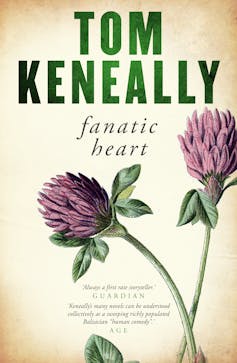
Keneally’s recent novel Corporal Hitler’s Pistol (2021), for example, picks up the setting and sub-plot of domestic violence of his earlier novel A River Town (1995), focuses it around a Kempsey legend from his childhood, and adds strands dealing with race relations and prejudice against gays. The Widow and her Hero (2007) finally found a framing point of view in which to recount a forgotten military venture in World War II that Keneally first wrestled with as a film script in 1980.
As part of his “paying respects to ancestors”, as he terms it, Keneally has spent a good deal of his writing career portraying the Irish in Australia – as famine-driven convicts, as political prisoners, as priests, and as romantic escapees, like the poet and activist John Boyle O’Reilly and the Irish nationalist Thomas Francis Meagher, who became popular figures in America.
One of this latter group, John Mitchel (1815-1875) has his story told in Keneally’s compendious history, The Great Shame: A Story of the Irish in the Old World and the New (1998), and is mentioned again in his Australians: Origins to Eureka (2009).
Mitchel’s life became another story that would not let its teller go. This exiled voice for the Young Ireland movement, later hailed as the country’s president-in-waiting, was a conundrum that called for imaginative exploration. How could a political idealist striving for his country’s freedom and his own liberty end up supporting slavery in the America he escaped to?
This is the question behind Keneally’s latest novel Fanatic Heart.
Women And Nationalism
Another consistent interest in Keneally’s fiction is women. His female characters have included suffering innocents, like the convict servant in Bring Larks and Heroes (1967) and the self-mortifying protagonist of Woman of the Inner Sea (1992), and heroic ones, like Joan of Arc in Blood Red Sister Rose (1974) and the nurse sisters in Daughter of Mars (2013).
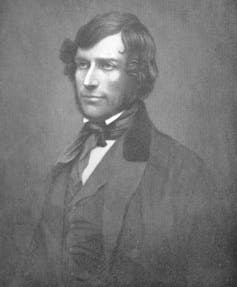
Keneally has been taken to task for his biologised depictions of his female characters, who either support or fall victim to males at the centre of stories, and he has made a point in the latter part of his career to give centre stage, social context, and voice to woman characters.
In Fanatic Heart, he turns our attention away from John Mitchel at regular intervals to concentrate on Mitchel’s long-suffering wife, Jenny. Their marriage was born of passion. Jenny Mitchel supported her husband’s outspoken nationalism, following him into exile in Van Diemen’s Land, then on to several locations in the United States once American Irish organised Mitchel’s escape from British control.
The novel is unusual, in that for the average reader it appears to be purely a novel. There are only a couple of hints at the back that John and Jenny were real people central to Ireland’s political history and that actual journals and newspaper columns inform the narrative.
This is probably because so much of the book does what historians have often objected to in Keneally’s work: his readiness to dramatise the people of historical record by imagining their feelings and filling in gaps between documented events.

As a novel, however, I’m not sure Fanatic Heart is entirely successful. Its historical roots prompt an external looking-back that results in a lot of telling rather than showing. The narrative does keep moving, but I didn’t get a strongly immediate sense of the “fanaticism” that made Mitchel so dangerous to the British.
Some editorial intervention would have improved things at times. At one point, a girl named Henty is mentioned and we have to track back some way to find that the Mitchels had a daughter, Henrietta, and then intuit that “Henty” is her nickname. Mitchel’s arrest is made under “an obscene law”, the name of which appears a page or so later, and the explanation of the law not for another page or two; some integration please. Equally, we don’t need to know that the sentencing magistrate was a former suitor of Jane Austen’s.
The Question Of Slavery
The book is at its best when it presents a dramatic scene, as with the opening one of an entire village of famine-devastated bodies, or later when there is a debate over slavery between John, Jenny, and the abolitionist Reverend Beecher. That encounter is the climax of the novel’s exploration of Mitchel as a mesh of contradictions.
I shall not be surprised if some readers charge Keneally with offering an apologia for slavery, but they should note that it is Mitchel speaking, that Jenny obviously does not support slavery, that Mitchel is captured by the false race science of the time, and that he does have some pertinent arguments against hypocritical fixation on one Southern social evil while ignoring the slavish conditions of (mostly Irish) workers under the North’s uncontrolled industrial capitalism.
As Mitchel and many writers since have lamented, a moment of ironic levity in print can leave one trapped between two camps of “know nothing” literalists.
The story ends on a high note, with the Mitchel family settling happily on a Tennessee farm (without slaves), freed from Britain and the frenetic rivalries of New York and Ireland. That resolution connects with the other focus of this tale of global movements: the family as held together by Jenny.
Fanatic Heart reworks the historical picture of John Mitchel that Keneally drew in The Great Shame. There, Mitchel was the touchy political rebel, who refused to call his comfortable life in Van Diemen’s Land anything other than enforced exile; in the fictive version, he is less inclined to escape when the opportunity arises. It is his wife who urges him back into his political role. Her place in the story also pushes John’s fellow exile, the flashy Thomas Meagher, into the background, faulting him for the shabby treatment of his Vandemonian wife.
There are many fascinating historical details in Fanatic Heart, such as Mitchel’s ambiguous social position as a Presbyterian/Unitarian Irishman and his almost successful persuasion of Russia to invade Ireland in support of its independence.
But novelistic happy endings rarely match the realities of history. Despite his interest in the American Civil War (seen in his novel Confederates and the biographical history An American Scoundrel), Keneally excises the last chapters of Mitchel’s story. Restless by temperament and from force of events, John continued to travel – to Paris, Washington, Richmond, and eventually back to Ireland. He ran a blockade back to the Confederacy, in support of which both his sons were killed. In a final contradiction, the “fanatic heart” sought Irish election to the British parliament just before his death.![]()
Paul Sharrad, University Fellow (Literature/Humanities), University of Wollongong
This article is republished from The Conversation under a Creative Commons license. Read the original article.
Summer Reading 2022-2023: We Of The Never Never
We of the Never Never is an autobiographical novel by Jeannie Gunn first published in 1908. Although published as a novel, it is an account of the author's experiences in 1902 at Elsey Station near Mataranka, Northern Territory in which she changed the names of people to obscure their identities. She published the book under the name Mrs Aeneas Gunn, using her husband's first and last name. Over the years, newspapers and magazine articles chronicled the fortunes of the Elsey characters. Jeannie outlived all but Bett-Bett.
Jeannie Gunn was the first white woman to settle in the Mataranka area. Her husband Aeneas was a partner in the Elsey cattle station on the Roper River, some 483 km (300 miles) south of Darwin. On 2 January 1902 the couple sailed from Melbourne for Port Darwin so that he could take up a job as the station's new manager. In Palmerston, Gunn was discouraged from accompanying her husband to the station on the basis that as a woman she would be "out of place" on a station such as the Elsey. However, she travelled south and her book describes the journey, settling in, and the difficulties of life in the bush. Jennie Gunn lived on the cattle station for about a year before her husband, Aeneas, died of malarial dysentery on March 16th 1903. Jeannie returned to Melbourne shortly afterwards and never returned to the Northern Territory.
The book is regarded as being significant as a precursor of the 1930s landscape writers. Already in 1908 Australia was a significantly urbanised country and the book was seen to provide symbols of things that made Australia different from anywhere else, underwriting an Australian legend of life and achievement in the outback, where "men and a few women still lived heroic lives in rhythm with the gallop of a horse" in "forbidding faraway places".

Four of the stockmen from Elsey Station in 1933 who were characterised in "We of the Never Never"
Characters from Aeneas Gunn's book 'We of the Never Never', 1933
Caption: Do you know the men in the above photograph? Probably not, yet thousands of boys and girls throughout Queensland during the past week have had the quartet intimately in their thoughts. They are the originals of characters in 'We of the Never Never', Mrs. Aeneas Gunn's classic tale of early Australian days, which was a textbook for the State scholarship examinations. They worked together on Elsy Station and had the first reunion since those days in 1933 when 'Truth's' photograph was taken. From left to right they are: Irish Mac, The Dandy, Mine Host and The Quiet Stockman. The first-named has since died. The other three are residents of South Australia. (Description supplied with photograph). Photo courtesy State Library of Queensland.
Health Funds Continue To Return Profits To Meet COVID-19 Commitments
Cochlear's Proposed Acquisition Of Oticon Medical Raises Preliminary Competition Concerns
Australia’s national anti-corruption agency arrives. Will it stand the test of time?
A J Brown, Griffith UniversityAustralia’s long-awaited National Anti-Corruption Commission (NACC) has become a legislative reality, after the House of Representatives today accepted a final amendment imposed by the Senate on Tuesday.
It’s the biggest reform to federal public accountability for over 40 years.
It’s also an historic step internationally. Specialist anti-corruption agencies are now widespread across many Asian, eastern European and developing countries, especially since the UN Convention Against Corruption in 2003.
But Australia is one of the first OECD countries to adopt such a far-reaching model at national level. Most others – like the United Kingdom, United States and New Zealand – still rely on traditional law enforcement agencies to root out official corruption, using just the criminal law.
By contrast, Australia has translated its state-based model of standing royal commissions against corruption to the national level.
Instituted in NSW in 1988 and Queensland in 1991, and since repeated everywhere but South Australia, this model differs from overseas approaches by extending strong inquiry powers to serious corruption risks, even if not necessarily criminal.
So after an 18-year gestation, how does this new national agency measure up against expectations, including other international standards?
Some key final debates of the last week provide the answers.
The best news is that the commission has been born with the unanimous support of all political parties. This multi-partisanship was initially reflected in a Senate Select Committee in 2017. But it disappeared after the Morrison Coalition government was pressured into putting forward, and defending, a deeply flawed model.
Forced to reverse this approach after losing the 2022 election, Coalition MPs contributed to six consensus recommendations from the joint select committee that reviewed the new Labor government’s vastly superior bill.
Accepted by the government, five of these led to positive improvements, from respect for media freedom and secrecy exemptions for health care support, to monitoring powers for the proposed parliamentary inspector.
However, against these “lowest common denominator” improvements, four final controversies raise question marks for the future.
4 Controversies Raise Question Marks
1. Public hearings
Most prominently, independent and Green members failed in attempts to either remove, or define, a threshold of “exceptional circumstances” before compulsory public hearing powers can be used by the commission.
Added late, in a relatively naked breach of the government’s pre-election promises, the test copies one used in Victoria. Fortunately, that has not proved fatal to the work of that commission. But almost everyone but the government and Coalition agrees the test is unnecessary and either legally or politically dangerous.
Given wide categories of “sensitive” evidence that the commission can never receive in public, it will have the most restrictive public hearing powers of any Australian anti-corruption body, as shown by a Griffith University and Transparency International Australia analysis (barring South Australia which has no such powers at all).
2. Scope of corruption
The government also slightly walked back the scope of corruption that can be tackled. It resisted cross-bench attempts to ensure corrupt non-government actors are fully covered, along with political “pork barrelling”. It also removed a catch-all that the commission could investigate “corruption of any other kind”.
But while less flexible than originally proposed, the scope remains simpler, less legalistic and uncomplicated compared to most state definitions.
3. Role of the inspector
The only area where the government was forced to accept an amendment by the Senate was a proposal by the Greens, supported by the Coalition, to provide clarity and purpose to the roles of the commission’s inspector.
A victim of the haste with which the government prepared its bill after being elected in May, this key safeguard of the legality and propriety of the commission has now been lifted to the standard of national best practice.
4. True independence?
The fourth and final controversy points to the challenges facing every anti-corruption body, but especially Australia’s outdated federal integrity system as it strives to catch up with the rest of the country.
Will the commission be seen as truly independent, financially and politically? This question lies at the heart of international standards, such as the 2012 Jakarta Principles, backed by the United Nations.
The NACC’s financial independence gets some support from a dedicated parliamentary oversight committee, which can review and support its budget.
But the government rejected cross-bench attempts and expert advice to give the commission the same status and budget support as the federal auditor-general. It also failed to heed the emerging best practice in New Zealand, NSW, Victoria and Queensland of a separate parliamentary budget track for core integrity agencies, which in Victoria are even recognised in the Constitution as independent officers of parliament.
Similarly, the government refused to embed a principle that the government of the day cannot just pick the commissioner all by itself. Cross-bench and Coalition amendments for more than just a government majority vote of the committee, to support or reject the recommended appointment, were vigorously opposed by the government.
By contrast, a requirement for bipartisan support is explicitly recognised in Queensland and Western Australia, and assumed in NSW and Victoria’s arrangements. It’s also often followed overseas. For example, the selection committee for the head of India’s Central Vigilance Commission includes the leader of the opposition.
Transparency International Australia recommended entrenching this principle through a two-thirds majority vote of the committee. In the select committee, and in amendments not ultimately put to a vote, the Coalition proposed an even stronger, three-quarters majority.
After reacting apoplectically to that idea on Tuesday morning, the government refused an attempt by the Greens and independent Senator David Pocock to require even one non-government member of the committee to also support the proposed appointment.
The lack of understanding of this important principle, now left out of the bill, is the clearest reminder that the Commonwealth’s integrity system is built on some shaky, out-of-date ground – even if this new commission itself is otherwise strong.
In fact, the government refused to support any amendments proposed by independent Helen Haines, to bring the government’s bill up to the standard of her own ground-breaking proposal.
Attorney-General Mark Dreyfus had told voters before the election the government’s package would be “extremely similar” to Haines’. But it has proved not to be, in significant respects.
The fact that Australia will now have a national anti-corruption commission is testament to the attorney-general’s leadership, over more than five years. And its many strong features promise to be a positive game-changer for public integrity in Australia, and likely beyond.
But as always, question marks remain over whether the new commission has been designed sufficiently to weather the future political storms that go with the job.![]()
A J Brown, Professor of Public Policy & Law, Centre for Governance & Public Policy, Griffith University
This article is republished from The Conversation under a Creative Commons license. Read the original article.
Cities, just not as we know them – get ready for NSW’s Six Cities Region

Australia’s first multi-city region, the Six Cities Region, is being developed in New South Wales. A multi-city region, also known as a mega-region, establishes an integrated network of globally and locally connected cities.
The Six Cities Region spans the Lower Hunter and Greater Newcastle City, Central Coast City, Illawarra-Shoalhaven City, Western Parkland City, Central River City and Eastern Harbour City.

The region is home to around 6 million people. It’s expected to reach 8 million in the next two decades.
The Six Cities concept has evolved from the 2018 Greater Sydney plan, A Metropolis of Three Cities. Introduced by the then Greater Sydney Commission, the plan established the Western Parkland City, Central River City and the Eastern Harbour City. The priority then was to ensure housing, jobs, infrastructure and services were all within a 30-minute trip for more people.
Now, as the Greater Cities Commission, we are developing a response to the reality that cities can either compound or address some of society’s biggest challenges: inequality, congestion, pollution and social exclusion.
Released today, a research report by the Greater Cities Commission and The Business of Cities, entitled Greater Cities: The Global Experience of Planning, Preparing and Promoting the Multi-City Region, notes:
“We are in the middle of the century of cities – the hundred years of accelerated urbanisation from 1980 to 2080 that is creating a majority-urban planet.”
And the proportion of the world’s people who live in cities continues to increase. The United Nations predicts cities will house 6.9 billion people by 2050. Australia leads the way in urbanisation – close to 90% of us live in cities.
As pressures on urban centres rise, we must reimagine how we live, work and connect in our cities.
What Are The Challenges And Opportunities?
How do multi-city regions help us with ongoing housing challenges, cost-of-living increases and development constraints in central cities? Essentially, they do so by opening up opportunities across more connected centres. This distributes wealth across a larger region and provides more equitable access to healthcare, education and training facilities.
Through co-ordinated planning across all levels of government, multi-city regions also offer an opportunity to tackle key environmental challenges. These include climate change, urban heat and the effective roll-out of decarbonisation initiatives.
In the case of NSW, the network of six cities also responds to the pressures of rapid urban growth. It does so by redistributing this growth across a larger area and fuelling development in smaller or lower-demand areas.
In establishing the Six Cities Region, we join a global vanguard of up to 20 multi-city regions, which organise and co-ordinate their activities in different ways. What the Six Cities Region does share with other regions, however, is a need to manage high population growth along with huge demand for housing and lifestyle choices.

City regions also have to stay ahead of the curve in response to the disruptions of COVID and climate change. At the same time, they must balance and enhance opportunities for business, investment, culture, education and decision-making.
While we focus on the big-picture model in this article, it’s worth noting the Commission’s responsibilities are complex. It is setting and monitoring housing targets for each of the 43 local government areas within the six cities. The Commission must also identify how to achieve more diverse and affordable housing.
EXISTING HOUSING TYPES ACROSS THE SIX CITIES REGION

Work is under way to finalise 5, 10 and 20-year housing targets. These will be released in the region plan towards the end of 2023.
Balancing The Global With The Local
The Six Cities Region is home to three international airports, three deep seaports, a high concentration of world-class universities and globally significant innovation districts. It will help connect these gateways, institutions and innovation districts to accelerate economic growth, international trade and knowledge jobs.
The challenge and the opportunity lie in delivering globalised localism. This means opening up these six cities to more international growth and opportunities, while fiercely protecting their natural assets.
The region also has the exceptional asset of 65,000 years of continuous culture. We have the opportunity to embed the wisdom and aspirations of First Nations peoples in caring for Country and people, and knowledge sharing.
If successful, the equity and resilience of the region will be second to none. Everyone will have the opportunity to work in great jobs close to home. They will be able to live in vibrant, well-serviced neighbourhoods with diverse and affordable housing options.
Harnessing our enviable assets in a connected way will result in opportunities and benefits for everyone in the Six Cities Region. As the report explains:
“The Six Cities Region has many significant advantages over other mega-regions. These could, with the right shaping interventions, help the region become one of the most advanced and forward-thinking multi-city regions in the world over the next decade.”
Read the Greater Cities: Preparing and Promoting the Multi-City Region report here. You can learn more about multi-city regions around the world via the Greater Cities podcast.![]()
Geoff Roberts, Adjunct Professor, City Futures Research Centre, UNSW Sydney
This article is republished from The Conversation under a Creative Commons license. Read the original article.
You’ve got a friend: young people help each other with their mental health for 3.5 hours every week

Young people experience mental health difficulties at a higher rate than any other age group.
While there’s ongoing discussion about the formal supports they need, young people say they’re most likely to speak with peers and friends – particularly when mental health care is difficult to access.
In partnership with youth mental health charity batyr and clinical expertise, we undertook a national survey and conducted focus groups with young people (aged 16–25 years).
We wanted to understand how young people support each other and what resources they need to keep caring for their friends in safe ways.
A Critical Resource
Our research included a national survey with 169 young people, as well as focus group discussions with 34 young people from Melbourne and Sydney. We found young people provide on average 3.5 hours per week of support for friends, or about 182 hours each year.
Participants spoke about being there for friends whenever they needed them, and 76% agreed friends provide critical support – often more than mental health professionals and parents or guardians.
Yeah, I think it’s easier and less confrontational talking to friends rather than family or a professional.
– Mackenzie*
This support includes assisting during tough times (such as during a relationship or family breakdown) and support due to health or financial difficulties, exam stress, as well as mental health distress. Almost 95% of young people in our study said they had helped a friend through mental ill-health.
Emotional support means “being there” for a friend, but it includes other assistance too, such as financial help, temporary housing, or connecting friends with professional services.
Young people discussed being able to provide immediate support to each other. This support is ongoing and involves more than just one encounter.
Personalised, Dynamic Support
All the young people we spoke to said their support changes depending on the friend, time, place and situation. Malis told us:
I think it just depends on the person and sort of like their approach to certain things […] it also just depends on the context.
They emphasised there is not a “one size fits all” approach. As Ari said:
Giving support, it’s not a formulaic thing.

Tailoring An Approach To Their Friends’ Needs
While there is no single approach, there are some common components to how young people support their friends.
A common first step is noticing something is wrong. This might be a mood change observed in person or online.
You know when they’re just not talking as much or they’re not really, you know, interacting with anyone [then] you kind of say ‘Okay, something’s wrong here’.
– Lara
They spoke about carefully and strategically starting conversations to make it easier for their friends to talk. Young people say this requires more than asking “Are you OK?”. Ash told us it was about “being a lot more specific and directing questions with a bit more intent”.
Sometimes friends approach them, and they spoke about being ready for them when and where they were needed; being on “standby”, as Malis put it.
Support takes place in-person and online, and sometimes moves between the two settings. Omar said a friend might start chatting on a train “and then they go online and start talking”.
Providing The Right Support 5 Ways
Young people say providing the right support and response means working out what their friend needs, whether they want advice (or not), and taking into account their cultural background.
They spoke about taking the following actions:
sharing their own lived experiences and what worked for them
finding online resources about the issue a friend was going through and forwarding details to them
finding lists of accessible professionals and supports
taking a friend along to a mental health professional, or organising their visit with a mental health professional
talking to someone in their immediate family or network to get their friend the support they needed, though this was often considered a last resort.
The young people we spoke to said they avoided unnecessary engagements with adults. They felt they’d been entrusted with their friend’s concerns and needs. Adults were frequently seen as not understanding issues around mental health more generally.
However, if they thought a problem was beyond their control or expertise, then they would seek outside help. As Shalani said:
If I feel like it’s out of my area of expertise or something, I would probably think it’s better for them to like go elsewhere.

Helping Themselves Too
Young people can sometimes take on too much responsibility for their friends. Young people in the study spoke about how they look after themselves to create healthy boundaries. Celine had learnt this the hard way and said:
Ultimately you can help your friend, but then you’ve got to make sure that you’re okay first to do that.
However, sometimes the lines between being a good friend and supporter and maintaining self-care were difficult. As Sam said:
I have found it difficult when I was having a hard day and had to be their support person for the whole day. It’s also difficult when you are out of the house (with family or other friends) and can tell they need you at that moment but you don’t really have the time, but you make time anyway.
Some young people didn’t provide help to a friend because they were worried about saying the wrong thing or putting the friendship at risk by expressing concern.
Helping Them Help Each Other
This study shows the critical work young people are doing to informally support each other.
We need to recognise the expertise of these young people, particularly when there are difficulties accessing formal mental health support.
We need to think about how we best resource young people in acceptable ways, so they have the tools to continue to support friends and manage feelings of responsibility.
We need to develop services and responses that include friends, and we need to create and foster public and online spaces where young people feel comfortable supporting each other, including on social media.
And ultimately, we need to address many of the underlying fundamental issues that result in tough times for young people – poverty, uncertainty, exclusion and discrimination – the social drivers that lead to and exacerbate tough times.
*Names have been changed to protect participants’ privacy.
If this article has raised issues for you, or if you’re concerned about someone you know, call Lifeline on 13 11 14.![]()
Benjamin Hanckel, Senior research fellow, Western Sydney University; Amelia Henry, Research Assistant; Erin Dolan, Honorary Fellow / Clinical Psychologist, The University of Melbourne, and Jasbeer Musthafa Mamalipurath, Research officer, Institute for Culture and Society, Western Sydney University
This article is republished from The Conversation under a Creative Commons license. Read the original article.
‘Zombie’ wage deals have hurt Australians for years. Here’s how new industrial relations laws could finally end your wage pain

Imagine you were trying to design a system that would hold back wages. You would design one pretty much like the one we’ve got today.
That’s why the government wants to change it.
Those of us on enterprise bargaining agreements get our wage rises locked in only every three or so years. If we didn’t lock in enough in last year’s agreement to cover this year’s sudden outbreak of inflation, there’s nothing much we can do about it for another two or so years.
It’s a built-in inertia identified by financial services firm JP Morgan in its attempts to explain to foreign clients why Australian wages growth is so low.
Australian enterprise agreements, JP Morgan explains in a note to clients, both delay wages growth and trim its peaks.
Here’s how that came about – and how the Albanese government’s new industrial relations law might finally end Australians’ pay freeze.
Wages Used To Be Mostly Set By Awards
For nearly a century, Australian wages were generally set by judges in state and federal industrial relations tribunals. They had the power to intervene and set an “award” wage for an industry or occupation in which there was a dispute. And it was easy enough for unions and employers to create disputes.
Because they almost always intervened, the tribunals got to ensure that wages didn’t move too much relative to each other, and it got an insight into the state of the economy from the government, which made submissions.
From one point of view, the strength of this peculiarly Australian system of setting wages was that each employer covered by a decision was compelled to deliver the same increase as its competitors, meaning none were disadvantaged.
From another point of view, this strength was becoming a weakness. The weak firms as well as the strong had to pay the increases, whether it was easy or not.
Enterprise Agreements Unleashed Productivity
In the early 1990s, perhaps with an eye to the possibility that an incoming Coalition government might make even greater changes, the Keating Labor government changed the law to channel the workers and employers within each workplace into enterprise bargaining.
The tribunals would have a more limited role, checking that each enterprise agreement passed a “better off overall” test, and continuing to set awards that became more like backstops, slipping below what most workers (usually through their unions) were able to negotiate with individual employers.
Workers and unions did well at first, because they were able to get together with employers and nut out ways to save money to pay for wage rises – something they had had little incentive to do when wages were set centrally.
And it was something that could only really be done at the level of each enterprise, because each was different, and it was the workers on the ground who knew how to make it better.
Zombie Agreements And Frozen Wages
But productivity couldn’t be unleashed in the same way forever. After a while, the easy gains had been had. Workers got good pay rises in return for streamlining unwieldy processes at the start, then had few unwieldy processes left to streamline.
Productivity surged during the first decade, until the early 2000s. Then employers became more cautious about granting pay rises, and by the 2010s became good at stringing out negotiations or letting agreements expire, which meant they rolled over as “zombie agreements” without an increase.

As the Business Council explained in a report on the state of enterprise bargaining in 2019, agreements that had lapsed but were still operational came to act “like a wage freeze for some employees”.
With union membership down from 40% of workers when enterprise bargaining began, to just 14% in 2020, there was little workers on frozen agreements could do to get more, other than fall back on awards, which at least usually climbed with inflation.
It means the system has come to work in a way hardly anyone actually intended. It is acting as a brake on pay rises, while becoming more centralised.
The Reserve Bank says it can see some signs that wages growth is picking up, even in new enterprise agreements, but that it will take some time to flow through to all agreements in general because of the “multi-year duration” of the agreements.
How The New Law Could Break The Pay Freeze
What the Albanese government has proposed – and is about to finally get through the Senate with the help of the Greens and independent David Pocock – is an attempt to bust the inertia.
Expanding multi-employer bargaining will allow employers to bargain knowing their competitors will have to pay what they pay.
Air-conditioning manufacturers have already begun talks with the Australian Manufacturing Workers Union in a bid to drive up workplace standards and pay in a way they know won’t be undercut by cheaper competitors.
Allowing employers with genuine ongoing enterprise agreements to escape multi-employer bargaining will encourage more genuine agreements.
And loosening the “better off overall” test will make it easier to get agreements of all kinds registered.
Particularly helpful will be “supported bargaining”, in which the Fair Work Commission will sit around the table with workers in fields such as childcare, who have traditionally found it hard to bargain. Where necessary, the commission will pull in outside funders (such as the government for childcare) for talks.
None of it will work miracles. But it should help. And it’s unlikely to hurt.![]()
Peter Martin, Visiting Fellow, Crawford School of Public Policy, Australian National University
This article is republished from The Conversation under a Creative Commons license. Read the original article.
Do tenancy reforms to protect renters cause landlords to exit the market? No, but maybe they should
Chris Martin, UNSW Sydney; Milad Ghasri, UNSW Sydney; Sharon Parkinson, Swinburne University of Technology, and Zoe Goodall, Swinburne University of TechnologyMore Australians are renting their housing longer than in the past. But they have relatively little legal security against rent increases and evictions compared to tenants in other countries. When state governments suggest stronger protections for tenants, landlords and real estate agents claim it will cause disinvestment from the sector, increasing pressure on already tight rental markets.
In research for the Australian Housing and Urban Research Institute (AHURI), published today, we put the “disinvestment” claim to the test. We looked at the impacts of tenancy reforms in New South Wales and Victoria on rental property records over 20 years, as well as surveying hundreds of property investors. We found no evidence to support this claim.
We did find a high rate of turnover as properties enter and leave the sector. This happened regardless of tenancy law reforms. It’s a major cause of the unsettled nature of private rental housing for tenants.
We suggest that if substantial tenancy reforms did cause less committed landlords to exit the sector, that might not be a bad thing.
How Did We Test The Disinvestment Claim?
We analysed records of all rental bond lodgements and refunds in Sydney and Melbourne from 2000 to 2020. From these records we can see properties entering the rental sector for the first time (investment) and exiting the sector (disinvestment).
We looked for changes in trends in property entries and exits around two law reform episodes: when the 2010 NSW Residential Tenancies Act took effect, and the start of a tenancy law reform review in Victoria in 2015.
We found no evidence the NSW reforms affected property entries (investment). And property exits (disinvestment) were slightly reduced – that is, fewer properties exited than expected.
In Victoria, we found property entries reduced slightly when the law reform review started – perhaps a sign of investors pausing for “due diligence”. We saw no effect on property exits.
So in neither state did we find evidence of a disinvestment effect.
We also surveyed 970 current and previous property investors, and got a similar picture. When deciding to invest, investors said prospective rental income and capital gains were the most important considerations, but tenancy laws were important too.
On the other hand, tenancy laws were the least-cited reason for disposing of properties. Many more investors said they did it because they judged it a good time to sell and realise gains, or they wanted money for other purposes, or because the investment was not paying as they had hoped.
A State Of Constant Churn
Our research also gives new insights into the private rental sector, which has been growing relative to owner-occupied and social housing.
Small-holding “mum and dad” landlords dominate the sector. Some 70% of landlords own a single property. Multiple-property owners own more properties in total, but still relatively small numbers (rarely more than ten) compared to corporate landlords in other countries who have tens of thousands of properties, or even more. Australia now has some large corporate landlords, but their properties are a tiny fraction of the total rental stock.
Beneath its gradual growth and persistent small-holding pattern, the private rental sector is dynamic. Properties enter and exit the sector very frequently. In both Sydney and Melbourne, our analysis shows, most properties exit within five years of entering.
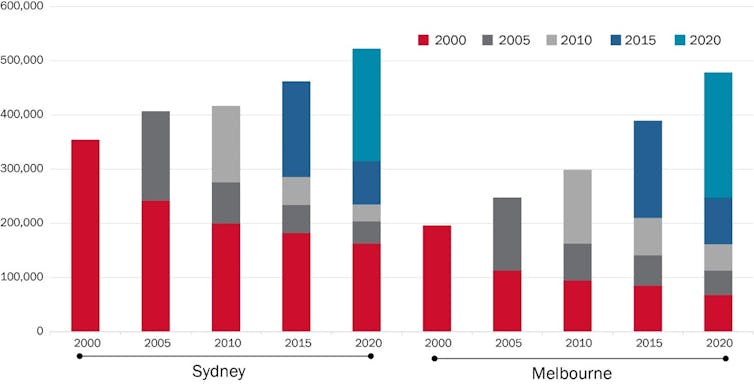
More than 30% of tenancies begin in a property that’s new to the rental sector. And more than 25% of tenancy terminations happen when the property exits the sector.
Our investor survey also shows the sector’s dynamism. Many investors made repeated investments, owning multiple properties and some interstate. They indicated strong interest in short-term letting, such as Airbnb, and significant minorities had used their properties for purposes other than rental housing.
Australia’s rental housing interacts closely with other sectors, particularly owner-occupied housing, as houses and strata-titled apartments trade between the sectors. The tax-subsidised property prices paid by owner-occupiers heavily influence investors’ gains and decision-making. Rental is also increasingly integrated with tourism, through governments’ permissive approach to short-term letting.
In short, the Australian rental sector is built for investing and disinvesting. As properties churn in and out of rental, renters are churned in and out of housing.
This presents problems for tenants.
A New Agenda For Tenancy Law Reform
Australian residential tenancies law has accommodated the long-term growth of the rental sector and its dynamic character. With no licensing or training requirements, it’s easy for landlords to enter the sector. It’s also easy to exit by terminating tenancies, on grounds they want to use a property for other purposes, or even without grounds in many cases.
Over the years tenancy law reform has fixed some problem areas, but with virtually no national co-ordination. Laws are increasingly inconsistent on important topics, such as tenants’ security (for example, some states have restricted, but not eliminated, no-grounds terminations), minimum standards and domestic violence. Reforms have overlooked significant problem areas, such as steep rent increases and landlords’ liability for defective premises.
It is time to pursue a national agenda that goes further than previous limited reforms. The focus should be on the rights of tenants to affordable housing, in decent condition, that supports autonomy and secure occupancy.
Where landlords say it is too difficult and they will disinvest, this should not be taken as a threat. Indeed, it would be a good thing if the speculative, incapable and unwilling investors exited the sector. This would make properties available for new owner-occupiers and open up prospects for other, more committed landlords, especially non-profit providers of rental housing.
Similarly, if we had higher standards and expectations to discourage private landlords from entering the sector, that would open up scope for new owner-occupiers and investors who are less inclined to churn properties and households.
While past tenancy law reforms have not caused disinvestment, maybe the next reforms should.
The authors acknowledge the contributions of their research co-authors, Professor Kath Hulse, Professor Eileen O’Brien Webb, Dr Laura Crommelin and Liss Ralston.![]()
Chris Martin, Senior Research Fellow, City Futures Research Centre, UNSW Sydney; Milad Ghasri, Senior Lecturer in Transport Planning, UNSW Sydney; Sharon Parkinson, Senior Research Fellow, Centre for Urban Transitions, Swinburne University of Technology, and Zoe Goodall, Research Associate, Centre for Urban Transitions, Swinburne University of Technology
This article is republished from The Conversation under a Creative Commons license. Read the original article.
Research suggests one way to prevent depression and anxiety is a strong sense of connection at high school

About one in five young Australians will experience a mental health problem like depression or anxiety each year. The COVID pandemic has only intensified mental health concerns in young people.
In Australia, decades of investment in early intervention and treatment services have not decreased rates of depression and anxiety. This has sparked more interest in what we can do to prevent mental health problems. Schools are ideal settings for prevention because you can reach large numbers of students, help build healthy skills and habits, and capitalise on schools being both learning and social environments.
Our new research suggests, one promising way to prevent depression and anxiety is by ensuring students feel a strong sense of belonging and connection to their high school.
What Is ‘School Connectedness’?
“School connectedness” is about the quality of engagement students have with their peers, teachers, and learning in the school environment.
It can include things such as, knowing teachers support them, having a friend to talk to about their problems, feeling like they can be themselves at school and like school is an enjoyable place to be, and actively participating in school activities.

School connectedness has been linked to better academic achievement and wellbeing. But it is now attracting attention as a possible way to protect against depression and anxiety.
However, existing research reviews have tended to look at cross-sectional studies (data collected at one point in time) rather than longitudinal studies (data collected over time). And they haven’t considered anxiety and depression specifically, making it difficult to determine if there is a preventative effect.
Our Research
In a new study, we investigated whether school connectedness prevents the onset of later depression and anxiety in 14 to 24 year-olds. We did this with funding from the UK charity, the Wellcome Trust as part of its push to identify innovative interventions for anxiety and depression.
We systematically reviewed ten years of evidence examining relationships between school connectedness and depression and anxiety. After screening 3,552 potential articles, we found 34 longitudinal and two intervention studies which met our inclusion criteria. The intervention studies measured the change in participants’ depressive symptoms before and after a program, compared to participants who did not receive the program.
We then summarised the findings from the included articles.
To ensure young people’s perspectives informed our review, we also partnered with five youth advisers aged 16 to 21 with lived experience of mental health problems and/or the schooling system in Australia, Indonesia, and the Philippines.
Our Findings
Most studies found higher levels of school connectedness predicted lower levels of depression and anxiety later. Most studies examined depression.
For example, United States one study of nearly 10,000 students found higher levels of self-reported school connectedness (questions included, “you feel like you are part of your school”, “the teachers at school treat you fairly”) led to reductions in self-reported depressive symptoms in the past week. This effect occurred both later in secondary school and persisted into early adulthood, even when accounting for previous depressive symptoms.
Another study investigated the effect of a whole-school health promotion program in over 5,000 secondary school students in India.
The program encouraged supportive relationships between members of the school community, promoted school belonging, increased participation in school activities, and promoted social skills among students. The study found this led to a reduction in depressive symptoms 17 months later.
Reflections From Youth Advisers
Our findings resonated with the experience of our youth advisers. For example, one 18-year-old adviser from Australia reflected,
I’ve had mental health issues my whole life […] I noticed the second that I moved schools to a more healthy environment, the rapid improvement of my mental health.
Another 18-year-old adviser from Indonesia explained,
Knowing your school is there for you really calms you down, takes one more thought out of your head, and more weight off your shoulders.
Most of the studies were from high-income countries, primarily the US, yet our advisers stressed the importance of cultural context. One 16-year-old youth adviser explained the importance of religion.
In Indonesia you can’t really dismiss religion. You can’t ignore it because it’s so deeply rooted in our society and that in turn reflects (on) other things like our mental health and even school connectedness.
Interestingly, we found one study reported higher levels of school connectedness led to higher levels of internal distress. Our youth advisers noted that sometimes feeling more connected to school can come with increased expectations from teachers and pressure to perform, which might increase anxiety in some students.
What Does This Mean For Schools?
Our findings show how schools matter for mental health and that fostering school connectedness might be a way to prevent depression and anxiety.
Existing research shows there are a lot of “little things” teachers can do throughout the day in their ordinary interactions with students to foster school connectedness.
This includes, actively listening to students, being available and accessible, advocating for students, encouraging students in their school work even if they are struggling, having empathy for students’ difficulties, and treating students like “humans”.
Students are also more likely to ask for help with their learning when teachers say hello, talk to them and take an interest in what they are doing, and show they are proud of them.
Our youth advisers reinforced the importance of feeling acknowledged by teachers and peers and that students need to be able to safely express their identity. One 16-year-old youth adviser from Australia explained that feeling connected to school has many parts.
You’ve got that social aspect, but you’ve also got extra-curricular activities, how you’re going through your studies, your classes […] it’s the positive emotions, it’s the relationships, it’s the meaning, it’s engagement, the accomplishment, it’s all of that. Once you feel supported in all these areas is when you feel connected.
Across the pandemic, school closures and remote learning have shaped a different appreciation of the significance of schools for mental health and wellbeing. The question now is how governments, schools and communities act on this information.
If this article has raised issues for you or your child, you can call Lifeline on 13 11 14 or Kids Helpline on 1800 55 1800.![]()
Monika Raniti, Research Fellow, Murdoch Children's Research Institute; Divyangana Rakesh, Postdoctoral research fellow, Harvard University, and Susan M Sawyer, Professor of Adolescent Health The University of Melbourne; Director, Royal Children's Hospital Centre for Adolescent Health, The University of Melbourne
This article is republished from The Conversation under a Creative Commons license. Read the original article.
Earth's Many New Lakes
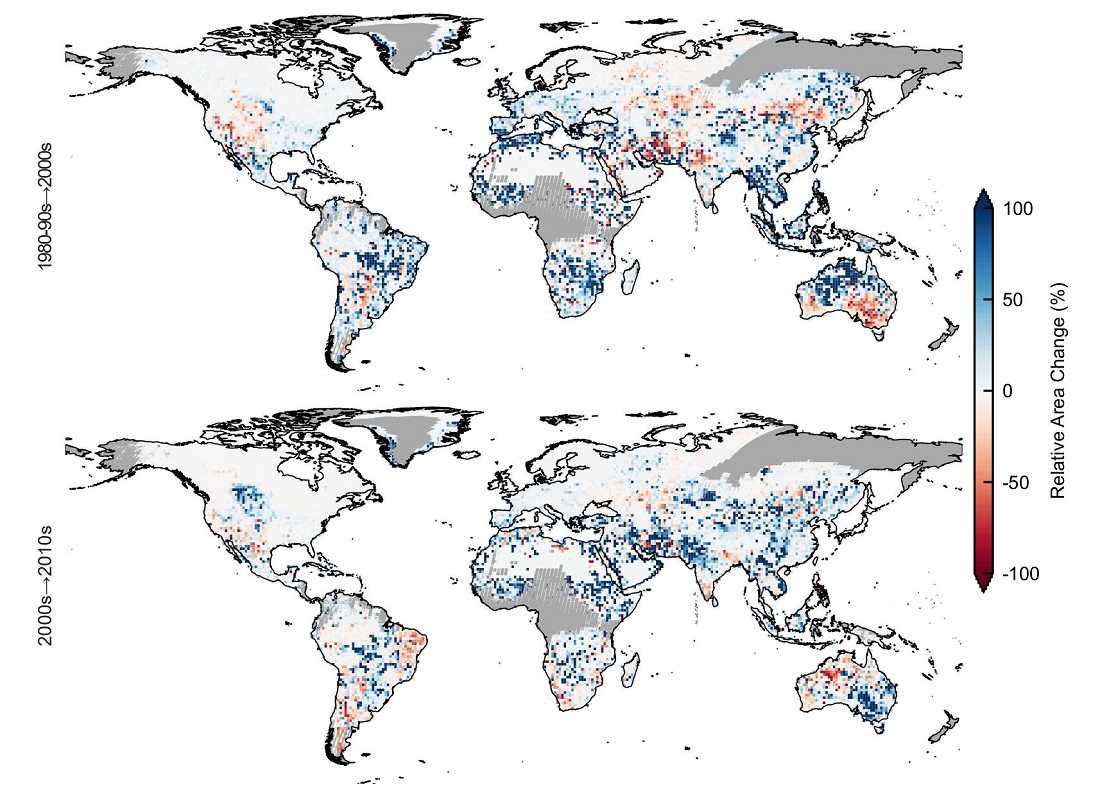
- In the study, researchers mapped 3.4 million lakes (with the lowest lake size down to 0.03 km2) and how their sizes developed between 1984-1999, 2000-2009 and 2010-2019.
- The GLAKES dataset constructed in this study is based on high-resolution satellite imagery and a deep learning algorithm. The dataset is publicly available.
- The research results have been published in the scientific journal Nature Communications.
- The first authors of the study are Xuehui Pi and Qiuqi Luo from Southern University of Science and Technology, Shenzhen, China and The University of Hong Kong, Hong Kong SAR, China.
- Yang Xu, Rasmus Fensholt and Martin Brandt of the University of Copenhagen's Department of Geosciences and Natural Resource Management also contributed to the study.
- 49.8% of the total global lakes and 23.6% of the global lake area lies above the 60th parallel north.
- Lakes created by melting glaciers or thawing permafrost make up 30% of the world's lake area. Hotspots for these types of lakes include Greenland, the Tibetan Plateau, and the Rocky Mountains.
- Also observed during the period under review, were lakes that shrank due to drought and the consumption of water resources, among other things. These were observed across the Western US, Central Asia, Northern China, Southern Australia and elsewhere.
525-Million-Year-Old Fossil Defies Textbook Explanation For Brain Evolution


New Green Revolution Gene Discovery Sows Hope Of Drought Resilient Wheat
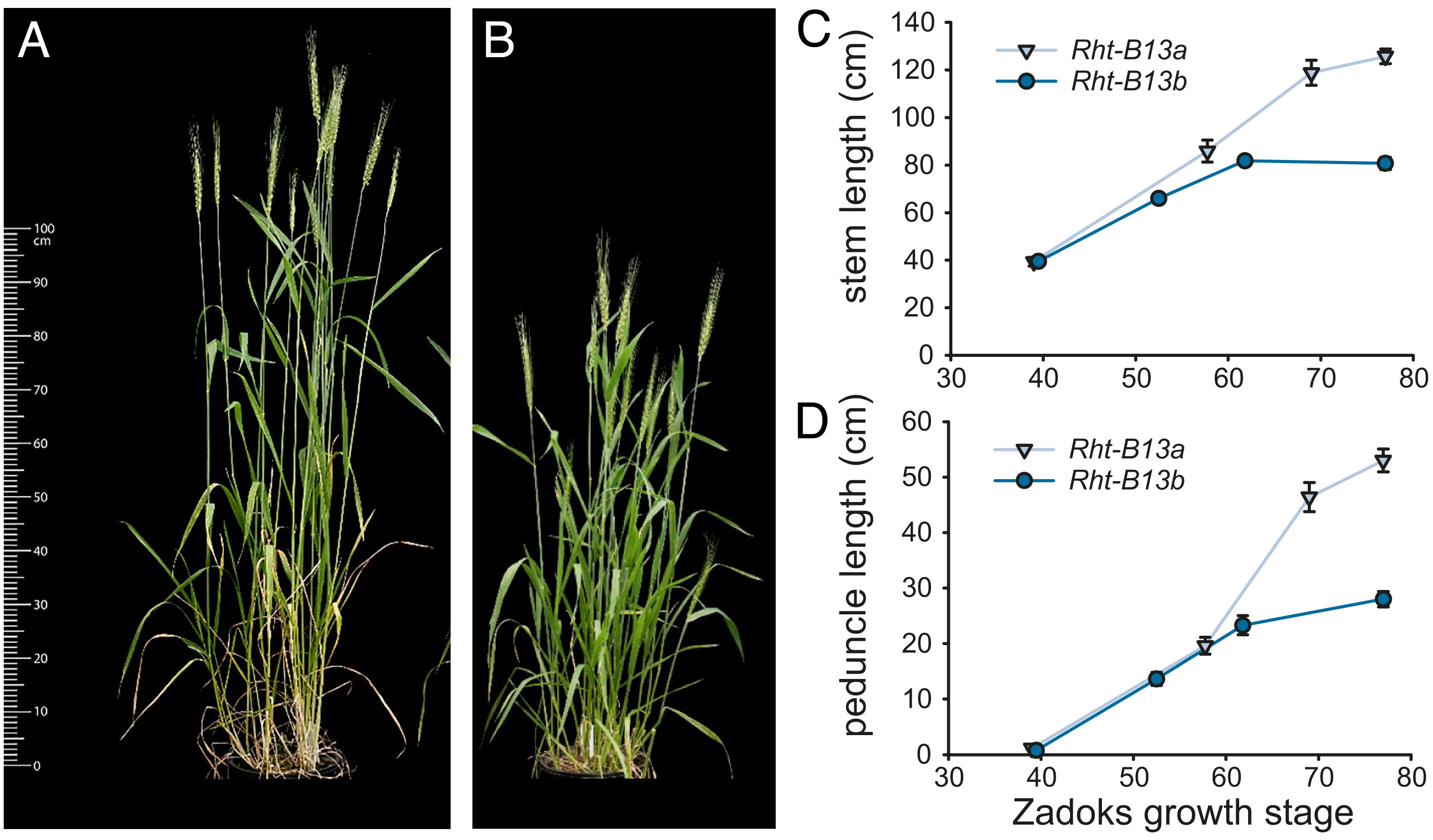
When Cyclones And Fires Collide: Severe Weather Events That Cause Extreme Havoc
Disclaimer: These articles are not intended to provide medical advice, diagnosis or treatment. Views expressed here do not necessarily reflect those of Pittwater Online News or its staff.